Wanting to See Duse
or, on Goshka Macuga's Preparatory Notes for a Chicago Comedy (2013 - ongoing) inspired by Aby Warburg-as-Amateur-Playwright (1893-1897)
Emily Verla Bovino
Abstract
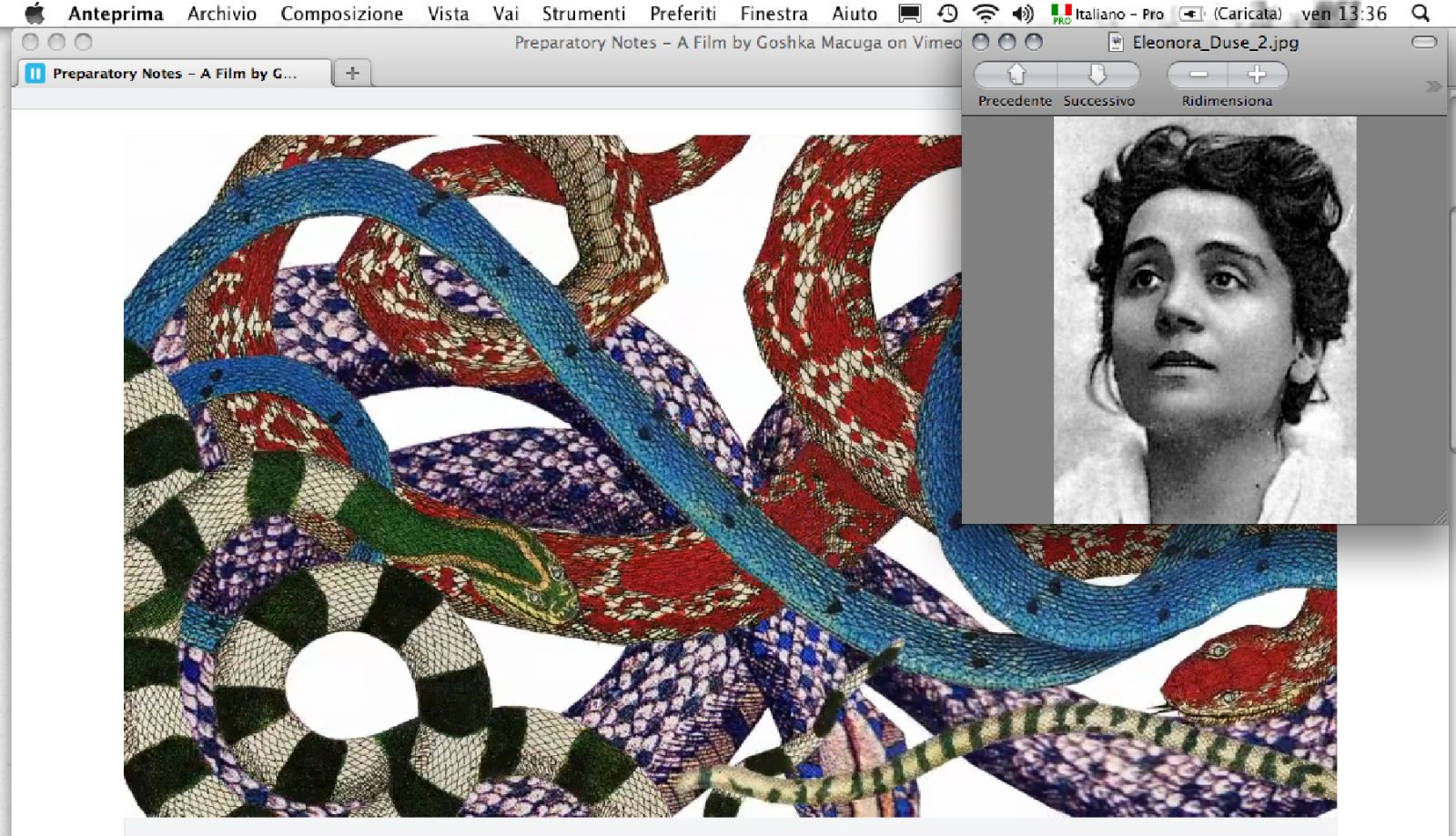
1 | A screenshot of the author’s computer screen with a digitized photograph of the Italian actress Eleonora Duse (1859 – 1924) watching the concluding credits of the performance-film Preparatory Notes for a Chicago Comedy (Goshka Macuga, 2014).
INTRODUCTION
Delaying Research to Write through Intervals, or Warburg’s 1893-1894 Playlet on an Eleonora Duse performance
You offer a part to (…) an enthusiastic beginner. She reads it
devoutly, and forms, say, half a dozen great ideas as to points
which she will make. The difficulty then is to induce her to do
nothing between these points, so that the play may be allowed at
such moments to play itself. Probably when it comes to the
point, these intervals will prove the only effective periods during
her performance, the points being ill chosen or awkwardly
executed.
The majority (…) never get beyond learning not to invent new
points for themselves but rather to pick out in their parts the
passages which admit of certain well worn and tired old points
being reapplied. When they have learned to make these points
smoothly and to keep quiet between whiles with a graceful air of
having good reasons for doing nothing, they are finished actresses.
The great actress has a harder struggle. She goes on inventing
her points and her business determinedly, and constantly
executing them with greater force and smoothness. A time
comes when she is always making points, and making them well;
and this is the finishing point with some (…).
But with the greatest artists there soon commences an integration
of the points into a continuous whole, at which stage the actress
appears to make no points at all and to proceed in the most
unstudied and “natural” way. This rare consummation Duse has reached.
- George Bernard Shaw on Eleonora Duse, 1895 (Shaw, Two Plays, 1895, 756 - 758)
It would be absurd, nonsensical, wholly preposterous “unreason” [Unvernunft] [1] to compare a performance by the great nineteenth century Italian actress Eleonora Duse (Vigevano, 1859 – Pittsburgh, 1924) to Polish-British artist Goshka Macuga’s Preparatory Notes for a Chicago Comedy (2013 and ongoing) [2]. And yet, there are aspects of George Bernard Shaw’s description of Duse’s “unstudied and “natural” way” of “making points” that resonate curiously with Macuga’s Chicago Comedy and its comic exploration of recent art world fascination with the figure of historian Aby Warburg (Hamburg, 1866 – 1929). Inspired by the young Warburg’s experiments with amateur playwrighting and the older Warburg’s Mnemosyne picture-series [Bilderreihe] atlas-project, Macuga’s Chicago Comedy stages the emergence of Warburg-as-schizoid-cultural-icon as symptom, or rather a problem of energy that has emerged amidst competing afterlives of images. The competition, as it is staged in the Chicago Comedy, is among twenty-first century images as they are lived and relived intensely and intimately through 'pins' and 'likes' across the Internet’s various iterations of the social media image-dump, from Pinterest (the so-called “visual discovery tool”) to Instagram (the mobile photo and video-sharing site with its selfie ‘stars’) (Fig. 1(A))

1(A) | Author's screenshots from “Aby Warburg” search on Pinterest (left) and #AbyWarburg on Instagram (right).
The following essay is a whirlpool of words and images designed to submerge the reader in the experience of what Warburg called his “eel soup style” [Aalsuppenstil], an approach best described as characterized by its “density of elements, their composite heterogeneous character never completely ascribable to an unicum, so that representation is always evasive, never ‘digestible’ once and for all” (Barale, 2009, 94). Part One of the essay begins with a deep breath and ends with an opportunity to come up for air; Part Two is conceived as a release from the vortex of spinning currents introduced in Part One and looks to use the feeling of drowning induced by these currents to provide new insight into what Warburg’s early experiments with amateur playwrighting might teach us about the way he understood the relationship between bodies, objects, worlds and the symbolic. The purpose of the essay is to explore what Warburg, the self-proclaimed psycho-historian, called “the ‘corporalization’ of sensorial impressions” [Die ‘Verleibung’ des sinnlichen Eindrucks], and to do so by writing about “corporalization” while writing through it. Over the course of the essay, points-of-reward are tactically timed and positioned to encourage those who allow themselves to be overtaken by the coiling nested looping of Warburg’s “eel soup style” and elliptical dialectic, to continue the swampy swim.
As was the case with many of his peers, the young Warburg was inspired by the modernist language of gestures developed by the great Italian actress known to her admirers as “Duse”. In 1894, Warburg exchanged gossip with his mother about Duse’s involvement with writer Gabriele D’Annunzio; he sent his sister Olga a picture of Duse, and Olga wrote back to him with descriptions of a sketch of Duse’s head made by Warburg’s friend and future wife, Mary Hertz; when Olga saw Hertz’s drawings she wrote to her brother that she wanted to give Hertz the gift of Thomas Carlyle’s book On Heroes, Hero-Worship and the Heroic in History (1840) [3]. For Carlyle, hero-worship was the product of an “allegory” made “sportful shadow,” a “cloud field” of “Nescience, whither we can never penetrate, on which all science swims as a mere superficial film” (Carlyle, 1840, 11).
Between 1893 and 1894, after Warburg published his now oft-cited dissertation on “accessories-in-motion” [bewegtes Beiwerk], he worked on fragments for a comedy titled Als ein junges Mädchen die Duse sehen wollte (When a well-brought up girl wanted to see a Duse performance, 1893-1894) in which he appears to have attempted to use what we might call the ‘Nescience’ of amateur playwriting to explore the ‘cloud field’ of Duse as hero and counter-hero. In the present essay, we will play the part of the ‘well-brought up girl’ wanting to see Duse while watching a Chicago Comedy: here is how.
According to Ernst Gombrich’s 1970 intellectual biography of Warburg, “the case against such a [well-brought up] girl being seen at [Duse’s performance of] La dame aux camélias [Lady of he Camelias] is argued at least with apparent conviction [by Warburg in his playlet]” (Gombrich, 93). Warburg’s 1893 dissertation on “accessories-in-motion” had concluded with Warburg asserting that Sandro Botticelli (Florence, 1445 - 1510) was an example of the “all too pliable” [die allzu biegsam] fifteenth century artist in Florence whose “lack of mature artistic discretion” [dem Mangel Künstlerischer Besonnenheit der bildenden Künstler] had “led to the unthinking repetition of superficially agitated motifs of motion” [gedankenloser Wiederholung äußerlich gesteigerter Bewegungsmotive] (Warburg, [1893] 1999, 141; Warburg [1893] 1932, 55). If we recall this conclusion while reading Shaw’s polarity of performance aesthetics between the Italian Duse and the French Sarah Bernhardt (Fig. 1(B)) – between the “modernism” of the former and the “traditionalism” of the latter, between the “natural way” with “points” in the former, and the “cajoling,” “harrowing”, “exciting” and “fooling” “living picture” of the latter – it is difficult to believe that expressing a “conviction” was all Warburg was after in his playlet on Duse (Shaw, Duse and Bernhardt, 1895, 787-788). Something about Duse’s unique approach to gesture – her famed ability to naturally blush on cue – lay behind Warburg’s idea to stage good-society debates about what Shaw called Duse’s “intellectual work” (Shaw, Duse and Bernhardt, 1895, 789; Shaw, Two Plays, 1895, 758).
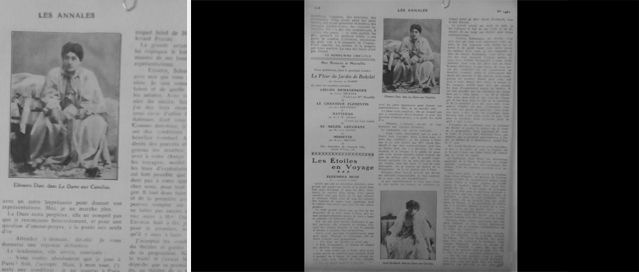
1(B) | Screenshot with detail of Les Annales article (1911) comparing Eleonora Duse's performance of La dame aux camélias with Sarah Bernardt's interpretation: the article was selling for auction on French ebay at the time of the publication of the present Engramma issue (no. 130, November 2015).
In 1897, two months after Warburg cast his family in a performance of the second playlet he authored, Hamburger Kunstgesprache (Hamburg Art Conversations, December 1896) (Russell 2006, 1), he attended a Duse performance of La Dame aux Camelias [“Cameliendame”] [4]. There does not appear to be evidence that Warburg attended any other stage adaptations of Alexandre Dumas’ novel prior to 1897; it is, therefore, altogether plausible that his fragments for the Duse playlet may have been based on his sociological interest in reviews of Duse’s performances like Shaw’s [5]. In fact, in 1894, while Warburg was working on the fragmentary draft for his Duse playlet, he wrote to his mother Charlotte about hearing a Duse concert, commenting that he “rarely look[ed] at paintings” anymore and was “developing into a book lover” [6]. It appears that while he worked on the playlet, Warburg, known for his all-consuming ‘looking’ and penetrating gaze, was going through a phase of intensive reading-as-looking.
In another letter, after sharing his enthusiasm with future wife Mary Hertz (Fig. 1(C)) about Duse’s version of Camelias, Warburg commented on his fiancée's own “performance”, or rather, Hertz’s restraint on the eve of a family wedding party. In his letter to Hertz, Warburg apologizes for a “situation” he calls “unnatural” [7]. Likely an allusion to their relationship strained by family tensions over religious difference – Warburg was Jewish and Hertz’s family had converted to Protestantism – the contrast of the couple’s ‘unnatural situation’ with Warburg’s praise of Duse’s modern naturalist performance, indicates Warburg may have felt that something in Duse’s gestures was an expression of broader socio-symbolic concerns.
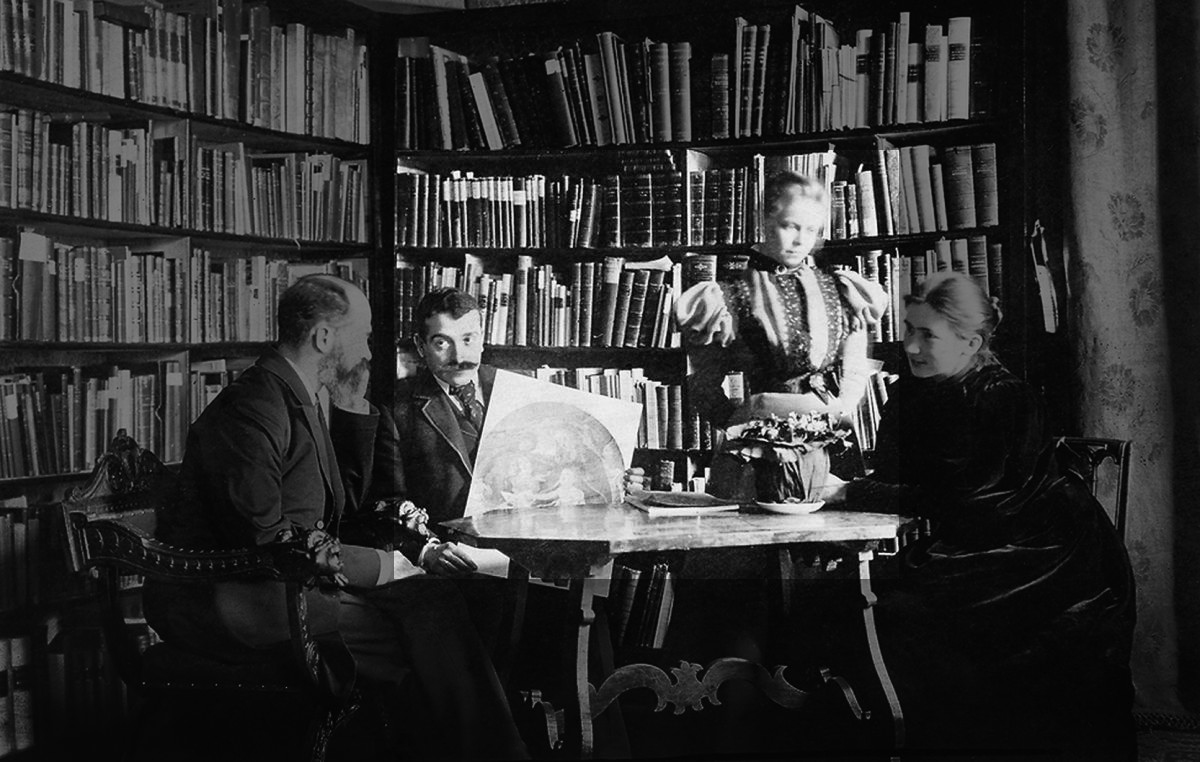
1(C) | The author's altered version of a digitized photograph of the young Warburg and Hertz; the center has been digitally illuminated (Source of original image: New Yorker magazine print, image from the Warburg Institute Archive, march 2015).
The twenty-first century amateur playlet Preparatory Notes for a Chicago Comedy (2013 and ongoing) by artist Goshka Macuga (Warsaw, b. 1969), co-scripted with curator Dieter Roelstraete, explicitly defines itself as a twenty-first century re-visitation of Warburg’s second attempt at amateur dramaturgy – his New Year’s Eve playlet, Hamburger Kunstgesprache (Hamburg Art Conversations, December 1896) (Gombrich, 93). This second playlet was written after Warburg’s American travels (1895–1896), following his abandoning work on fragmentary drafts for his first playwrighting experiment, the Duse playlet (1893–1894). Macuga's Chicago Comedy could be said to be a dramaturgy combining what Warburg called ‘unnatural’ situations with what Shaw called Duse's ‘natural’ poses: in its own words, the script of Macuga and Roelstraete's Chicago Comedy claims to play on the “snooping”, “spooking” and “spying” in an aesthetics of art driven into the cyber ‘cloud’ underground – what its own amateur playwrights, Macuga and Roelstraete, refer to as “art by under sea cables” in art by internet, “Art by Skype” “or Art by Email” (Macuga and Roelstraete, 2013, Scene One) [8]. Macuga and Roelstraete’s dramaturgy is, as they define it, “based loosely,” in true humorist-citationalist style, on a combination of Warburg’s Hamburg Art Conversations (1896) and the late modernist, early contemporary, exhibition Art by Telephone (1969) (Macuga and Roelstraete, 2013, Preface). The latter (Fig. 1(D)) is a recently rediscovered event of institutional history exhumed from the archives at the Museum of Contemporary Art Chicago (MCA) where Chicago Comedy was produced by Macuga as part of a residency program (2013). Other performances appropriated in the mash-up mixer of piracy and plagiarism that produced Macuga's Chicago Comedy, include: Marina Abramovic with Ulay and a snake in Three (1978) (Fig. 1(D)); Abramovic in Nude with Skeleton (2005/2005/2010); Andrea Fraser’s sex-tape with a collector, Untitled (2013); an oriental rug stolen from an acquaintance’s home on Richard Artschwager’s instruction (Art-by-Telephone, 1969); and Bjarne Melgaard’s “neo-gothic phantasmatic impersonations” (Lev, 91) specifically the sculpture Chair (2013) from the series Allen Jones Remakes (2013).
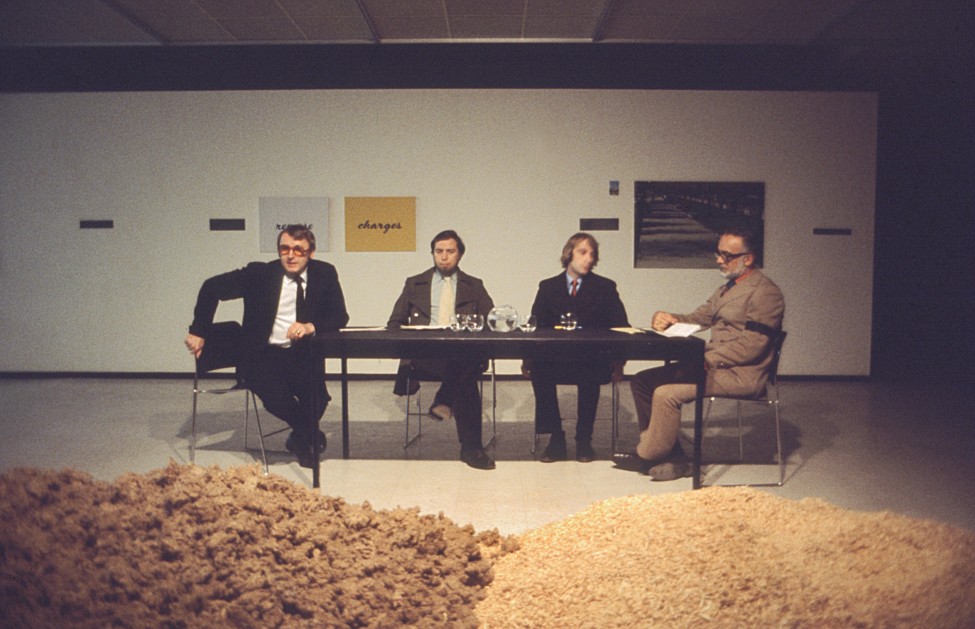
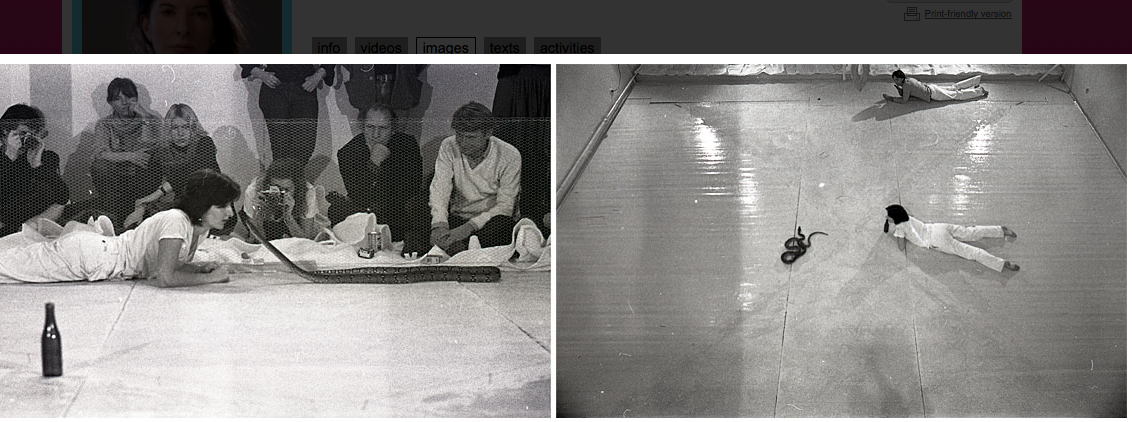
1(D) | (top image) Museum of Contemporary Art Chicago Art by Telephone exhibition panel discussion, November 13 1969: MCA director Jan van der Marck, who features as a character in Macuga's Preparatory Notes for a Chicago Comedy (2013 - 2014), is on the left; (bottom two images) Screenshot of photographs from the Harlekin Art, Wiesbaden performance of Three (1978) with Marina Abramovic, Ulay and snake, from the Art21 image database (Source: The Marina Abramovic Archives).
Macuga's Chicago Comedy is introduced by one half of the caricature of a split Warburg – Warburg 1 – played by a middle-aged actor with an affected German-Jewish accent. Warburg 1 gives the Chicago Comedy his blessing as a “play meant to be playful (…) based loosely on an existing piece of amateur literature,” Warburg's own Hamburg Art Conversations (also referred to by scholars as Hamburg Comedy) (Macuga and Roelstraete, 2013, Preface). To comment on this early twenty-first century 'play' with Warburg’s 1897 Hamburg Comedy, we will take our own 'playful' deconstructionist approach: the present essay will discuss Macuga's Chicago Comedy through what we will agree to believe may have been Warburg’s earlier 1893 ideas for a playlet on late nineteenth-century hero-worship of Eleonora Duse and debates over her gestures (Fig. 1). The present essay is thus also 'loosely based': loosely based, that is, on our own ideas about the consequences that Warburg imagined would ensue from one girl’s desire to see a play – what transpired “when a well-brought up girl wanted to see Duse?” For our purposes, we have abbreviated the title of Warburg’s never completed playlet as an expression of our own desires: Wanting to see Duse. It is, first, the expression of a desire that could possibly be realized, that is, wanting to see Duse appear in a future performance of Macuga’s Chicago Comedy. Second, a desire that will always be perpetually frustrated: wanting to see Warburg shape his fragmentary notes for a Duse playlet into an actual performance.
In Macuga and Roelstraete’s script for Chicago Comedy, the split caricature Warburg 1 defines the Chicago Comedy he is featured in as “the real science fiction deal”, a “plunge” into grey space – “the grey area (…) between reason and unreason”: an exploration of transposing temporalities and superimposing places (Macuga and Roelstraete, 2013, Preface). To this description of the play by a split-half of its central protagonist, our essay adds what scholars of Warburg’s work refer to as the “interpos[ing] of symbols” to construct distance [9]. Rather than privilege subjectivity in the kind of politics of identity that has been described as a Warburgian “inter-imaging” in Macuga’s work – a “relations between-images” in which “images address their viewers in ways that may potentially lead to the rethinking of one’s roles as a spectator and a citizen” (Dâmaso 209) – we will think about Macuga’s work through Warburg’s object-oriented model of interposing subject and substance: the “‘artistic’ act” [“künstlerische” Act] as the problem of energy in the middle of inter-object relations (Warburg, 305 and 306, March 1896). In particular, we are interested in exploring the way the ‘points’ and ‘intervals’ of Internet image wormholes can be handled and manipulated to indirectly sculpt and shield the unconscious. In the present essay, we attempt to outline how Macuga's Chicago Comedy, to use Warburg’s terms, “corporalizes” [Verleibung] (Warburg [January 1896] 2011, 107) [10] the mythologization of technology ritualized between bust and boom, between crisis and exhuberance, between what, in Scene One of Macuga and Roelstraete’s dramaturgy, Warburg 1 – speaking from between the face-framing movements of vogue-ing dancing twins (Fig. 1(E)) – quotes Warburg as referring to as extermination or intoxication [“extermination (and whiskey)”], and the technocratic vision of “the forces of nature (…) as an endless succession of waves, obedient to the touch of a man’s hand” [11].

1(E) | “The forces of nature (…) as an endless succession of waves, obedient to the touch of a man’s hand”: The actor who plays Warburg 1 in Macuga's Preparatory Notes for a Chicago Comedy reading extracts from Warburg's posthumously published A Lecture on Serpent Ritual (Warburg [1923] 1939. 292). Screenshots taken of the author’s computer screen while watching a Vimeo upload of the performance-film version of Preparatory Notes for a Chicago Comedy (Macuga and Roelstraete, 2013-2014).
Warburg's phrase “the ‘corporalization’ of sensorial impressions” [die “Verleibung” des sinnlichen Eindrucks] is from a now oft-cited note he wrote while traveling in New Mexico, and later included his Grundlegende Bruchstücke project (in English, Foundational Fragments, 1888 – 1903) (Warburg [January 1896] 2011, 107) (Ghelardi, 47) [12]. In the note dated January 27 1896, Warburg writes of “corporalization” [“Verleibung”] as the “expression of [a] psychological law” [Ausdruck für mein psychologisches Gesetz] (Warburg [January 1896] 2011, 107). This “expression” of a “law” helped him to observe the ways that socio-symbolic mediation alters the realities of bodies – how bodies achieve socio-symbolic dis-affection (or affective distance) by moving through subject and object positions in “incorporation” [Einverleibung], “corporal introjection” [Hinein[Um]verleibung], “corporal annexation” [Anverleibung] and “corporal addition” [Zuerleibung] (Warburg [January 1896] 2011, 107). For Warburg, the gap between “the world of inner questions” [Welt der inneren Fragen] (Warburg [1929] 2008, 25) and the “outer world” [Aussenwelt] of “forms” [Formenwelt] (Warburg [January 1896] 2011, 107; Warburg, [1929] 2000) was always under threat of being compromised, because no matter how repulsive images are to a viewer, they “affect (…) imagination like a kind of yeast” (Warburg [1923] 2004, 309) [13].
Our response to watching Macuga's Chicago Comedy must, therefore, be empathetic and thus focuses on the economy of energy in this ‘kind of yeast’ as it takes form in the information age. To accomplish our empathetic reading, we compose our own form of ‘science fiction,’ and rather than immediately consult Warburg’s archives, we work within a delay, or what Marcel Duchamp called the “try[ing] to argue on the plastic duration” (Fig.1(F)) (Duchamp, [1912-1920] 1973, 77): we choose to begin our inquiry by only imagining what we think Warburg might have attempted with his unfinished playlet on Duse. We thus permit ourselves a moment of play in the space between research and art, delusion and daydream. We base our discussion of Warburg's experiments in his Duse playlet on our knowledge of Warburg’s work, and on our readings of what Warburg’s contemporaries identified as ‘modern’ in Duse’s performances. In this transitional moment that we have chosen to write through – this moment between not knowing anything about Warburg’s Duse playlet, and perhaps, at some future moment, reading its fragmentary draft at the Warburg Institute Archive – our principle focus is on the two pathos-formula [Pathosformeln] (Warburg [1905] 1999; Warburg [1905] 1933) that we have identified in Shaw’s analysis of Duse's “modern” performance: first, the “unstudied and natural way” of “making points,” and second, the “effective” way of “doing nothing” with “intervals” (Shaw, Two Plays, 1895, 756-758). These Pathosformeln are explored in both the content of our present essay and its form.

1(F) | Author's performative lecture slide (right) on Marcel Duchamp's drawing Try to Argue on the Plastic Duration (1912 - 1920). Screenshot of overlay animation (left) on cutout of Marcel Duchamp from the performance-film of Macuga's Preparatory Notes for a Chicago Comedy (2013 - 2015).
In his 1905 essay on Albrecht Dürer’s Death of Orpheus (1494), Warburg defined the Pathosformel as an abstraction of emotion that “stood for (…) passionately and knowingly felt experience” [ein wirklich im Geiste und nach den Worten der heidnischen Vorzeit leidenschaftlich und verständnisvoll nachgefühltes Erlebnis], “more than a studio motif of purely formal interest” [nicht nur ein rein formal interessantes Ateliermotiv] (Warburg [1905] 1999; Warburg [1905] 1933). In the present essay, we focus on an example of “passionately and knowingly felt” dispassionate disaffection: Macuga’s Chicago Comedy.
In the case of Dürer’s drawing (Fig.1(G)), the Pathosformel was the creation of an unresolved problem in-between: “an animated image” [Temperamentsbild] in the “unresolved composite [unausgeglichenen Mischstil] between realistic observation” [zwischen realistischer Naturbeobachtung] of “idealizing” “familiar (…) sources” [und idealisierender an berühmte (…) Muster], and a “more consistent style” [einheitlicheren (…) Stil], a “sheer exuberant rhetoric of muscle” [seine überlebendige Muskelrhetorik] (Warburg [1905] 1999; Warburg [1905] 1933). Ultimately, according to Warburg, this Pathosformel managed to avoid “decorative and emotive rhetoric” [dekorative Pathos] with “a coolness” [Widerstand], an “overtone (…) of robust composure” [ein Oberton ruhiger Widerstandskraft mitteilt] (Warburg [1905] 1999; Warburg [1905] 1933). The present essay asserts that Macuga’s Chicago Comedy is a doubling-redoubling reformulation of this formula as it was articulated by Warburg.

1(G) | Vernichtungspathos (...). Freiwerden des Pathos (Pathos of annihilation (...) energetic release of Pathos) (Warburg's notes accompanying Mnemosyne, Plate 41): detail from Plate 41 (left) of Warburg's Mnemosyne (1924 - 1929); Detail from the engraving at the Hamburg Kunsthalle attributed to a Ferrara master (c. 1470 - 1490) (center) which Warburg wrote about in Dürer and Italian Antiquity (1905); detail from Albrecht Dürer's Death of Orpheus (c. 1465), discussed by Warburg in the same 1905 publication (Source: Warburg Institute and Hamburger Kunsthalle).
In the same 1905 essay, Warburg’s discussion of the Pathosformel leads into his definition of the “outward symptom” [äußere Symptom] (Warburg [1905] 1999; Warburg [1905] 1933). For Warburg, the “outward symptom” is an emergent phenomenon that results from the sedimentation of Pathosformeln: the 1506 “unearthing of the Laocöon [also called Laocöon and his Sons, c. 17 – 68 AD, and generally considered a copy of a Greek original]” [die Entdeckung des Laokoon] was, for Warburg, “an outward symptom of an inward, historical process” [das äußere Symptom eines bedingten stilgeschichtlichen Prozesses] one that “marked (…) [a] zenith, not [an] onset” [steht im Zenit nicht am Anfang der “Barocken Entartung”] (Warburg [1905] 1999; Warburg [1905] 1933). This Zenit or “zenith,” “long sought” [längst (…) gesucht] through the process of gathering Pathosformeln, in turn created the conditions of possibility for the “long sought” to be “therefore found” [deshalb gefunden hatte] (Warburg [1905] 1999; Warburg [1905] 1933). In this account, the Pathosformeln are the way in which social memory prepares for “unearthing” [Entdeckung], or the accidental discovery of something not known, but desired.
But how is it possible to desire something unknown, and then to seek this something that is unknown but desired? Shaw’s review of Duse’s performance aesthetics provides us with an example of Pathosformeln that make the very process of what Warburg called “unearthing” [Entdeckung] – and what Shaw calls “consummation” – into the archeological discovery of its own action: in other words, the symptom unearthed is the act of “unearthing” itself.
This is the movement that Polish dramaturgist Jerzy Grotowski (Rzeszów, 1933 – Pontedera, 1999) described as the difference between “impulse” and “action”: according to Grotowski, the impulse is what “precedes physical actions, always” – it is the “still almost invisible” that “do[es] not appear yet but [is] already in the body, because [it] is ‘in/pulse’” (Grotowski [1986] 2004). Grotowski asserted that it was possible to develop a training (Fig.1(H)) that permitted the actor to work on “this fragment alone with an imaginary partner”: “I do only the starting point: the impulse to look (…). The impulse to lean, to touch (…) – but I don’t let it appear fully as an action, I am only starting (…) I move very little because it is only the pulsion of touching” (Grotowski [1986] 2004) [14]. The Pathosformel of “consummation” – the act of “unearthing” unearthed as symptom, or the pulsion between impulse and action – is of particular interest to us in relation to Warburg’s scholarship because the same qualities discussed by Shaw in his praise of Duse, are the values that historians have identified with Warburg’s own monumental composition of “points” (Bilderreihe or strings of image reproductions) (Warburg in Mazzucco [2006 – 2008] 2011) and “intervals” (Zwischenräumen or the spaces in-between, the connections among image reproductions) (Cieri Via [1994] 2014, 97; Warburg [1920] 1999; Warburg [1920] 1933): the atlas project Warburg called Mnemosyne (1924 – 1929) [15].
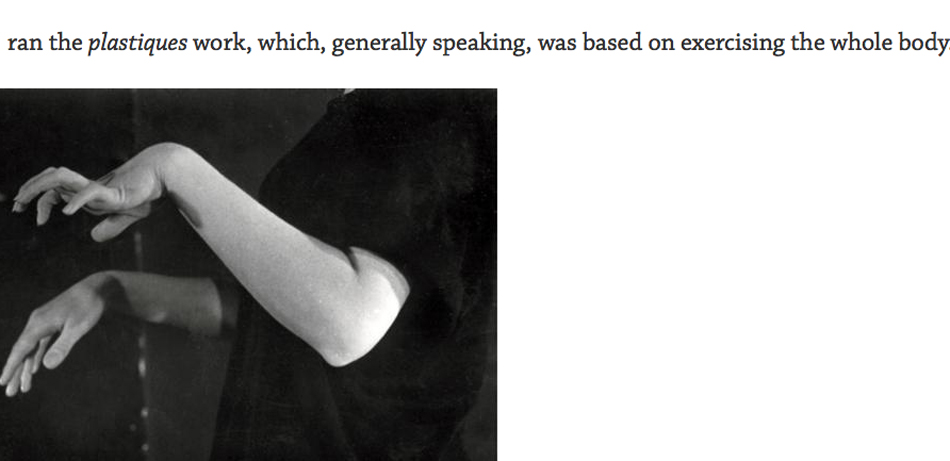
1(H) | Running the Plastiques work, or The impulse to lean, to touch (…) – but (...) don’t let it appear fully as an action (Grotowski [1986] 2004): Training exercises from Jerzy Grotowski's theatre (1965). Screenshot from Culture Hub reprint of interview with Maja Komorowska about her work at Teatr 13 Rzędów in Opole (Source: Grotowski Institute).
It is through improvisational play and consummating composition with ‘points’ and ‘intervals’ that Macuga's Chicago Comedy ends up unconsciously, but very deliberately and in a Mnemosyne-like staging, acting-out what Warburg called “corporalization” [Verleibung] (Warburg [January 1896] 2011, 107) : in its combination of sets, props, script and gestures, Macuga's Chicago Comedy is a comic atlas that, as its amateur dramaturgists describe it, is “one third choreography, one third performance and one third lecture” (Macuga and Roelstraete, 2013, Preface). And so, it is to this stage of a Hydra-headed performance monster that we summon the figure of Eleonora Duse as our interlocutor. With a digital image of Duse’s head in a preview window, we open a Vimeo upload of the performance film version of Chicago Comedy, shared with us by Goshka Macuga. The upload is a high definition video with animation overlay produced using footage of live performance at the 8th Berlin Biennale in 2014. Our focus in the ensuing essay is on movement and gesture in a comedy that ironically materializes the hyperspace of Internet image searches within the Euclidean white walls of the German national museum’s “ethnographic and non-European collections”, Berlin’s Museum Dahlem (Museen Dahlem, 2015).
Another guiding source of 'pulsation' for the present essay is the centrifuge of complex inter-objectifying inter-subjectivity Warburg outlined for himself in another note in the Grundlegende Bruchstücke two months after he wrote the oft-cited “corporalization” note in New Mexico (Warburg [March 25 1896] 2011, 109):
306
San Francisco Public Library 25.III.96.
Subjekt als Träger
Objekt der zeichnenden Kunst
die Linie
Objekt als getragenes
die plastische Kunst
der Umfang
306
San Francisco Public Library 25.III.96.
Subject as vehicle
Object of graphic art
line
Objekt as being-carried
plastic art
extension
It was between his two experiments with amateur playwriting – between When a well-brought up girl wanted to see a Duse performance, 1893 – 1894, and Hamburg Art Conversations, 1896 – that Warburg took his now oft-cited trip to the American Far West (1895 – 1896). It was this trip that led to his enthusiastic New Mexico discovery of the “expression” – “corporalization” – for what he called his “psychological law” (January 1896, Grundlegende Bruchstücke) (Warburg [January 1896] 2011, 107). Shortly after this discovery, in a visit to California and the San Francisco Public Library, Warburg wrote the above-cited note to himself, defining Subjekt (Subject) and Objekt (Object) as two forms of objectification: in the note, the “Subject” [Subjekt] position is the “object of graphic art” [Objekt der zeichnenden Kunst], a hybrid subject/object “as carrier” [als Träger] that is materially defined as “line” [die Linie]; the “Object” position, is a doubled object/object, the “object as the being-carried” [Objekt al getragenes], or “plastic art” [plastische Kunst] of “extension” [der Umfang] (Warburg [March 25 1896] 2011, 109).
How should we understand this San Francisco note in relation to Warburg’s earlier January 1896 New Mexico note on “corporalization” [Verleibung] – on Einverleibung (incorporation), Hinein[Um]verleibung (corporal introjection), Anverleibung [corporal annexation] and Zu-verleibung [corporal addition] (Warburg [January 1896] 2011, 107)? In the present essay, we read Warburg through Macuga's Chicago Comedy in order to propose that Warburg's lesser-known San Francisco notes on inter-objectification (Warburg [March 23 1896] and [March 25 1896], 2011, 109) be considered Warburg's definition of the energetic processes at work in Hinein[Um]verleibung (corporal introjection), the second of the four forms of “corporalization” [Verleibung] Warburg outlined in his oft-discussed note from New Mexico (Warburg [January 1896] 2011, 107).
PART ONE
Philia and Phobia in the “Ludic Drive” of Plasticism: Warburg’s “De-Demonization”
The dramaturgy, mise-en-scene and stage design of Macuga's Chicago Comedy are an endless web of embedded hyperactive hyperlinks replete with the potential for what Salvador Dali (circa 1930), and Rem Koolhaas (circa 1970) each called the “paranoid-critical” (Dali and Descharnes [1927 – 1933], 1998; Koolhaas, 1994). Koolhaas described Dali’s “paranoid-critical method” as “two consecutive but discrete operations”:
the synthetic reproduction of the paranoiac’s way of seeing (…) with its rich harvest of unsuspected correspondences, analogies and patterns; and the compression of these gaseous speculations to a critical point where they achieve the density of fact: the critical part of the method consists of the fabrication of objectifying “souvenirs” of the paranoid tourism, of concrete evidence that brings the “discoveries” of those excursions back to the rest of mankind, ideally in forms as obvious and undeniable as snapshots (Koolhaas [1994] in Hunt, 1999, 23).
Image-based social media are to some extent inherently “paranoid-critical”. Mundane life-tracking cultures on social media networks are the naturalization of “paranoid tourism”: they are “concrete evidence” of narcissistic delusion in the form of snapshots. These snapshots are not only instantaneously taken, but are also instantaneously shared on a global level, and, once shared, become an inescapably permanent presence online.
The paranoid-critical effect of Macuga's Chicago Comedy is, thus, necessarily raster graphics made ‘plastic’ – the linear-graphic made visuo-haptic – and the affect is an oscillating loop between philia and phobia, or what amateur playwrights Macuga and Roelstraete call “love” and “hate” (Macuga and Roelstraete, Preface, 2013): love of technology and manic euphoria over the material transcendence it seems to offer, and hate of technology and what love of it has made into its seemingly all-pervasive presence. In Chicago Comedy, the “love” and “hate” of the “Art World. Art. World [the world made art, the art-made world]” (Macuga and Roelstraete, Preface, 2013) is – to use Warburg’s terms from his famous exchange with André Jolles on the nymph figure – the “attempt posthumously to experience a time when the festive, ludic drive to create forms and artistic mimetic power “still (…) bloom[ed] grafted onto one branch(...)” [festlich spielender Gestaltungstrieb und kunstlerisch spiegelnde Kraft (…) auf einen Stamm geimpft blühen] (Warburg [1900] 2012, 103).
This is the same “drive” [Gestaltungstrieb] behind the desire for an Internet life of images to be made matter – for the ephemeral virtual “graphic” [Objekt der zeichnenden] to become the actual “plastic” [die plastische] (Warburg [March 25 1896] 2011, 109); for a synthetic high-resolution hyper-space in constant deformation and degradation, to become a tangible physicality – visible, touchable, wearable, audible – so that it could be physically handled, controlled, put together and taken apart (Warburg [March 23 1896] 2011, 109). The “love” and “hate” for “world” and “art” described inMacuga and Roelstraete’s script for Chicago Comedy drives the creation of an actual environment of ‘live’ digital contours whose edges the flesh-and-bone of fingers can run their tips along, whose forms bodies of dancers can prance around, and within which actors playing self-conscious caricatures can introject voices and gestures. The process that is staged is what Warburg referred to as “de-demonization” [Entdämonisierungsprozeß], a combined “mental and physical ingestion” [Einverseelung] [16]:
The de-demonization [Entdämonisierungsprozeß] process of the phobic stamped legacy of impressions, [der phobisch geprägten Eindruckserbmasse] which encompasses in gestural speech the entire scale of being emotionally moved and overwhelmed, from helpless despression to murderous cannibalism, contributes to the human dynamic of motion also in those states that lie between the limiting poles of orgy [Grenzpolen des Orgiasmus] – fighting, walking, running, dancing, grabbing [Kämpfen, Gehen, Laufen, Tanzen, Greifen]. This edge is stamped by uncanny experience [jenen Prägrand unheimlichen Erlebens] (…). The atlas for Mnemosyne wants to illustrate [illustrierten] this process through its pictorial material [Bildmaterialien], which one could call the attempt of spiritualizing and internalizing [Versuch der Einverseelung vorgeprägter Ausdruckswerte] previously stamped expressive values for the representation of life in motion (Warburg [1929] 2000; English translation from Johnson, 82).
As this quote from 1929 makes evident, Warburg intended that his atlas of image configurations, Mnemosyne, both “illustrate” [illustrierten] this “de-demonization process” [Entdämonisierungsprozeß] (Warburg [1929] 2000; English translation from Johnson, 82), as well as “corporalize” [Verleibung] it (Warburg [January 1896] 2011, 107). This, when Warburg assessed work on Mnemosyne by his collaborator Gertrud Bing (“Mnemosyne’s first hermeneut” (Johnson 2013, 222) he praised her as showing she was “capable of assimilating the entire world of art and of ingesting it spiritually [einzuverseelen] as a world of inner questions [Welt der inneren Fragen]” (Warburg [1929] 2008, 25; English translation from Johnson, 223).
How does Macuga's Chicago Comedy make this process of accumulating associations, tangible and material? One of the principle characteristics of Warburg’s Mnemosyne that differentiates it from other atlas projects of the same “atlas boom” [“Hochkonjunktur” von Bilder-Atlanten] (Zollner 2010, 287) is its use of mise-en-abyme embedding. Through the mise-en-abyme, Mnemosyne simultaneously exhibits and inhabits a middle space [der Mitte] in between [zwischen] what Warburg – in his 1896 San Francisco note from the Grundlegende Bruchstücke (Foundational Fragments) – called the “graphic” [zeichnenden] of “line” [Linie] and the “plastic” [plastische] of “extension” [Umfang] (Fig. 2) (Warburg [March 26 1896] 2011, 109). In Mnemosyne, this in-between [dazwischen] space is illustrated for the user of the atlas [or more precisely, what Warburg called his Bilderreihen (picture-series)] in the third prologue plate, Plate [Tafel] C. In Plate C of Mnemosyne, the stretched elliptical form of the Zeppelin airship (1929) is the plastic extension [der Umfang] of the non-Euclidean eccentricity postulated by Johannes Kepler in celestial orbits (1609), and visualized by him in both allegorical designs of drawings [zeichnenden Kunst; die Linie] and the plan for an ornamental object – a “punch bowl” – to be made from these drawings [die plastische] (Fig. 2, top left).
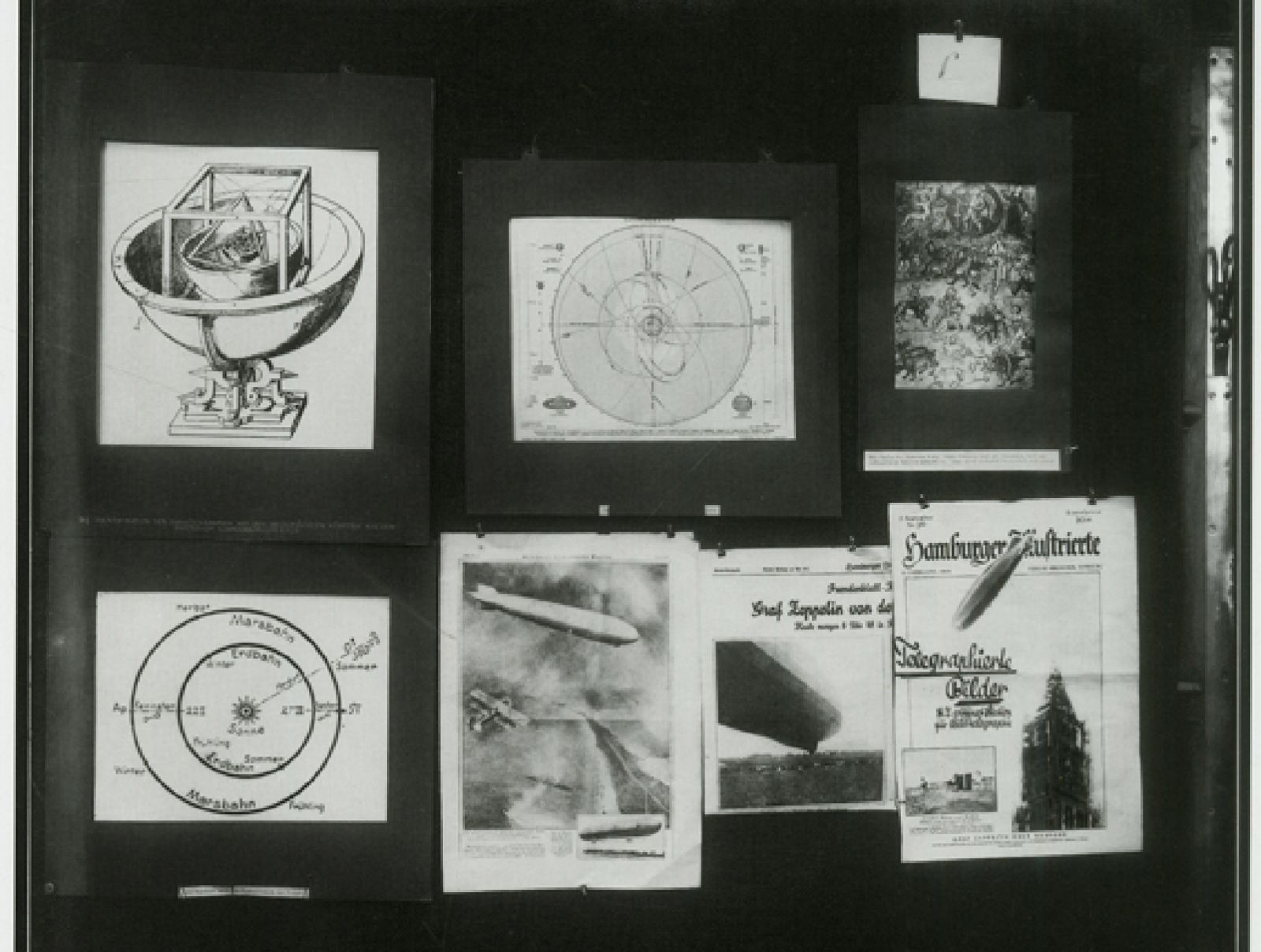
2 | Plate C from Warburg’s atlas, Mnemosyne (1924 – 1929) (Source: Warburg Institute Archive) featuring (upper left corner) Johannes Kepler’s model of distance relationships among the six planets known to astronomers at the time (1597, drawing signed Christophorus Leibfried. ff. Tubing. 1597); (left, lower left corner) a diagram of the orbit of Mars based on Kepler’s Astronomia Nova treatise on the ellipitical orbits of planets (1609), and (lower left corner) three newspaper clippings of the Graf Zeppelin airship over Germany, Japan and New York; The present essay connects this plate of the atlas to the March 1896 San Francisco notes by Warburg in his Grundlegende Bruchstucke: from Subject as being-carried - Object of graphic arts – Line [Subjekt als Träger / Objekt der zeichnenden Kunst / die Linie] to Object as being-carried – plastic art – extension [Objekt als getragenes / dies plastische Kunst / der Umfang] (Warburg [March 23 and March 251896] 2011, 109).
It has been alleged that the plan for Christophorus Leibfried’s drawing (1597) of Kepler’s model of distance relationships among the six planets known to exist at the time, was for it to be fabricated as a silver beverage dispenser for the Duke of Wurttemberg, “the sphere of each planet containing a different beverage dispensed through a network of pipes at the turn of a faucet;” the bowl was allegedly never realized because of difficulties in engineering its mechanisms. (Roberts 2006, 64). Even if this story is pure legend, the myth of transubstantiation of Kepler’s graphic model to a ‘plastic’ vessel holding beverage for “ingestion” [Einverleibung] (Warburg [January 1896], 2011, 107) is of interest. In Plate C of Warburg’s Mnemosyne, it would mean that from the left corner of the plate to the right corner of the plate, diagonal movement of the elliptical orbit would ‘extend’ [Umfang] (Warburg [March 1896] 2011, 109] from allegorical diagram to ornament, then from ornamental object to functional bowl for ‘ingestion,’ then from playful ‘punch bowl’ to the tragic stretched elliptoid of the ‘ingesting’ Zeppelin airship used to introject bodies to heavenly heights that had previously ruled over them from symbolic distance (Fig. 2 and Fig. 4 detail).
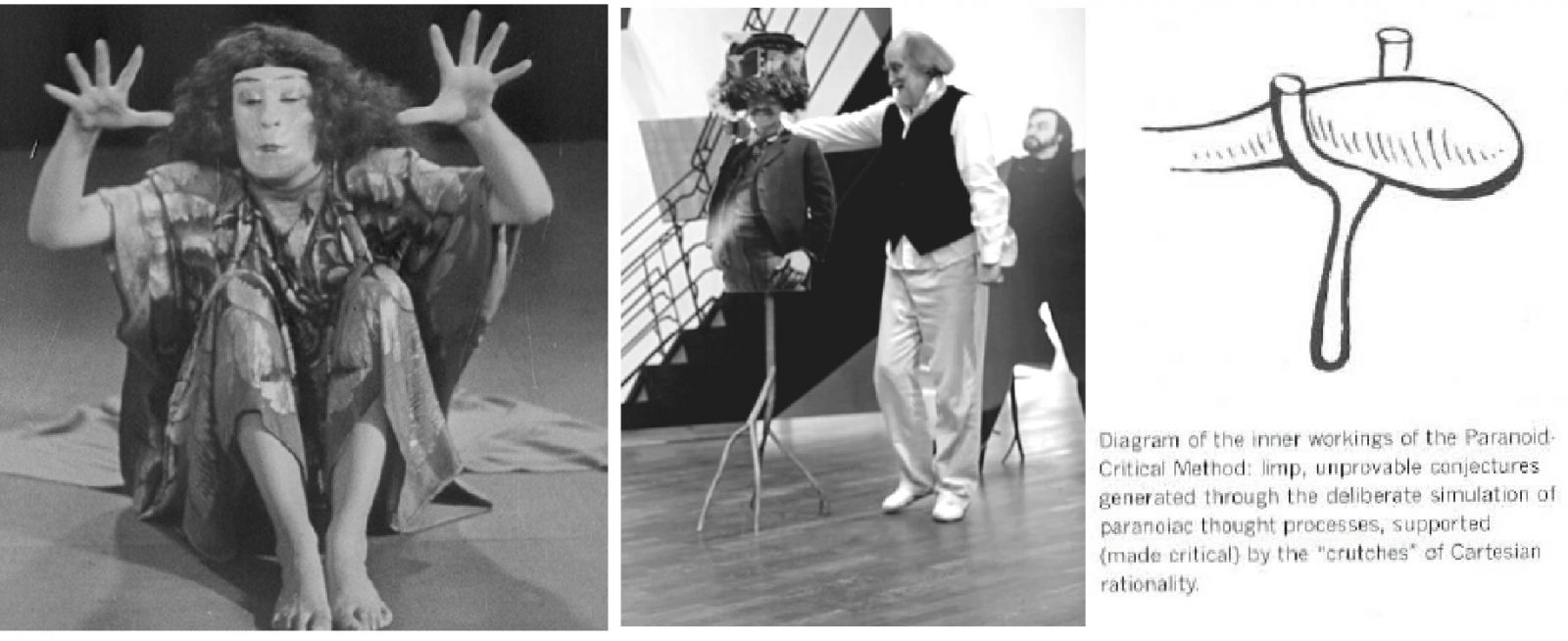
3 | The author-with-Duse association-idea: (left) Mary Wigman wearing a stylized mask of her own face while performing Hexentanz (Witch Dance, 1926) for filming in 1930 (Source: MOMA); (center) Chicago Comedy cut-out of Warburg-wearing-a-Hemis-Kachina-mask with the actor playing Warburg 2 standing behind (right, cut-out of curator Dieter Roelstraete, co-author of the Chicago Comedy script). (right) diagram of the paranoid-critical method by Salvador Dali as reprinted by Rem Koolhaas [Koolhaas [1978] 1996, 236) (Source: Koolhaas [1978] 1996).
Through a coincidence of happenstance events in the life of Warburg, this ‘extension’ [Umfang] (Warburg [March 25 1896] 2011, 109) of elliptical eccentricity can be extended even further into the body: in 1925, Mary Warburg wrote to her daughter Frede that she and Warburg would miss a performance by Mary Wigman (Fig. 2 and Fig. 3), but would go to see “the American film on the Zeppelin” (Fig. 2, in Plate C of Warburg's Mnemosyne) [18]. If Warburg had gone to the Wigman dance, would he have noticed that the elliptical arcs and spiraling trajectories Wigman diagrammed in her notations for group dances (Wigman 1973, 176) “corporalized” [Verleibung] (Warburg [January 1896] 2011, 107) the extension of the elliptoide from Kepler to Zeppelin that Warburg later articulated with image reproductions in Plate C of Mnemosyne? (Fig. 4).
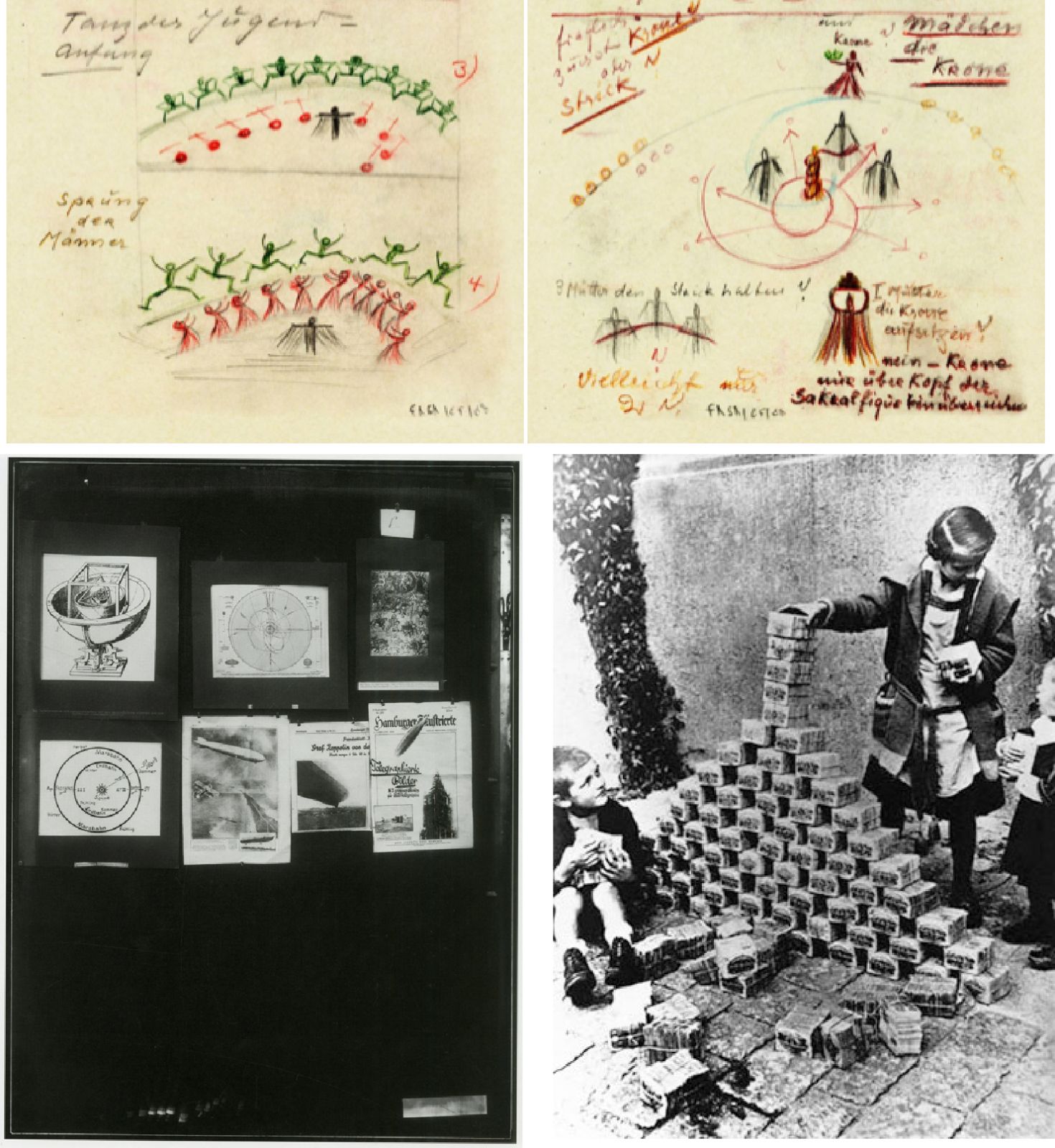
4 | The author-with-Duse association-idea: (top) Screenshot detail of Mary Wigman (Hanover 1886 – Berlin 1973) diagrams of Le Sacre du Printemps (1957); for more on Wigman association, read below (Source: Mary Wigman Foundation of the German Dance Archive Cologne) [17]; (bottom left) Plate C of Warburg’s atlas Mnemosyne, see below for detail (Source: Warburg Institute Archive); (right) An iconic image of hyperinflation in Weimar Germany from a recently published article on “semio-capitalism” (Berardi, 2011) (Source: E-Flux).
From Kepler’s “graphic” [zeichnenden] diagram and punchbowl for “ingestion” [Einverleibung], to the Graf Zeppelin’s “plastic” [plastische] elliptoide, and Wigman’s “corporalized” [Verleibung] spiraling arcs, Plate C is where Warburg both exhibits and inhabits his 1896 San Francisco note on the irresoluble problem of inter-objectivity: between the object-as-subject and the object-as-object, between the graphic and the plastic, between line and extension (Warburg [March 25 1896] 2011, 109 and Warburg [January 1896] 2011, 107) (Fig. 4). Mnemosyne’s miniature form-world [Formenwelt] (Warburg [1929] 2000) of image reproductions and mobile display panels enacts its own “corporalization” [Verleibung] (Warburg [January 1896] 2011, 107): it ‘corporalizes’ the increasing eccentricity between the graphic and the plastic that is mapped in Plate C (Fig. 4). To put this more simply, in the form-world of Warburg's atlas project, memory traces are made material through the use of photographic reproductions (‘points’) whose interconnections (‘intervals’) observed on display panels become, in turn, the reproduction of a single body’s unconscious. Through Warburg's mise-en-abyme insertions in his atlas Mnemosyne – insertions like the Zeppelin newspaper clippings – this single unconscious, the unconscious of a body named Warburg, “unearths” [Entdeckung] itself like the Laocoön sculpture, becoming its own “outward symptom” [äußere Symptom] of a “Baroque abberation” [Barocken Entartung] (Warburg [1905] 1999; Warburg [1905] 1933): an “outward symptom” of socio-symbolic hyperinflation in the Weimar body-politic (Fig. 2, Fig. 3 and Fig. 4).
In the mise-en-abyme performance-film of Macuga's Chicago Comedy – a “playful play” (Macuga and Roelstraete, Preface, 2013) within a videoed ‘film’ – intervals of on-stage choreography between a pair of dancing twins (almost always present on stage) “corporalize” [Verleibung] (Warburg [January 1896] 2011, 107) both intervals in the script, and movements of energy between the “line” [der Linie] of the “graphic” [zeichnenden] (i.e. the line in digital prints of digital and analog photographs) and the “extension” [der Umfang] of the “plastic” [plastische] (Warburg [March 25 1896] 2011, 109) (i.e. the contours of cut-outs, tree-limb support structures and chair-plinths, and the silhouettes of ‘live’ bodies). Staged movements of dancers and gestures of actors are doubled and re-doubled in the angle of camera shots, in decoupage and montage, in the speed of edited sequences, in the timing of animated interventions and interludes, and in the comments of the voice-over/voice-off narrator interacting with the voices of actors on stage. All of these – to use Warburg's terms – “annexations” [Anverleibung] and “additions” [Zu-verleibung] (Warburg [January 1896 2011, 107) in post-production make the stage performance of Macuga's Chicago Comedy into yet another mise-en-abyme: performances-within-a-play-within-a-film.
For example, in Chicago Comedy the voice-over/voice-off is already a split double in itself – it is both a film voice-over and a voice off-stage behind the head of the spectator, and is then redoubled by playing the part of both narrator and mediator. Like the performance-film’s camera angles, shot frames and edited sequences, the split voice orients vision within the deliberately “difficult” stage-set between what Warburg’s Grundlegende Bruchstücke note calls the “graphic” [zeichnenden] and “plastic” [plastische] of object-relations, between objects playing the “subject as carrier” [Subjekt als Träger] and objects playing the “object as being-carried” [Objekt als getragenes] (Warburg [March 25 1896] 2011, 109): as character Warburg 1 asserts in Scene Three (Aby Warburg on Art, Money and Politics) “unlike what many of our colleagues in the art world and museum people in particular think, difficult can actually be a lot of fun” (Macuga and Roelstraete, Scene Three, 2013).
Doubled-Redoubling and Reflective-Refraction: Points and Intervals of a Chicago Comedy
Composing embraces construction, clarification, arrangement, rounding out, completion. Composition is the concrete expression of a creative inspiration. Improvisation is a loose coordination of successively occurring, spontaneous ideas; whereas composition is clearly delineated, in-spirited form. From the happenstance of improvisation there flowers the final reality of composition.
- German Dancer Mary Wigman in Composition, 1925 (Wigman 1973, 85 – 86)
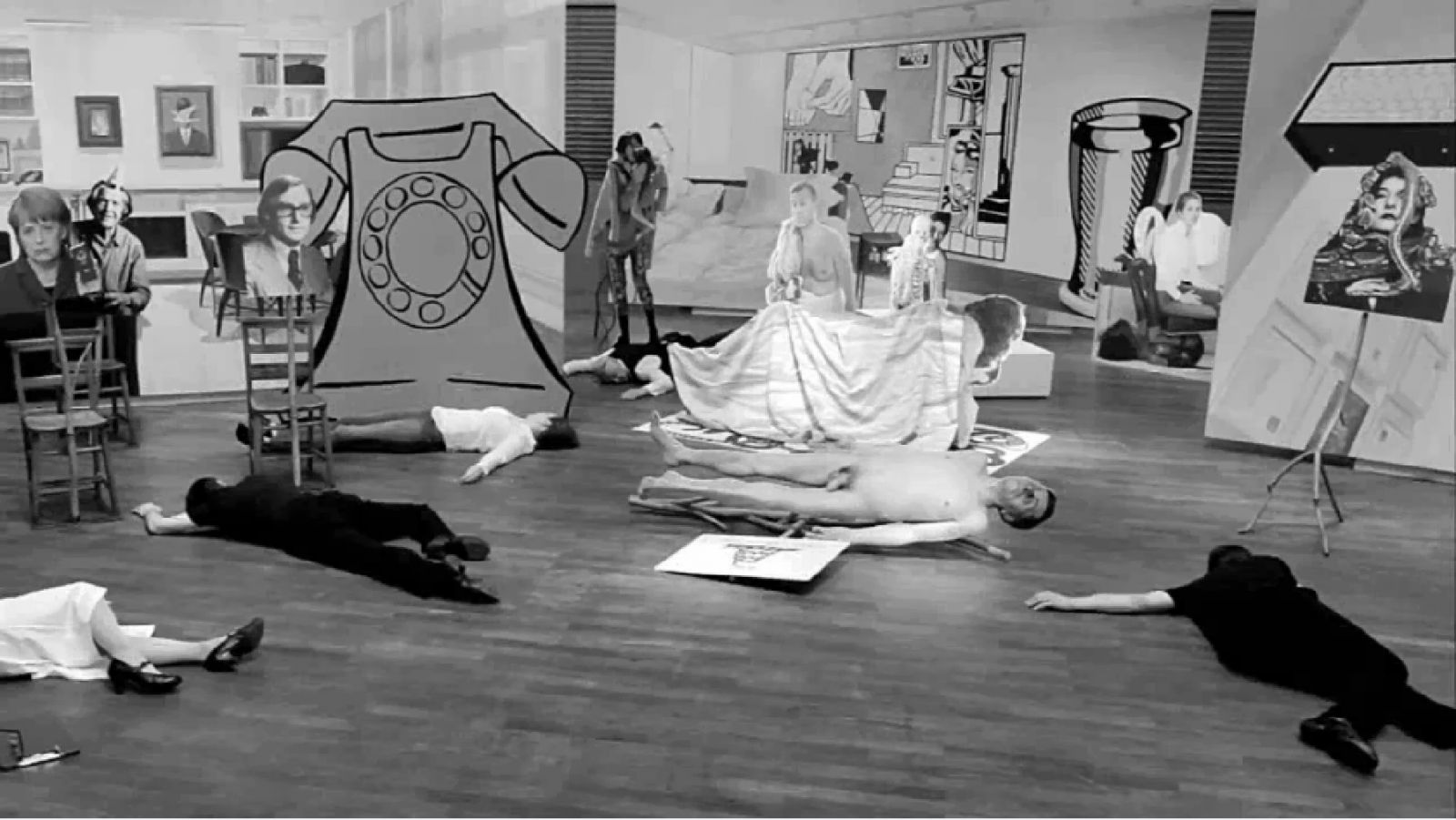
5 | A screengrab from a Vimeo upload of the performance-film Prepartory Notes for a Chicago Comedy (2014), Preface. The initial “flash”: what appear to be airbrushed shadows around the photographs of works by René Magritte (top left) and Roy Lichtenstein (center) make these works project forward with Dead Dad (center middle) and other cut-out sculptures. Meanwhile, the ‘real’ bodies in the foreground, positioned in diagonals, recede.
An image flashes in liquid crystal display. We scroll back to rewind and make a screengrab (Fig. 5). This incipit to the edited performance-film of Macuga ’s Chicago Comedy happens so fast it compels us to want to prolong its flash in a still. The Chicago Comedy is about to begin with the fanfare of a trumpet sounding. In a moment, the forceful blow of breath through a copper horn will signal the resurrection of the living-dead of an Internet afterlife of images. The stage-set on display uses the ‘levels’ of raster graphics editors as a compositional logic: overlayed in front of the museum’s brick walls, interface ‘windows’ open onto the living room, bedroom and hallway of three Chicago collectors [19]. The spaces of Chicago homes ‘expand’ inside Berlin’s Museum Dahlem as ethnographic dioramas of wealthy North American habitats in the mid-west (Fig. 5).
Cut-out placards and playing-dead actors reanimate the triptych of large-format digital reproductions in the background. A doubled-redoubling in reflective refraction, between plotter-print backdrops and cut-outs, causes confusion: the virtual graphics of ‘windows’ and the ‘live’ plastic art of real bodies-in-poses introject into arrangements of flat placard sculptures (Fig. 5). The chairs around a table in the living room backdrop on the left, extend onto the stage in the chairs that face the audience as plinths of cut-out busts. Is the Roy Lichtenstein Glass (Fig. 5, right) in the background of the set, one of Lichtenstein’s bronze sculptures, or is it a cardboard cut-out, like the cartoon telephone on the left? Is the cartoon telephone even really a cardboard cut-out, or is it just a print of a cardboard cut-out that has been pasted onto the surface of a different support material? (Fig. 5, left)
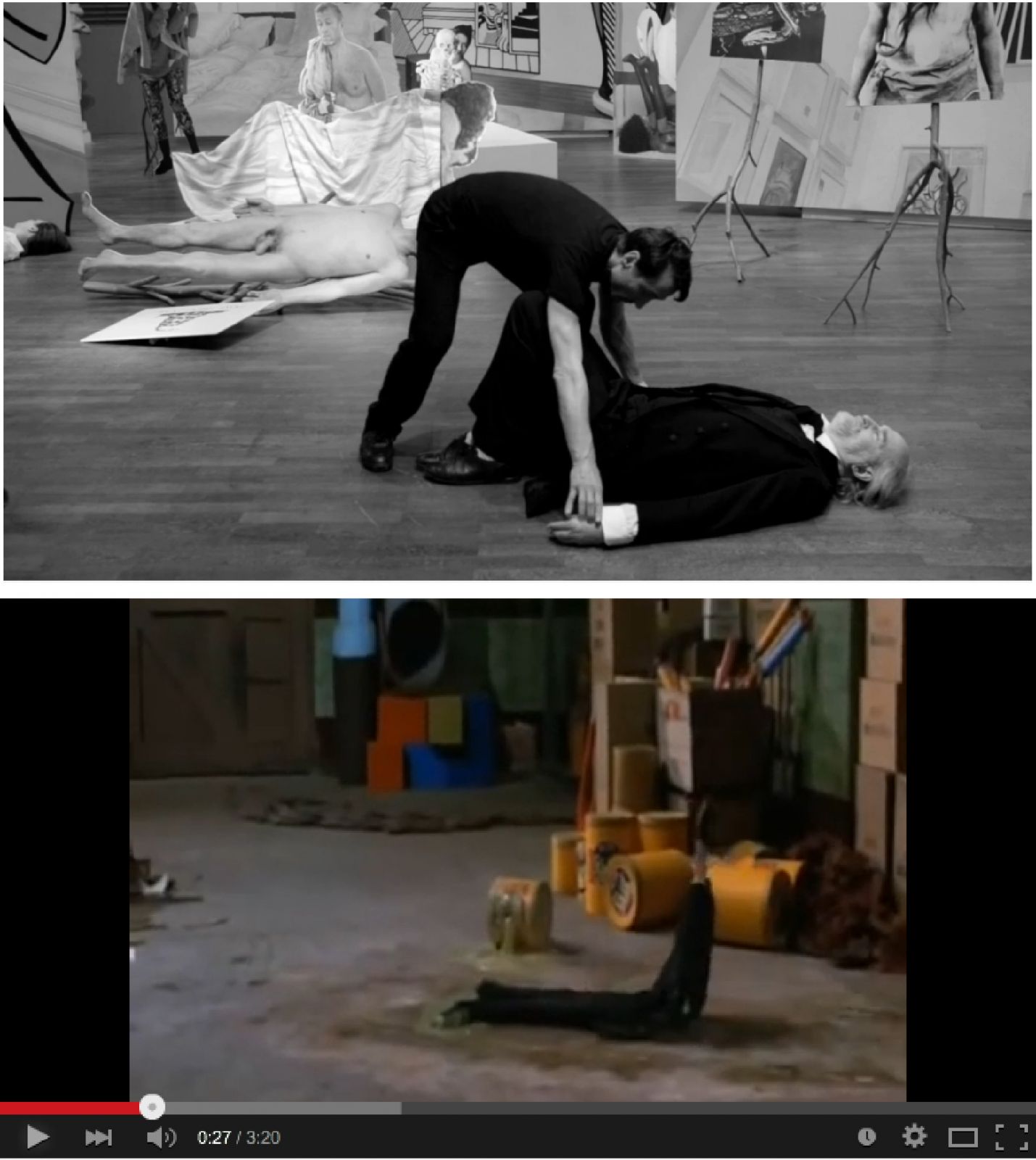
6 | (top) A screengrab from a Vimeo upload of the performance-film Preparatory Notes for a Chicago Comedy (2014), Preface: in the Preface, the character Warburg 2 is being positioned in the center of the stage to be brought back to life by one of the Chicago Comedy’s dancing twins; (bottom) The author-with-Duse association-idea: a screengrab from a Youtube upload of the final scene in Who Framed Roger Rabbit (1988) – “Holy Smoke, He’s a Toon!” The ‘real body’ of Judge Doom flattened by a steamroller, returns to life, revealing that Doom is really a Toon [20] (Source: Youtube).
Digital video of digital photographs appear to make images-embedded-in-images go ‘live’. When embedded in the one-dimensionality of binary code – numbering either 0 or 1 – the one-dimensionality of another digital image accesses a beyond-three-dimensionality of zero-degree hyper-plasticity: vision is paradoxically hyper-stimulated by this flat phantasmic phenomenology of image chains slithering one over the other between organic (human) and inorganic (computer) memory, between the actual, the analog and the digital. Videoed-photographed-paintings (i.e. René Magritte, L’Homme au Chapeau Melon, 1964) (Fig. 5, left) and videoed-photographed-sculptures (i.e. one of Roy Lichtenstein’s Glass sculptures from the 1970s) (Fig. 5, right) project themselves into the ‘actual’ world of the stage from the ‘window’ walls of ‘digitized’ Chicago homes (Fig. 5). Meanwhile, the very same digital video of human bodies flattens ‘live’ flesh to recede. When these ‘live’ bodies rise from their positions on the ground, we expect them to stagger forth over the museum’s hardwood floors with the plastic pliability of steam-rolled ‘toons’ (Fig. 6).
In front of the backdrop interface ‘windows’ into a diorama-world of Chicago collecting, a group of cut-out silhouettes of digital prints on placards stand erect against wooden chairs (Fig. 5, top left) while others are fastened on freestanding tree limbs (Fig. 5, top right). The bodies of actors are splayed across the floor amidst rigid flat sculpture busts and plotter-scaped backgrounds. The performance-film of the Chicago Comedy begins with a sacrifice rite in black-and-white: the black-and-white of the video marks both a flash-back into the past from death, as well as the triumph of the virtual image over the actual world of “corporalization” [Verleibung]. On stage, the bodies of the actors are dressed in the black-and-white of a fetishized past (i.e. black vests, black trousers, white shirts), while most of the cut-outs are printed in color for identification with the present. The human body is presented as a reified genre form like film noir and film reel footage, something to dress as for Halloween in a world where the digital hologram is lived as ‘real’ vibratile presence.
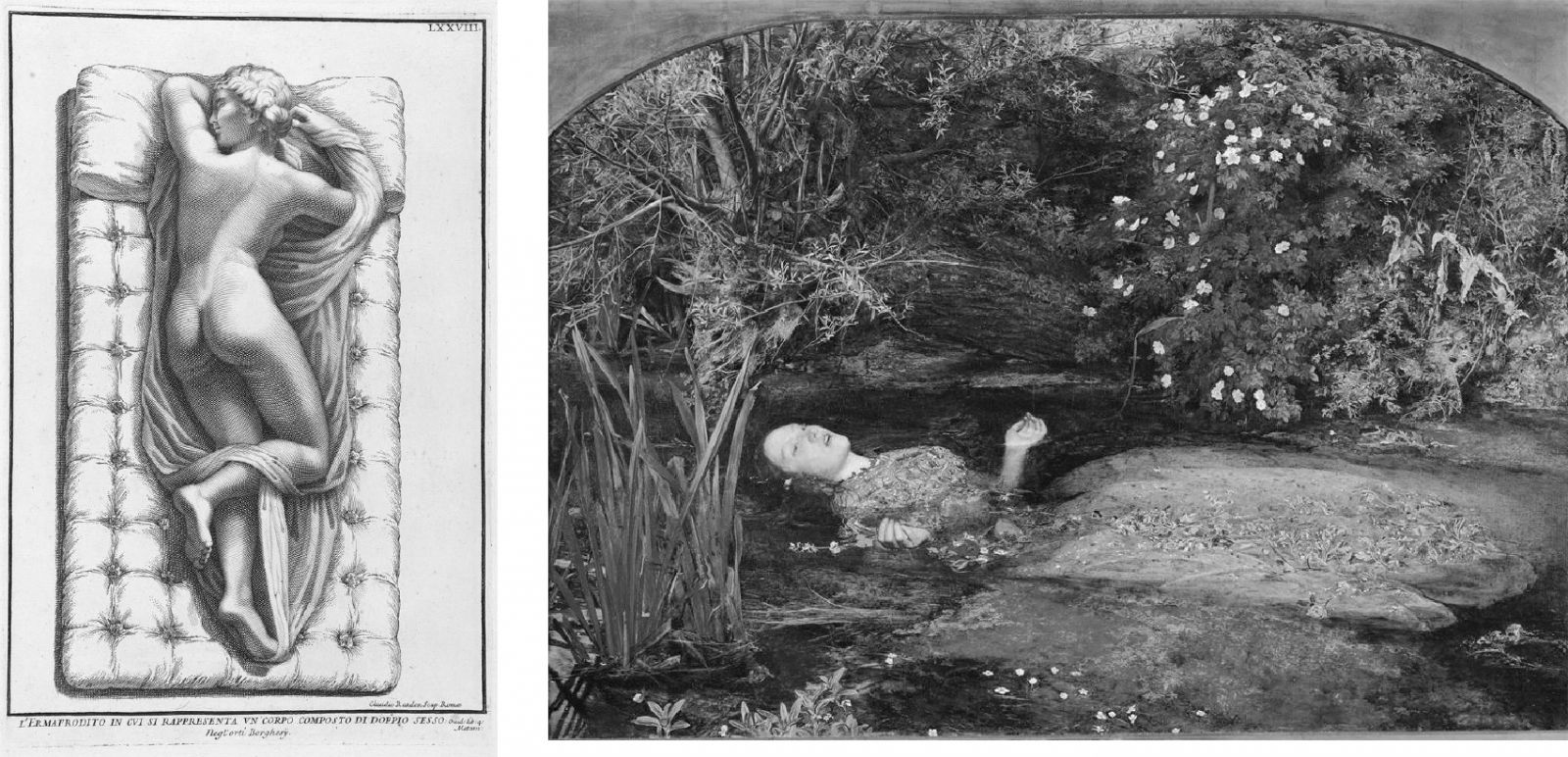
7 | The author-with-Duse association-idea: (left) engraving of Sleeping Hermaphroditus from the Maffei picture atlas (Domenico de and Paolo Alessandro Maffei), Raccolta di Statue Antiche e Moderne, 1704, in Warburg’s collection of atlases. (Source: Warburg Institute Library; Warburg Institute Iconographic Database); (right, in grayscale) John Everett Millais, Ophelia, 1852, oil on canvas, in the collection of Tate Britain (Source: Erich Lessing/ART RESOURCE).
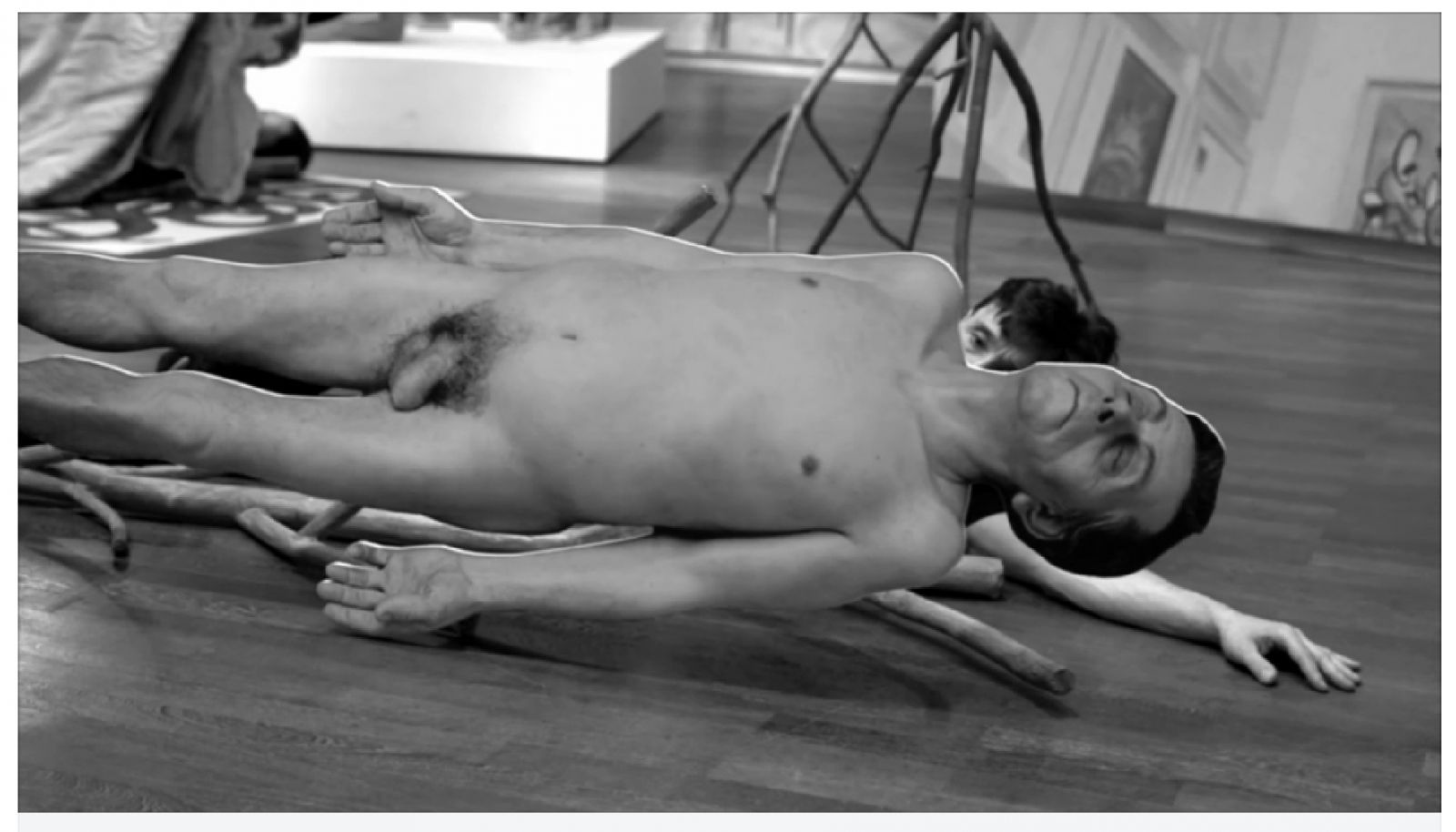
8 | Screengrab from the performance film, Preparatory Notes for a Chicago Comedy (2014), Scene Three (Aby Warburg on Art, Money and Politics): a cut-out of Dead Dad (1996-1997) being doubled by one of the Chicago Comedy’s dancing twins in Scene Two.
The black-and-white dichotomy is also gendered: women wear primarily white (i.e. white laboratory coat, white collared shirt) and men, primarily black (i.e. black t-shirt and pants, black vest and trousers). The coloring of gender is emphasized by the sexing of position: female bodies face up as abandoned pre-Raphaelite Ophelia and male bodies face down as inter-sex Sleeping Hermaphroditus (Fig. 7).
The only ‘black’ body in the scene is a so-called “bondage” mannequin in the back of the stage: a cut-out of what news reports of “internet outcry” (Walzer 2014; Lidbury 2014) came to refer to as the “racist chair” in 2013 (Fig. 5, top, back right, slightly obscured from view). The only true nude on the set is a ‘white’ corpse (Fig. 5, front, center-left; Fig. 8 detail). Ironically, this white-skin cadaver is another cut-out reproduction of a mannequin of sorts: it is an oversize print reproduction of a painted silicone sculpture, Dead Dad (Ron Mueck, 1996-1997), and lies up-right against a support structure of interlocked tree-limbs (Fig. 8). The original silicone sculpture reproduced the sculptor’s deceased father at approximately two thirds of his real dimensions; in Macuga’s Chicago Comedy, the cut-out of the silicone sculpture appears larger, as if it has been scaled back to its subject’s original size. Videoed objects on stage are always smaller than they appear.
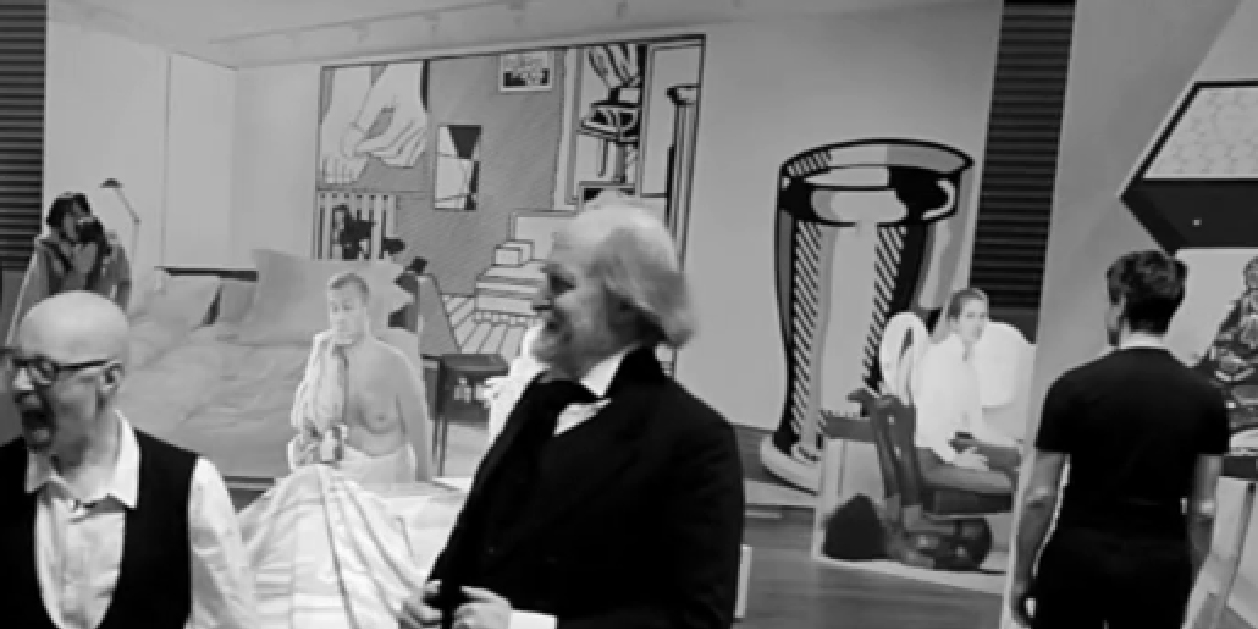
9 | (top) Detail of screengrab from Vimeo upload of the performance-film Preparatory Notes of a Chicago Comedy, Preface: Russian oligarch (“the other Abramovic [;] this one spelled with C H”) and art collector Roman Abramovich between characters Warburg 1 and Warburg 2. (right) one of the Chicago Comedy’s dancing twins looking across the stage toward the Goshka Macuga cut-out.
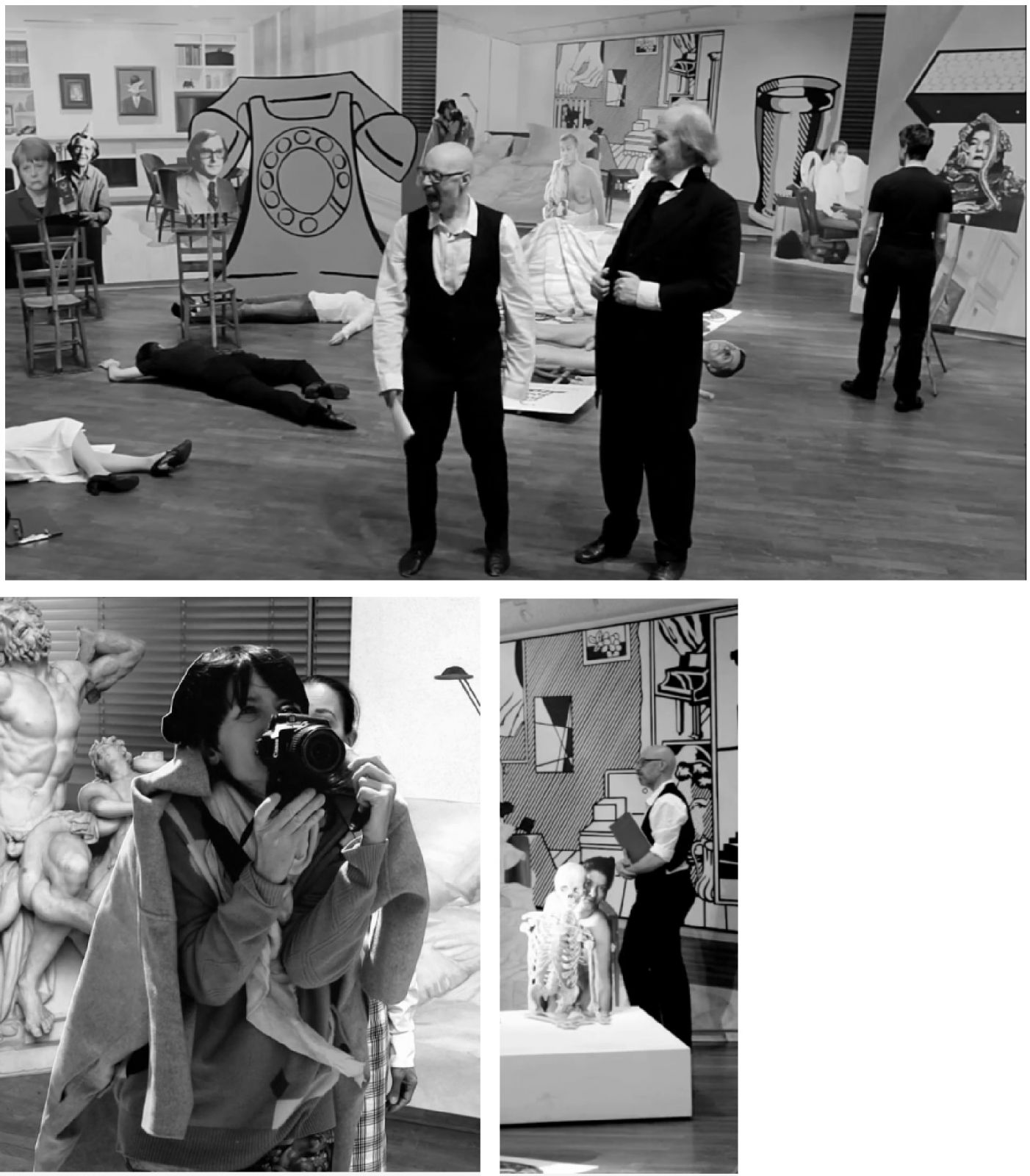
10 | (top) Screengrab from Vimeo upload of the performance-film Preparatory Notes of a Chicago Comedy, Preface: characters Warburg 1 and Warburg 2 introduce the Chicago Comedy; Standing in front of a cut-out of Marina Abramovic, one of the dancing twins (right) glances over at the full body cut-out of Goshka Macuga, whose camera peeks out from over the bald head of Warburg 1; (bottom left) detail of screengrab, Macuga cut-out sculpture with actress standing behind; (bottom right) detail of screengrab, Marina Abramovic-with-skeleton cut-out with Warburg 1 positioned behind. Warburg 1 looks toward the Macuga cut-out across the stage.
In color and gesture, position and placement, the opening scene of Macuga’s Chicago Comedy performance-film is criss-crossed by comedic doubles that redouble. Twenty-first century brain science often makes use of the metaphor of 'hardwiring', but in this scene 'hay-wiring' is the metonymic figure par excellence. If neuroscience’s mirror neurons could become tangled into nets of metastasizing clumps, this would be their oncological allegory: every body and every thing empathetically mimics every thing and every body to the point of cancerous multiplication. The black-and-white costumes of characters against the black-and-white skin of color prints, half-tone scan cut-outs and pale flesh bodies, are made black-and-white to the nth-degree in the black-and-white video sequences of the performance-film. This doubled redoubling in production and post-production is repeated across the stage and throughout the various scenes of the Chicago Comedy performance-film: the rigid perpendicularity of a wooden chair, and the tripod stability of a branching tree limb, are an unnatural-natural mirroring. This mirroring zig-zags back on itself in redoubling, and ends in an ephemeral monument to outdated technology and the precarious: a cartoon rotary-dial telephone drawn with a calligraphic brush line on what looks like a cardboard surface, but could also just be a print of a cardboard surface (Fig. 10, left).
Doubles redouble again and again: in Macuga’s Chicago Comedy cut-out from a still in a self-surveillance video (Untitled, 2003), American artist Andrea Fraser and a man she calls “her collector”, are in bed between the print cut-out of the silicone Dead Dead and a cut-out paparazzi shot of a bare-chested Russian oligarch, also a collector (Roman Abramovich) (Fig. 9, left, between Warburg 1 and Warburg 2). The oligarch collector is another doubled redoubling: his drooping breasts and sagging stomach emphasize the fleshiness lacking in the replica skeleton in the cut-out behind him (Fig. 10, detail, bottom right). In the cut-out behind him, a plastic skeleton is held up by Serbian performance artist Marina Abramovic (Fig. 10, hidden behind Warburg 2; see Fig. 10 detail, bottom right), to whose measurements the skeleton was fabricated as a death double (Nude with Skeleton, 2002/2005/2010): in Scene Three of Macuga and Roelstraete's script for Chicago Comedy (Aby Warburg on Art, Money and Politics), the actor who plays Warburg 1, provides the voice of the Russian oligarch Roman Abramovich who introduces himself to the audience as Marina Abramovic’s double – “the other Abramovic; this one spelled with C H” (Macuga and Roelstraete, Scene Three, 2013) (Fig. 10).
Like the reproduction cut-out of Dead Dad, artist Goshka Macuga, who designed the set, choreographed the performance and co-wrote the script for Preparatory Notes for a Chicago Comedy, is herself present on stage as a full body cut-out; and, in fact, with this parallelism, it could also be said that, just as Warburg is the 'dead dad', or master signifier, of the action in the Chicago Comedy, Macuga makes her image the 'dead dad' of the stage set: she is its master signifier-with-camera (Fig. 10, detail, bottom left). The definition of an image that plays the master-signifier is one whose self-referentiality forces an otherwise endless chain of signifiers to cease circulation momentarily. The gaze of the Dead Dad cut-out is turned inwards behind the closed eyes of a death mask and into the digital corpse scan of its silicone surface.
The phallic power of the Dead Dad cut-out is silicone limpness, and thus, a positivized negative. Macuga’s gaze is likewise obscured by a gaze turned inwards through that ultimate image-apparatus of death – the turgid opticalextension of the camera lens (Fig. 10, detail, bottom left). Unlike the digital reproduction of the silicone Dead Dad, however, Macuga’s image is a fleshy body layered in fabrics. Macuga’s cutout is the positive negative phallus: a sheathed replication of silicone limpness. Digital reproduction re-animates cool pallid silicone with the punning ‘special affect’ of an ‘unburied’ perpetually restless, father-figure. The same digital re-animation technique – a full-size digital print made into a cut-out – deadens the warm flesh of the artist, thus granting Macuga premature access to the omniscient posthumous perspective of the what historians of contemporary art call “retrospectivity”. Macuga’s cut-out is the parody of a “lesbian phallus”: the “fiction” of “imitation, subversion and the recirculation of phantasmatic privilege” that makes the “veiled” operation of the phallus into its own actual object (Butler 1993, 85).
In Scene Three of Macuga’s Chicago Comedy (Aby Warburg on Art, Money and Politics), an actor stands behind the Macuga cutout to play Macuga playing herself as a self-reflexive cut-out: the same actor also plays the character of performance artist Marina Abramovic (Fig. 10, detail, bottom right). The actor’s voice and stage presence facilitate slippage into yet another redoubling – Macuga’s cutout becomes the reflection of what we might call the ‘dead mom’ (as in mother of performance art) cut-out of Abramovic holding her replica skeleton (Nude with Skeleton, 2002/2005/2010). In this cut-out, Abramovic sits nude behind the plastic image of her own death – the skeleton made to her measurements. Abramovic takes the same pose as the actor who plays Macuga-playing-herself-as-a-cut-out. The actor standing behind Macuga, dutifully reads her lines: “Hello, My name is Goshka Macuga. I am the artist and I like to be embedded” (Macuga and Roelstraete, Scene Three, 2013) (Fig. 10, detail, bottom left). The contemplation of the Internet afterlife of one’s own image is necrophilic.
The ‘dead dad’ of this twenty-first century trend in mass virtual necrophilia is the nineteenth century Montparnasse cemetery stalker Joseph Bertrand; the ‘dead mom’ is the object of Bertrand’s desire, the buried body of a deceased woman. Bertrand’s ‘love’ of corpses led to psychiatrist Joseph Guislain’s binary reversal of the early nineteenth century fascination with “lycanthropism” or vampirism, into “necrophilia” (love of death) in an 1852 lecture: the image of the dead molesting the living in the popular vampire myth of folktales, thus became the image of the living molesting the dead – the “monster or anarchist, werewolf or ‘pervert’” of the “alienated” [aliénée] in the French popular press (Weller 1999, 222) (Fig. 11). Abramovic transforms this impulse into necrophilic auto-affection, or the self-touching of self as dead-self. The Abramovic-Dead-Dad-Macuga transposition moves these images through each other in a transfer of socio-symbolic energies: the result is a compact figure of death drive sedimentation in what might be called, using Warburg's terms, an Energiesymbol (energy symbol) (Warburg [1907] 1999; Warburg [1907] 1933).
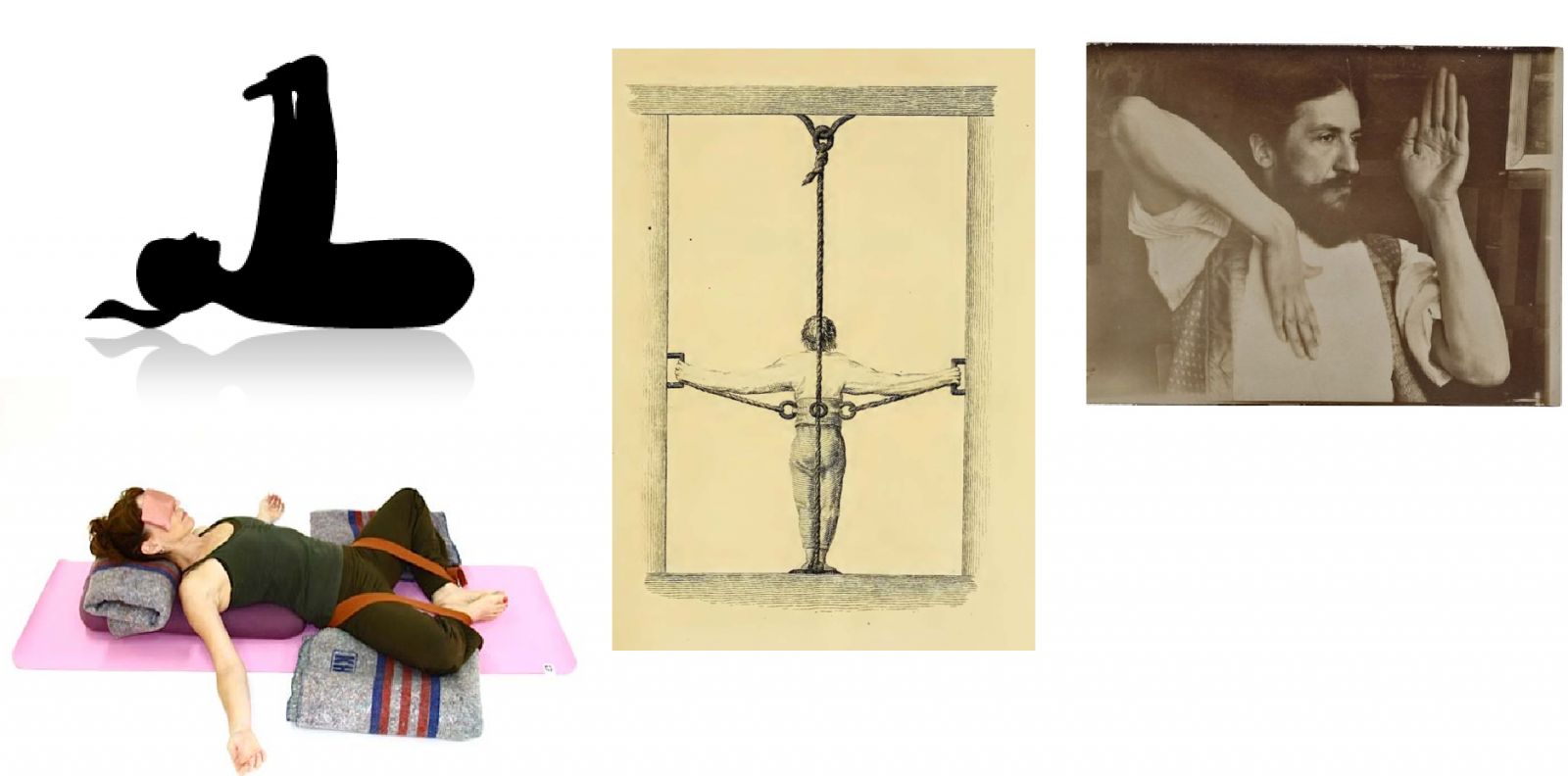
11 | The author-with-Duse association-idea: (left top) silhouette of ‘happy baby pose’ (Source: Wellness Bank Blog); (left bottom); “restorative yoga” pose with strap and other “props” (Source: World Yoga Network); (center) Illustration of treatment method for “alienated” individuals like necrophilics, from psychiatrist Joseph Guerlain’s Traite sur l’Aliénation Mentale et sur les Hospices des Aliénés (1826) (Source: Internet Archive); (right) A photograph of theorist of neo-plasticism Piet Mondrian, long said to have been a portrait of him in a yoga pose, now said to be a portrait of him posing for phrenologist Alfred Waldenburg (1873 – 1942) (Source: Piet Mondrian Archive; Netherlands Institute for Art History (RKD).
The Macuga cut-out is an embedded “energy-symbol” [Energiesymbol] (Warburg [1907] 1933; Warburg [1907] 1999) in a stage populated by necrophilics: throughout most of the Chicago Comedy she stands with her camera raised to her eye as if warding off necrophilia with a phallic ocular amulet that turns death against death (Fig. 10, detail, bottom left). Her cut-out is positioned in front of a photograph of René Magritte’s bowler-hat man with a dove-in-flight obscuring his face (Fig. 12, for detail as it appears in an overlay animation interlude; Fig. 5 for the broader context). This juxtaposition makes Macuga’s camera a metonymic substitute for Magritte’s bowler hat: both camera and hat are markers of bourgeois identity and self-preservation; and whereas in the early twentieth century, it was a socio-symbolic gaffe to be caught outside without a hat, in the early twenty-first century, any event experienced without its digital snapshot is an event that has not been lived.
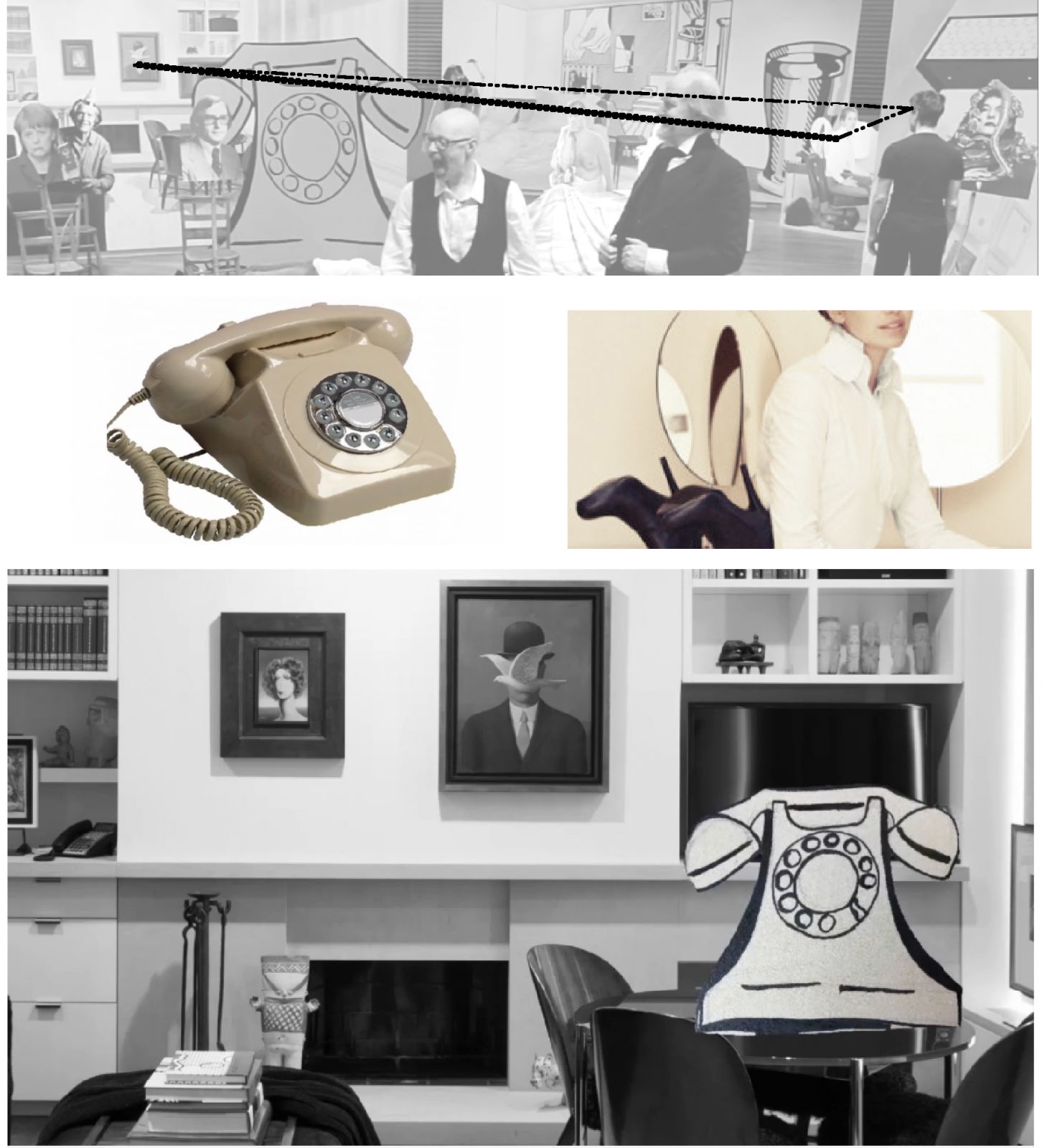
12 | Screengrabs from Preparatory Notes for a Chicago Comedy (2014), Preface and Scene One (Aby Warburg on Technology). (top) Diagram by the author: the dancing twin looks across the stage towards the Macuga cut-out, as if following our hallucination of Magritte’s dove (top left) flying into the collar of the Zhukova cut-out (top right). (center right) detail of Daria Zhukova’s “McQueen” collar in the “racist chair” cut out; Animation interludes: (center left) animated cut-out of a telephone; (bottom) animated overlay of “cardboard” cut-out telephone in the living room of a Chicago collector with Magritte’s L’Homme au Chapeau Melon, (1964).
Across from the Magritte painting embedded in the backdrop on the left, is a photograph of a large empty bed, itself embedded in the backdrop in the middle of the set. The Macuga cut-out is in the middle of artist-collector love-makers/deal-makers Andrea Fraser and “her collector,” the large ‘cardboard’ cartoon telephone, the cut-out of the ‘dead mom’ of performance art (Abramovic with her replica skeleton), and a cut-out of what ‘Internet outcry’ nicknamed the “racist chair” photograph for both its posed set-up, and its release on the date of the national holiday celebrating civil rights leader Martin Luther King in the United States (Fig. 12, top, author’s diagram). In the “racist chair” cut-out, Russian socialite, Daria Zhukova (wife of “the other Abramovic,” Roman) is photographed sitting on top of a mannequin-sculpture by artist Bjarne Melgaard (b. 1967) Allen Jones Remakes: Chair (2013) (Fig. 13). The Macuga cut-out points her camera across the stage, behind the back of the “other Abramovic[h]” the Russian oligarch-collector Roman with his fleshy chest. In our own hallucinatory associations provoked by Macuga’s juxtapositions, the dove in front of the face of Magritte’s bowler-hat-man takes flight, and escapes into the high neck collar of what looks to be an Alexander McQueen blouse on Zhukova (Fig. 12, top, author’s diagram, the gaze of the dancing twin on the right appears to follow this hallucination from the left side of the frame to the right).
In empathy with the Büro 24/7 fashion magazine’s cropping of its original “racist chair” photograph in response to ‘Internet outcry’ (Fig. 19), the cut-out of Zhukova is horizontally flipped from left-facing to right-facing for the design of Macuga's Chicago Comedy stage (Fig. 13, bottom right). Both the Macuga cut-out and the Zhukova cut-out are full-body cut-outs, however, unlike the Macuga cut-out – and the cut-out of Dead Dad (the set’s other full-body cut-out) (Fig. 8) – the cut-out of the Russian socialite is not a true silhouette. Instead, it represents the rare instance in Macuga’s Chicago Comedy when a cut-out includes elements of its source photograph’s original environment: these elements are three vanity mirrors, a veneered table, a white shag carpet and, the real protagonist of the cut-out, the so-called “racist chair” (Lidbury 2014; Walzer 2014).
The latter is Melgaard’s Allen Jones Remakes: Chair (2013) (Fig. 13, center left), itself a re-visitation of Allen Jones’ (b. 1937) polyester resin series Hatstand, Table and Chair (1969) (Fig. 13, detail of Chair, bottom left). After having been ironically canonized by feminist historians “in revolutionary revision” (Mulvey [1973] 2002) as an example of a “mimed and critically reiterated” “mastery of the language of basic fetishism” in the seventies, in 1986, Jones’ series of ‘women as furniture’ was disfigured with paint stripper while on gallery display (Pollock 2002). Damage done to the face of Chair by the paint stripper incident was remedied with Jones’ approval by a conservation-intern at Tate in 2014 after Melgaard’s revisitation of the sculpture was displayed in New York and used in the Büro 24/7 fashion shoot with Zhukova. In interview, the conservation-intern who worked on the project asserted: “I don’t think anybody has the right to edit art history” (Bracker 2014).
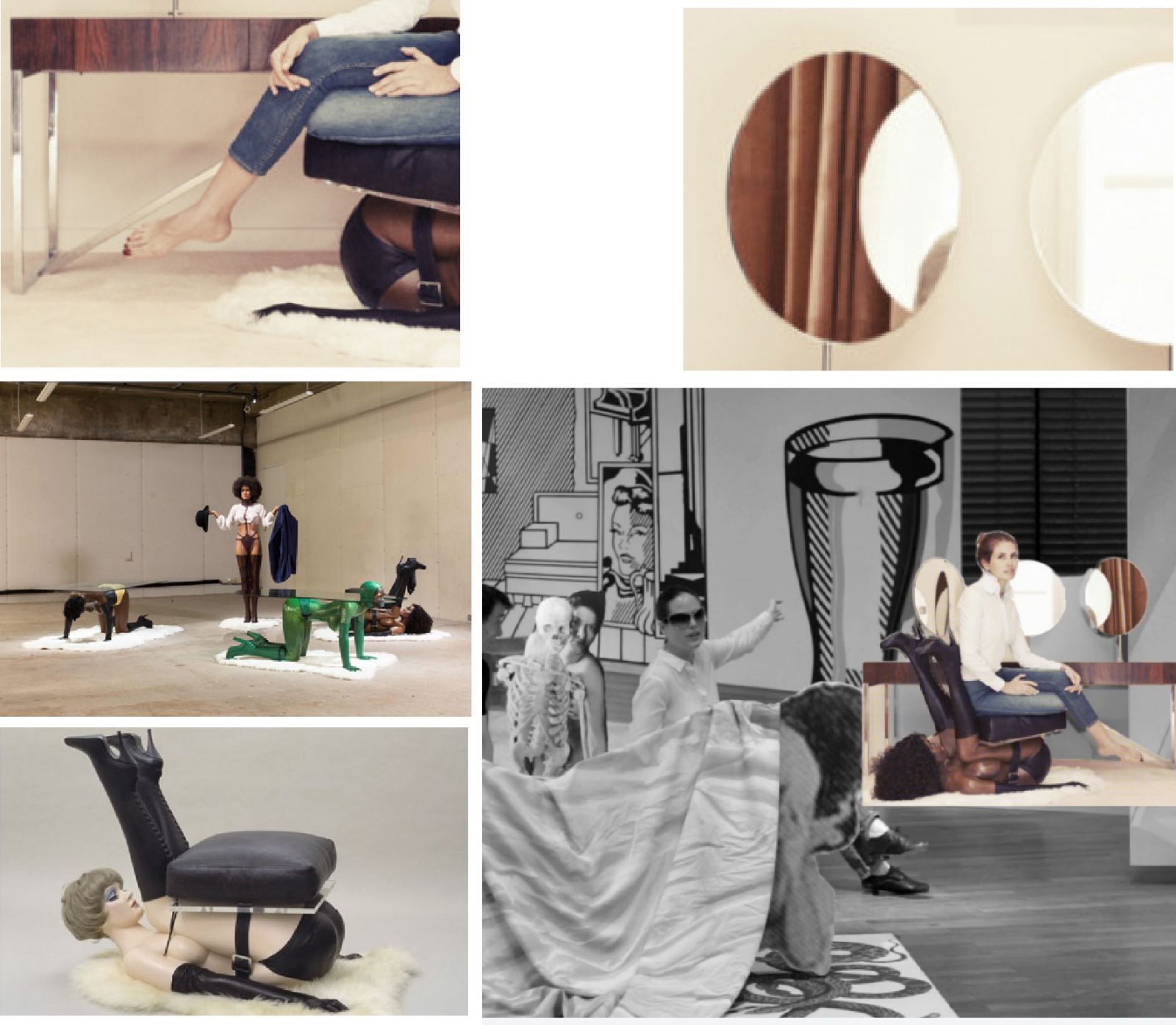
13 | (bottom left) Chair from Allen Jones' Hatstand, Table, Chair (1969) (Source: Tate); (center left) Bjarne Melgaard’s Allen Jones Remakes from the exhibition Gang Bust, 2013 (Source: Venus Over Manhattan). (top left and right) details from the original photograph as it appeared in the fashion magazine Büro 24/7; (right) Screengrab from Preparatory Notes for a Chicago Comedy (2014), Scene Three (Aby Warburg on Art, Money and Politics).
In the Chicago Comedy’s unapologetic editing of the history of art, the socialite in the “racist chair” cut-out (Zhukova) poses as if coyly preparing for bed in front of her vanity (Fig. 13, bottom right); she sits with well-mannered posture and light make-up, atop the mannequin of a black female figure who could either be described as tied up with a yoga-strap in the ‘happy-baby pose’ of contemporary calisthenics, or bondaged in a sado-masochistic ritual – or, perhaps, a parodic combination of both (Fig. 11). The arrangement of all of the furniture in the photograph alternates darks and lights: the pale walls reflected in the circular mirrors (Fig. 13, top right), the dark verneer of the table top, the glint of the table’s metal legs (Fig. 13, top left), the dark stiletto heels of the mannequin’s boots (Fig. 12, center right), the light shag carpet, the dark curly wig of the mannequin (Fig. 13, top left), the stark white of Zhukova’s high-collared designer blouse (Fig. 12, center right) and the dark leather cushion underneath her light blue jeans (Fig. 13, top left), her pale feet hanging over the mannequin’s dark leather gloves (Fig. 12, center right) and Zhukova’s carefully positioned toes turned to show the accent points of dark nail polish (Fig. 13, top left).
The stacking of right angles in the two bodies emphasizes their specular racialization in a binary opposition of black and white stereo-types that Macuga emphasizes by ‘colorizing’ the cut-out in an otherwise black-and-white video sequence (Fig. 13, bottom right). Subject and object, organic and inorganic, ‘flesh’ and ‘resin,’ and yet there is something not quite right in readings that victimize the mannequin figure. If Jones’s sculptures enact the “mastery of the language of basic fetishism” (Mulvey [1973] 2002) Macuga’s Chicago Comedy frames Melgaard’s Chair as the semio-capitalist ‘mastery of the language of [the] basic fetish’ of racism. The compression in the mannequin’s straining neck and in the strap around the resin sculpture’s supra-human (beyond human because mannequin) legs, generates an after-image of comic catapulting: following our hallucination of the dove in flight from Magritte’s bowler-hat-man painting to Zhukova’s McQueen high collar (Fig. 12), the figure of Zhukova takes flight, ‘duped’ in a set-up that finds her kicked clear off the set. This kick-off is the inevitable fate of all fashions and all protagonists in the crisis-and-exhuberance model of manic-depressive scandal circuits on the Internet (Fig. 11 and Fig. 13).
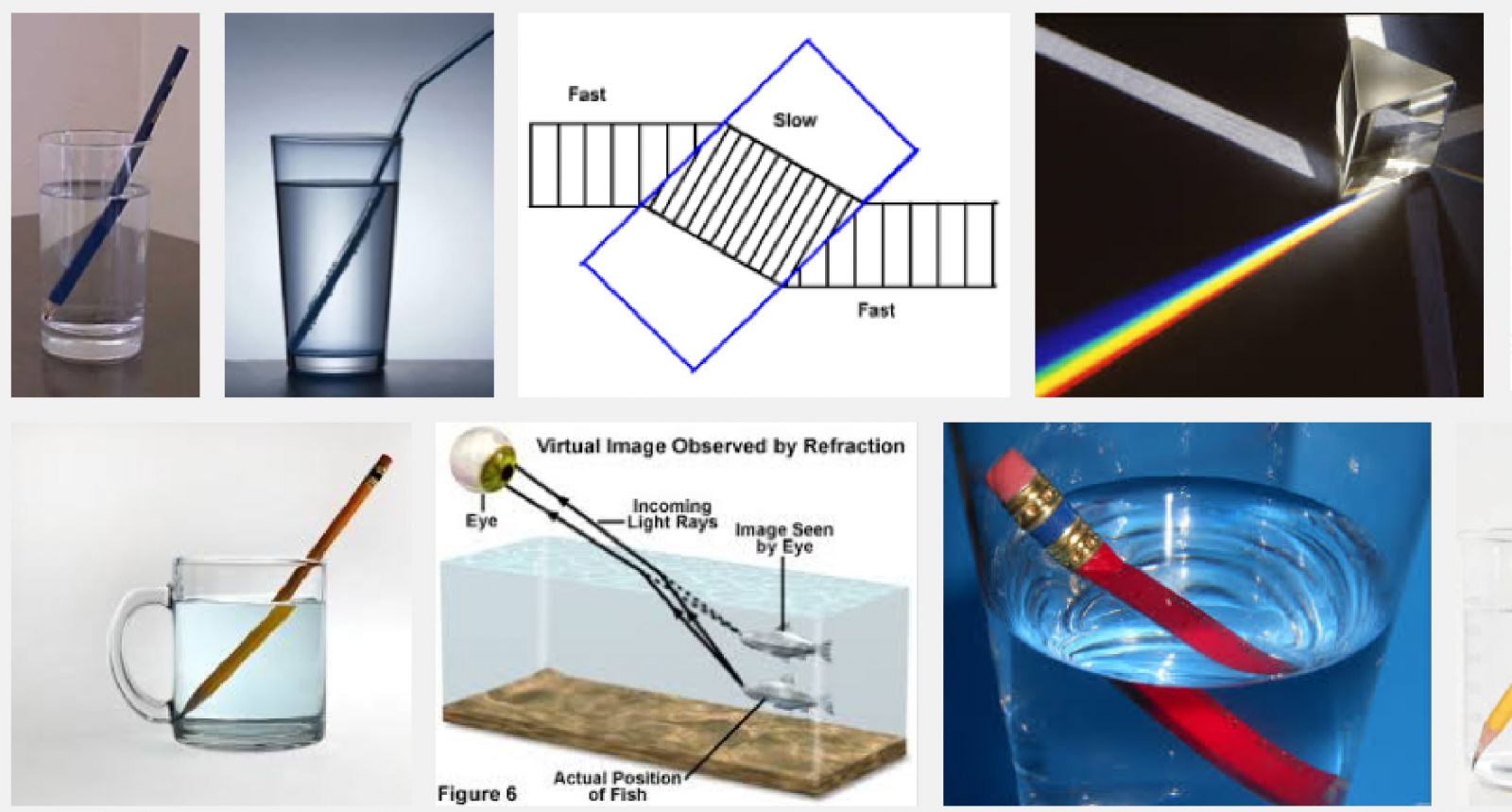
14 | The author-with-Duse association-idea: screen grab detail for reflective-refraction; created using various combinations of key terms in Google image search (Source: Configuration of images by the author using Google).
The horizontally-flipped ‘magic-wanded’ digital print cut-out of the “racist chair” photograph in the Chicago Comedy makes manifest the doubling redoubling reflective refraction that characterizes comic gesture (Fig. 14). It is this same spiraling dialectic that constitutes what Warburg wrote of in his fictional epistolary with critic André Jolles, as “festive, ludic drive to create forms[,] and [the] artistic, mimetic power (…) grafted onto one branch” [festlich spielender Gestaltungstrieb und kunstlerisch spiegelnde Kraft (…) auf einen Stamm geimpft blühen] (Warburg [1900] 2012). This “ludic drive” [spielender Gestaltungstrieb] is what generates the infinite self-replication of images designed to self-replicate in what will appear like the natural automated spawning of unpredictable iteration after reiteration of re-plays, re-mixes and mash-ups on social media image-dumps like Pinterest and Instagram.
The fetishization of a post-race “racist-chair” in “internet outcry” (Lidbury 2014; Walzer 2014) an example of doubled-redoubled-reflective-refractive form: the aesthetic regime of racism in what has been theorized as the event of the post-racial, is a “decorative Pathos” [decorative Pathos] the serves a fashion shoot for the purpose of alternating lights and darks. Is the “expression” [Ausdruck] (Warburg [January 1896] 2011, 107) in this gesture really just an “outward symptom” [äußere Symptom] (Warburg [1905] 1999; Warburg [1905] 1933) of the affect we call “shame,” a “cruel reminder” of the “hypersexualized, abused, ridiculed object,” as newspapers like The Guardian lament (Riaz 2014)? Or is it telling us something more – something about what Warburg called in his New Mexico note, “corporal introjection” [Hinein[Um]verleibung] in symbolic processes (Warburg [January 1896] 2011, 107): what is it telling us about the interchange between philia (love) and phobia (anxiety), between necrophilia (love of death) and necrophobia (hate of death), between “technophilia” [Technophilie] and “technicskepticism” [Techniskepsis] (Mainberger 2014, 133) and what Afro-Caribbean psychoanalyst Frantz Fanon called negrophobia (love of blackness) and negrophilia (hate of blackness) (Fanon, 1967; DeVereBrody, 1998; Jules-Rosette, 2007), that pendulum swing between love and hate that gets the Internet going, the ultimate ‘turn-on’ online? Are the repressed connections among these various philia and phobia an indication that the contemporary addiction to technology is less an obsession with progress and growth, than a symptom of “necropolitical” enjoyment, that is, a morbid pleasure in the image of decay and the politics of death [21]?
These are the questions that Macuga’s Chicago Comedy, irreverently inspired by Warburg, poses on its stage of de-constructed poses, its comedic Pathosformeln (pathos-formulas) (Warburg [1905] 1933; Warburg [1905] 1999) and Energiesymbols (energy-symbols) (Warburg [1907] 1933; Warburg [1907] 1999). In the Chicago Comedy, postures, patterns, pictures and contours reproduce “Internet outcry” or “sensation,” not by re-enacting its ‘points’ or ‘actions’ of scandal, but by “corporalizing” [Verleibung] (Warburg [January 27 1896] 2011, 107) the relations, the ‘intervals,’ or ‘pulsations’ between them. In other words, Macuga does not produce her own protest re-iteration of the “racist chair”, but instead “corporalizes” [Verleibung] the relations of “outcry” around the object: these relations then generate strings of “sensorial impressions” [sinnlichen Eindrucks] (Warburg [January 27, 1896] 2011, 107) and “association ideas” [Associationen-Ideen] (Warburg [April 7 1891] 2011, 76], what dramaturgist and theorist Grotowski called the “pulsations” between “impulse” and “action”.
An example of potential associations and impressions – pulsations or zwischenraum (interstices or inbetween spaces) – evoked in one viewer (the author of the present essay) by the “racist chair” in Chicago Comedy include: the coincidence of Malgaard’s Chair being exhibited while the solvent-defaced original Chair (1969; 1986) by Allen Jones was being restored by conservators-in-training at the Tate (Fig. 13, bottom left); the multi-million dollar auction sales of other versions of Jones’ Chair between 2013 and 2014 when Zhukova sat on it in a fashion shoot (Fig. 19, top right) [22]; actor Clint Eastwood staging an imaginary conversation with incumbent U.S. President Barack Obama as an empty chair at the Republican National Convention in 2012 (Fig. 15); internet images of a metal folding chair ‘hung’ from a tree by a Texas man (“Is this an anti-Obama lynching”) (Fig. 15); the tongue-in-cheek response to Eastwood’s performance on Barack Obama’s twitter account (an image of the back of Obama’s head just barely visible over the back of a large chair marked for the Executive Office) (Fig. 15); and Marcel Duchamp’s Tonsure (1919), his in-joke messianic self-portrait as the “head-light child” (enfant-phare) with a star shaved into the back of his head and a pipe in his mouth to figure as the star’s trailing comet tail (Fig. 15).

15 | The author-with-Duse association-idea: image strip of association-ideas, sensorial impressions and pulsations evoked by Macuga’s staging of the “racist chair” in Chicago Comedy. (left to right) “Clint Eastwood’s Bizarre “Empty Chair Obama” Speech at the GOP Convention,” August 30, 2012 (Source: Mother Jones) (Kroll 2012); “Is this an anti-Obama lynching? Texas man hangs chair from tree inspired by Clint Eastwood speech.” September 12, 2012 (Source: New York Daily News) (Ortiz 2012); “Barack Obama Tweets Response to Clint Eastwood RNC Empty Chair Speech.” August 30, 2012 (Source: The Wrap) (Waxman, 2012); Marcel Duchamp’s Tonsure de 1919, Paris (Source: Artist’s Rights Society).
The difference between Malgaard’s symbolic action and Macuga’s use of Melgaard’s action, is this string of “sensorial impressions” and “association ideas”: it is the question of the gap between “action” and “impulse”, or rather, the distance of “pulsations” within which it becomes possible for a work to engage with the viewer’s unconscious, rather than acting on the viewer’s ingestion of the artist’s ideas and impressions. One action is not a ‘truer’ form of art than the other: the former (Malgaard’s action) is principally about the artist’s own associations, the latter (Macuga’s use of Malgaard’s action) works with the artist’s associations to involve the associations of the viewer. Both Malgaard and Macuga’s actions involve aspects of both impulses: the distinction between them is one of degree. The way this is determined is not by the artist’s expressed intention but rather by the material qualities found in the work’s varying levels of “corporalization” [Verleibung] (Warburg [January 1896] 2011, 107] between the graphic [zeichnenden] and the plastic [plastische] (Warburg [March 25 1896] 2011, 109) between mechanical and digital reproductions and their one-two-three hyper-dimensionalization, and finally, by the degree of engagement of the artist’s own body in actually physically handling and manipulating “energy symbols” [Energiesymbols] (Warburg [1907] 1999; Warburg [1907] 1933).
To put this distinction we are trying to make in more concrete terms, it might be helpful to consider two projects involving book covers by Macuga and Melgaard from 2002 and 2005 respectively. Macuga’s book cover project is a hand-tooled leather ‘cover’ (a pun on book ‘cover’ and on the ‘cover’ as a form of appropriation), that appropriates images by other artists (A Time to Live A Time to Die, 2005): it is a juxtaposition of figures from iconic signs of semio-capitalism, including ‘Picasso’, ‘Max Ernst’ and ‘the 1905 Russian Revolution.’ These ‘covers’ are not re-drawn expressively but mechanically: they are fixed into cured animal skin through hand-tooling. Melgaard’s artist book, on the other hand, is his signature scrawled in black marker on the cover of a journalistic exposé. The exposé, titled Lords of Chaos, is a study of the Norwegian black metal scene that Melgaard participated in during the nineties (de Baere 2008). Melgaard’s ready-made – a book on a popular culture phenomenon – is an object that he contributed to producing by his involvement in the ‘scene’ the book studies. By signing the book, he re-appropriates the ‘scene’ retrospectively by inscribing his name in the smoke above a burning medieval church in a photograph reproduced for the volume’s cover. The same year Melgaard signed the book, his show, Black Low (2002) was declared obscene and closed by local authorities in the German town of Herford (de Baere 2008).
Reviews of Macuga’s work have associated her with the becoming-machine gesture of photocopying – of standing and scanning in front of flashes of bright light (Griffin, 2013) – while Melgaard’s interviews emphasize the “dark” and the “visceral”: his experience “taking steroids,” his fascination with “narcopolitics,” his being part of a “hardcore music/sex world,” literally his “weigh[ing] like, 280 pounds of muscle or something (...)” (Gavin 2013). The polarity Melgaard-and-Macuga as it is presented by Macuga in the Chicago Comedy could be said to be a twenty-first century reiteration of the Pathosformeln Warburg observed in his essay on Durer: the “attempt to adopt a style that was an unresolved composite [unausgeglichenen Mischstil] between realistic observation” [zwischen realistischer Naturbeobachtung] in “idealizing” “familiar (…) sources” [und idealisierender an berühmte (…) Muster], (i.e. Macuga) and a “more consistent style” [einheitlicheren (…) Stil] of the “sheer exuberant rhetoric of muscle” [seine überlebendige Muskelrhetorik] (i.e. Melgaard) (Warburg [1905] 1999; Warburg [1905] 1933).
In Macuga’s Chicago Comedy, the artist, Macuga, and the curator, Roelstraete, place themselves in this polarity with Melgaard, not by inserting one of Melgaard’s works into the Chicago Comedy directly (as Macuga does with artist Ron Mueck’s Dead Dad sculpture), but through a mediated image produced by the fashion industry. This mediated image – the “racist chair” cut-out – becomes a kind of shadow protagonist to the iconic image of Warburg in the play: both the iconic image of Warburg – the photograph Aby Warburg wearing a Hemis Kachina mask, Oraibi, Arizona, May 1896 – and the Büro 24/7 fashion magazine photograph, are iconic symptoms “unearthed” [Entdeckung] (Warburg [1905] 1999; Warburg [1905] 1933) from internet image-dumps in heavy circulation.
A year before his death, Warburg wrote in the scientific diaries (Tagebuch) of his library: “I am not a revolutionary reformer but an energetic transformer” (Warburg in Palver 2013, 97) The field of energetics in physics is defined as “the branch of science dealing with the properties of energy and the way in which it is distributed in physical, chemical or biological processes” (Oxford 2015); to this “formula” of energetics – physical + chemical + biological – Warburg’s work attempted to add the symbolic. To be a “transformer” rather than a “reformer” is to intervene in processes as they engage in exchange, rather than necessarily trying to formulate new fields. Warburg was constantly re-defining his approach to Kulturwissenschaft, or cultural science, associating it in various moments with evolutionary theory, art history, anthropogeny, physics, pragmatism, monism, psychology, anthropology, ethnography and sociology: Warburg’s Kulturwissenschaft is “embedded” scholarship. In ‘embedding’, channels of energy are selected for observation as they begin to show evidence of being codified into “unthinkingly repeated motifs” [gedankenloser Wiederholung äußerlich gesteigerter Bewegungsmotive] (Warburg [1893] 1933; Warburg [1893] 1999, 141). Hence, Warburg, in instance after instance, characterizes his work as exploring the as of yet “unexplored territory” (Pinotti 2012, 31) of a popular topic in an established field.
The objective is to occupy the space between what Warburg, Goethe, called “eternally active life in tranquil contemplation” [das ewig tätige Leben in Ruhe gedacht] (Warburg [1907] 1999; Warburg [1907] 1933) and the engineered force of will he called in his fictional epistolary with Jolles, a “playbill [Theaterzettel] violently pulled together” (Warburg [1900] 2012): the ultimate aim of nurturing this pulsation between ‘eternally active life’ and a ‘theatrical playbill’ is to cultivate a sensitivity to the tragic that does not act tragically, but rather remains in the comedic pulsation of doubling re-doubling between history’s incessant – to use Warburg’s terms – “piquant comparisons” [pikanter Vergleich] (Warburg [1900] 2012) between tragedy and farce.
To perform a comedy that laughs at itself by re-enacting the pulsations that lead to the casual narcissism of Internet “selfie” (online self-portrait snapshots) circulation is exceedingly difficult. It requires inhabiting the fine line between acting to be seen, and acting for the experience of acting to be seen. For the previously-discussed theatre director and theorist Grotowski, this was the difference between “performance” and “ritual”, or what Grotowski called “Art as presentation (a “performance” and “Art as vehicle”: as Grotowski explained, “in a performance, the seat of the montage is in the perception of the spectator; in Art as vehicle, the seat of montage is in the doers, in the artists who do” (Grotowski [1989, 1990] 2004, 122). Just as Macuga’s amateur playlet, Chicago Comedy, is improvisation and composition with neither “impulse” nor “action” (but with “pulsations”) so is it also neither “Art as performance” nor “Art as vehicle”. It is, instead, somewhere in the realm of the simultaneously more-than and less-than three-dimensional of hyperspace, between what Warburg called the “object as being-carried” [Objekt als getragenes] and the “object as carrier” [Objekt als Träger] (Warburg [March 25 1896] 2011, 109). Such a formulation requires auto-phagic (self-consuming) redoubling of doubles (Fig.16): a self-ingesting sort of slave-slave dialectic rather than the lording-over master-slave dialectic – a comedy of redoubling Sosie of Sosia [23].

Fig. 16 The author-with-Duse association-idea: the Klein bottle as Warburg’s slave-slave dialectic of the “problem in between” [dazwischen] in the “middle” [in der Mitte] (Warburg [1907] 1933; Warburg [1907] 1999). The Klein bottle, named for mathematician Franz Klein, is a “non-orientable surface obtained by identifying the ends of a cylinder with a twist.” (Banchoff 1999). It cannot be realized physically in a three-dimensional space; it can only be realized in four-dimensions (Source: image configuration by the author).
What does this comedy of Sosie of Sosia – of doubles of doubles – look like? The best way to begin to imagine it is to observe its dialectic of dis-affection at work in the Macuga's energetic transformation of the “racist chair” fashion photograph in her Chicago Comedy. The first movement of this dialectic takes place within the original Büro 24/7 photograph (Fig. 19, top right): this initial doubling, staged by the Büro 24/7 photographer (who remains unnamed in newspaper reports on the “outcry”), emphasizes the “colorism” that contemporary art connoisseurs identify with painter Bjarne Melgaard (Fig.13, middle left) (de Baere 2008). It foregrounds what critics call Melgaard’s “colorism” by repeating his sculpted female form in mannequin black, with its own ‘plastic’ female form in oligarch white: the Russian socialite Zhukova posed as a model. The photographer repeats the black-and-white doubling between the dark painted skin of the mannequin and the underlying light shag carpet (the latter is part of Melgaard’s sculpture) by adding the cool reflective surface of three mirrors to counterpose the texture of the carpet. Everything between these opposing textures (mirror and rug) is in binary opposition: resin and skin, dark and pale, curly wig and straight hair, relaxed posture and strained pose, high-heeled and barefooted, leathered and cottoned, topless-display and bloused-model (Fig. 19, top right).
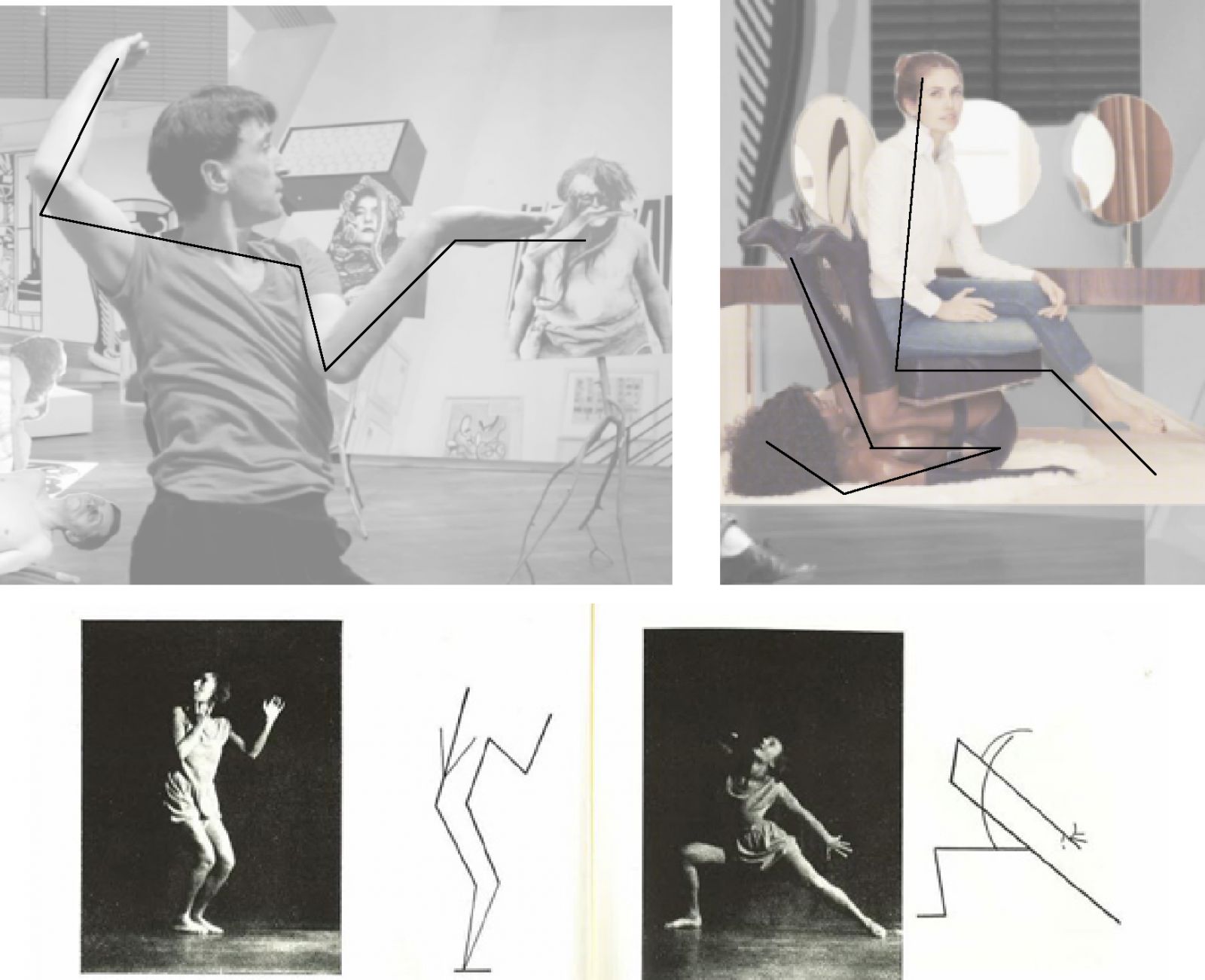
17 | (top) The author’s diagrams on details of screengrabs from Vimeo upload of the performance-film Chicago Comedy (2014): (left) detail of dancing twin’s combination of open and compressed ‘L’ shape forms (danced directly in front of Zhukova cut-out); (right) detail of open and compressed ‘L’shape forms in Zhukova and ‘racist-chair.’ The contrast and luminosity of original stills have been altered in these images in order to emphasize my notations of poses. (bottom) The author-with-Duse association-idea: Wassily Kandinsky’s “Dance Curves: On the Dances of Palucca” originally published in Das Kunstblatt, 1926 (Kandinsky [1926] 2015). Gret Palucca trained under Mary Wigman (Source: German Historical Institute, Washington DC).
A second level of doubling begins when the first level created by the photographer is framed: when framed, the subject and object positions doubled in the photograph become the source of a series of questions. When Macuga “ingests” or “incorporates” [Einverleibung] (Warburg [January 1896] 2011, 107) the “racist chair” photograph into Chicago Comedy by inserting it into the play as a horizontally flipped and magic-wanded cut-out, the viewer begins to ask a series of questions (Fig. 13, bottom right): What is this photograph? Why has it been selected to feature in the comedy? What is the focus of the photograph: is it the two women, or the post-surrealist meeting between a pair of stiletto heels and a high blouse collar (Fig. 12, center right)? Are the two women themselves just the frame for this meeting of accessories-in-motion [bewegtes Beiwerk] (Warburg [1893] 1999; Warburg [1893] 1933)? Or are the stiletto heels and high collar accessories-in-motion [bewegtes Beiwerk] energetically introjecting a frame of their own for the exchange of a triangulation of ‘looks’ (Fig. 13, bottom right) – from the strained attention of the disoriented viewer, to the shielded gaze of the actor, the open-eyed glare of the mannequin and the blank cipher-like stare of the posing socialite?
The doubling between actor and cut-out in the Scene Three (Aby Warburg on Art Money and Politics) “racist chair” sequence “corporalizes” [Verleibung] the pulsations in the exchange of looks among audience and actor, mannequin and mannequin-like socialite. The actor wears dark sunglasses as both a mask and a deflecting device (Fig. 18, bottom right). The sunglasses halt any possibility of audience identification, while simultaneously framing the actor’s ‘look’ to draw attention to the gaze as an object. The ‘real’ mimicking body of the gesturing actor motions to the still cut-out: the dark reflective shades over the actor’s eyes deflect the audience ‘look’ into the glare of the mirrors in the “racist chair” cut-out (Fig. 18). At the center of the empty mirrors is the vacuous gaze of the socialite, which again reenacts deflection in an alternate form: lorded over by the gaze of the socialite and disturbed by her diffidence towards her own political incorrectness (i.e. she is neither ironic, defiant nor clueless, just dis-affected), the searching viewer ends up repeating the impulse that has been codified by the “racist chair” in the strained neck of the mannequin (Fig. 18).
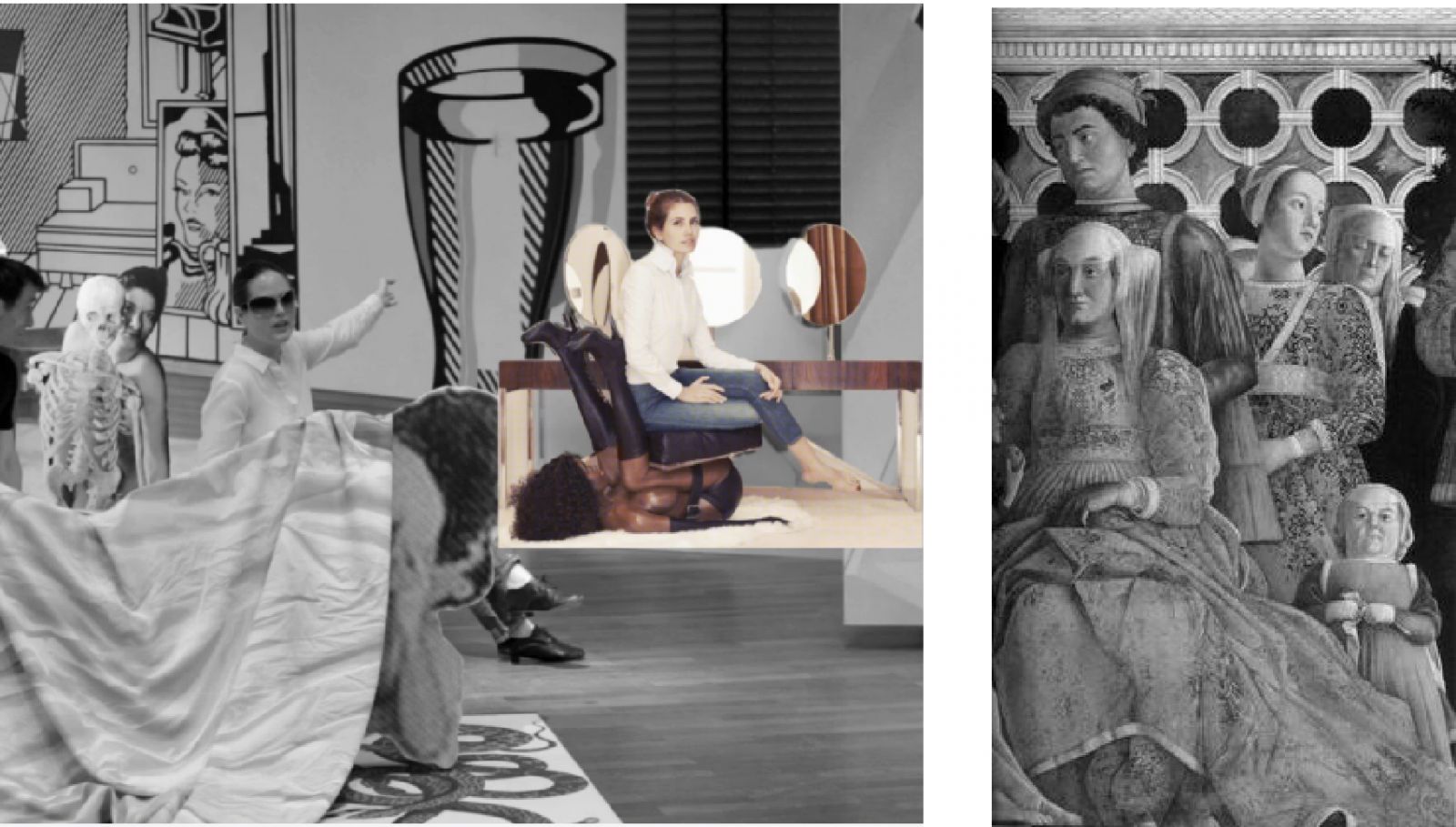
18 | (left) Screengrab from a Vimeo upload of the performance-film Preparatory Notes for a Chicago Comedy (2014), Scene Three (Aby Warburg on Art, Money and Politics): detail, actor imitates cut-out pose, gesturing towards the cut-out from behind artist Andrea Fraser (in bed with “her” collector), next to Marina Abramovic (behind her replica skeleton); dark sunglasses counterpose the direct gaze of the Zhukova cut-out; (right) The author-with-Duse association-idea: (altered in gray-scale) detail of Andrea Mantegna’s Camera Picta in the Mantua Ducal Palace (c. 1460 – 1470), in which the figure of the dwarf on the bottom right employs the same direct gaze out of the picture frame to involve the viewer in a feast scene (Source: SCALA, Florence/ART RESOURCE).
From the mannequin’s strained L-shaped neck, a more complex level of re-doubling occurs in two iterations of the same L-shaped line combined in positive and negative angles: the composite form in the posed socialite and the mannequin is a stair-shape on top of a folded chair-shape (Fig. 17). The stair-shaped L-shape is extended in the socialite’s seated posture and mirrored in the seated pose of the actor-automaton playing the socialite; it is compressed in the L-shaped folded-chair-shape of the mannequin under the socialite (Fig. 17). In this compression, the sculpture of an objectified subject (a mannequin) is objectified yet again as a folded piece of furniture (a chair with a cushion) and then objectified again by being sat on. These levels of compression result in the combination of sculpture and model disappearing altogether: the sculpture of the mannequin becomes a plinth for the encounter between a pair of black stiletto heels and a white high collar; the socialite’s body becomes the shriveling slug in a stiff shirt-shell now transubstantiated into reified ‘marble’ by the sculpture-of-the-mannequin-turned-plinth. In digital culture, the myth of Pygmalion works in reverse and the socialite’s blouse comes ‘live’ as sculpture: animation is triggered not by the meeting of two faces in a kiss, but by the cushion-blocked meeting of two rears blocked in a non-relation (Fig. 17).
The “racist chair” cut-out as it is used in the mise-en-scene and dramaturgy of Chicago Comedy, can be said to be an image of the internet image’s self-reflective self-reflexivity: its doubling folds the repetition of form over the repetition of form (Fig. 17). The “racist chair” turns subject inside-out into substance, and substance outside-in onto subject like a Klein bottle model of auto-phagy or self-ingestion (Fig. 16). Its hyper-reflective surface makes it pseudo-reflexive: the images of three mirrors that only function as reflectors in the photograph, is the model for the digital image itself as pure potential for the infinite replication of “sensation” and the bright flash of “Internet outcry”. In the inner world of these mirrors as they appear in the original fashion photograph, the socialite, Daria Zhukova, evades reflection: she is the image of the living dead, a vampiric flesh-and-bones effigy of herself that cannot be made into an image, because it already is one (Fig. 18). Hence, the “racist chair” cut-out is refractive: its repetition of doubling-redoubling calls attention to a bend, to a change in energetic direction, to a boundary line between realms, from the vampiric (the dead molesting the living, or the mannequin object eliciting human sympathies) to the necrophilic (the living molesting the dead, or Zhukova abusing a mannequin) (Fig. 18, Fig. 17 and Fig. 11).
What the mass media calls “protest” images are examples of the way in which post-race racism decries racism by replicating the same racializing impulse of race theory (Fig. 19): firstly, the white body in photographs protesting the “racist chair” photograph is always a flesh body, not a resin body. In the so-called “gay chair” (Fig. 19, top right) the response is what Fanon called “negrophilic” (Fanon 1967): the blocked non-relation in the original “racist chair” image now becomes a synthesis of triumphant pleasure in which a white artist performs being sat on by a black model (Wyatt 2014). The pleasure in dark skin against pale skin is emphasized by the seated model’s hand framing the touch of scrotum against his thigh (Fig. 19, top right). In the music video for the song Blown Away (2015), rapper Azealia Banks and collaborator GypJaQ stage a “negrophobic” (Fanon 1967) response to the “white fashion world” (Fig. 19, bottom) (Bobb 2015): white bodies “as furniture” are avatars that popular culture reports describe as “nymphs” (Bobb 2015) and which are sat on by a gender-hybrid shape-shifting monster (i.e. in close-ups the faces of the female Banks and male GypJaQ are morphed into each other) of the mannequin-made-flesh, now returning the favor of subjugation, but only in a virtual threat: the white “nymphs” as furniture are the result of what appear to be green-screen effects (Fig. 19, bottom).
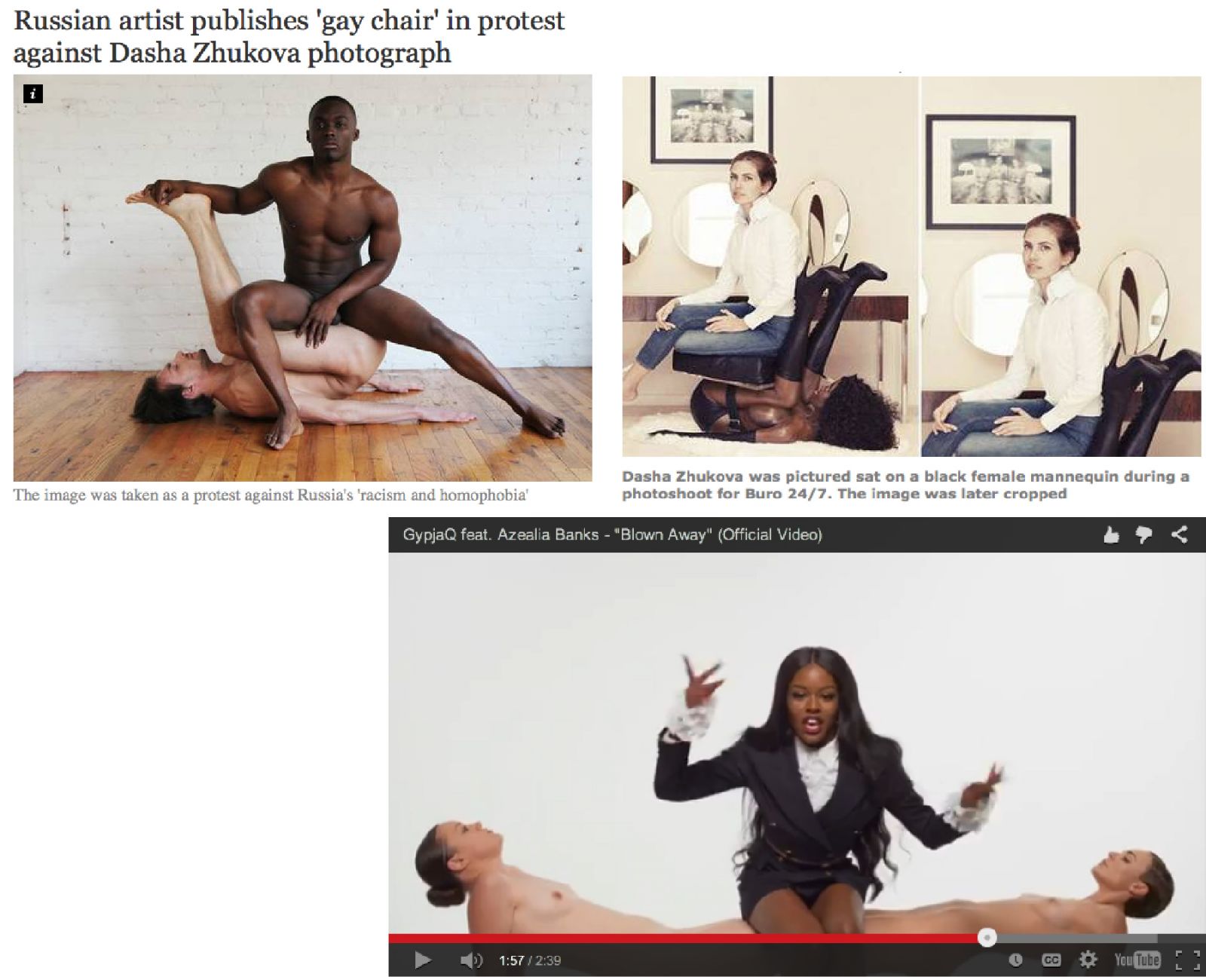
19 | The author-with-Duse association-idea: (top) Screengrabs from The Independent, January 29 2014. The article recounts how, after the “internet outcry”, the “racist chair” image was cropped in the online fashion magazine Buro 24/7 where it was originally published (Wyatt 2014) (Source: The Independent). After the original image was cropped to remove the bondage manikin, a “protest” image was produced. In the “protest” image, the same dynamic at work in the original image, replicates itself for further circulation: images “affect (…) imagination like a kind of yeast” (Warburg [1923] 2004, 309); (bottom) Screengrab of the music video for Blown Away, 2015, by Azealia Banks and GypjaQ (Source: Youtube).
The mannequin is humanized in “Internet outcry” and the socio-symbolic body of the oligarch is dehumanized: however, in this post-race refraction, triumph lies in neither black or white positions, but in the replication of racialization which is not broken through catharsis in the so-called “protest” images, but carried over into digital culture for repetition. The refraction affect in the “racist chair” cut-out is prismic (Fig. 14 and Fig. 19): the ‘plastic’ synthetic quality of polished ‘real bodies’ (the socialite’s vampiric pose) is bent in a hologram of rainbows (the illusory delusions produced by a race-based class system) into the humanization of actually plastic bodies (empathy felt for a display mannequin). The image is a kaleidescope of symbolic untouchables –the plastic pristine queen of the wealthy ‘one percent’ in the Russian oligarch over the dark danger of an inter-class inter-race same-sex encounter in a blocked iteration of Pygmalion. This fractured synthesis is a combination of natural and unnatural “accessories-in-motion” [bewegtes Beiwerk] (Warburg [1893] 1999; Warburg [1893] 1933): the humanist contortion in the polymer-based mannequin’s limbs; the plastic vampiric in the socialite’s sporty daintiness; the mannequin’s expansive wig against the shag carpet; the plastered gleam of the socialite’s slick up-do against the glare from her vanity-mirrors-as-reflectors. The mannequin is humanized in a world in which the human is plastic-past and the trans-human is furniture: triumph is defeat and defeat is triumph.
Interlude: A Transition Before Revisiting Warburg’s Hamburg Art Conversations (1896)
Yes, I want to seen an Indian. I have now been to America twice and didn’t see one Indian. (…) maybe the manager of the railroad can have some Indians waiting for me at some place, at one of the railway stations. Will you please tell him?
German dancer Mary Wigman interviewed during her American travels by the Morning Oregonian, 1932 (Wigman 1975, 150)
Why should a dancer use a mask? Always when his creative urge causes a split process in him, when his imagination reveals the image of an apparently alien figure, which, as a part of his totality, compels the dancer to a certain kind of metamorphosis. (…) The mask tries to blur the demarcation between the realistic and irrational levels. It can wipe out the shape of a human face and turn it into ghostlike features through schematic interpretations, or it can conjure up demonic features of man’s darkest fantasy in its exaggeration of any meaningful form.
- Mary Wigman on the use of masks from Das Mary Wigman-Werk, 1933 (Wigman 1975, 121)
We emerge from our whirlpool, “eel soup style” [Aalsuppenstil], and take a breath. Ask an Internet search engine about Macuga’s Preparatory Notes for a Chicago Comedy and our twenty-first century Delphic oracle reveals yet another comic double: not only are choreography, theatrical montage and animated collage between the comedy's ‘lines’, but there is also another story altogether. This story is an alternate atlas of memory objects, places and gestures, improvised in Chicago streets through the residency program curated by Roelstraete that hosted Macuga's production of the Chicago Comedy:
a former bakery later home to Playboy Enterprises corporate offices;
a tenth-floor artists colony decorated in gold leaf Art Nouveau;
a typewriter that belonged to architect Frank Lloyd Wright;
a doodle on a Lenin Red Star pin;
a bronze monument to the Prussian explorer Alexandre Humboldt;
the grave-marker of Chicago-based Hungarian expatriate Laszlo Moholy-Nagy;
the concrete tower of the Cook County Jail;
a mural painting of Saint Theresa between South Carpenter and South Allport streets;
a forty foot tall neo-constructivist sculpture titled Chevron;
a tattoo of Pieter Bruegel’s The Blind Leading the Blind;
two Afghan visa stamps on Goshka Macuga’s passport;
a platter of breaded shrimp;
and a book on Aby Warburg titled Between Tradition and Modernity (MCA 2013-14).
This blogged Internet itinerary recorded by Macuga and her host institution the Museum of Contemporary Art, Chicago (MCA) ends by leading us back to where we started: what is “tradition” and what is “modernity” in the world of twenty-first century art? Macuga's Chicago Comedy is the twenty-first century taking a self-conscious ‘selfie’ of itself as ‘contemporary’: the result is an image of being-with-time (con tempo) that fakes-the-finite (con (as in con-man) temporary, as in the delusive defeat of racism in the post-racial era). The precarious ‘traditions’ of what we call the ‘contemporary’ are the “unthinking repetition of motifs” [gedankenloser Wiederholung äußerlich gesteigerter Bewegungsmotive] that have come to be associated with modernity (Warburg [1893] 1999; Warburg [1893] 1933]: the principle example we have highlighted here is the modernist motif of black-and-white colorism.
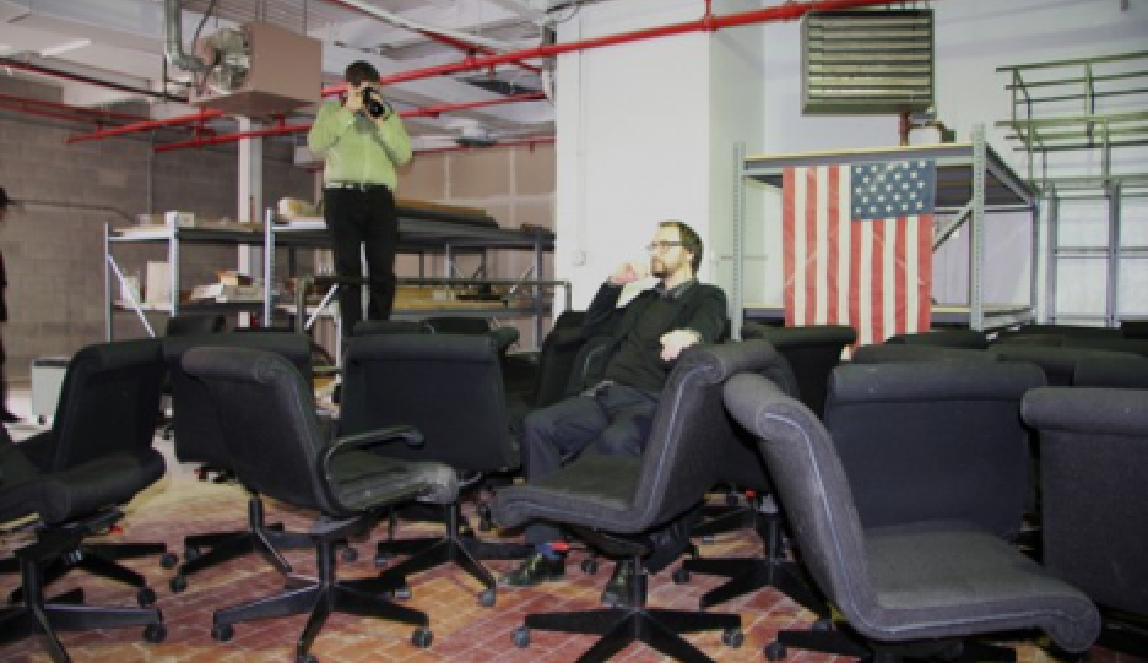
20 | Macuga and Roelstraete in a warehouse filled with chairs: snapshot by a researcher who accompanied Macuga and Roelstraete during their Chicago itinerary (MCA 2013 – 2014) Posted on the Museum of Contemporary Art Chicago (MCA) blog of Macuga’s residency (Source: MCA).
And so, what better way for Chicago artist-in-residence Macuga and MCA former curator Roelstraete to perform themselves than as symptoms of “contemporary” new Europe in America, that is, than by improvising an irreverent update of Warburg's fetishized atlas, Mnemosyne, in their own version of Warburg’s “Reise in America” (Journey to America) (Fig. 20)? The modernist historian from Hamburg, Aby Warburg, toured the American Far West and found the “expression for [a] psychological law” [Ausdruck für mein psychologisches Gesetz] in New Mexico [“Verleibung” or “corporalization] that seemed to answer his sociological questions about the nineteenth century afterlife of sixteenth century Florence (Warburg [January 1896] 2011, 107); in the parallelism they stage, a Polish artist and a German curator tour the American Mid-West for a psychological aesthetics of the twenty-first century capable of posing new questions about how the unconscious is being re-shaped by the Internet image search. Macuga and Roesltraete improvise a tour of Chicago streets as amateur ethnographers and collectors of snapshots, intentionally looking for Warburg in all the wrong places.
In the course of production of Macuga's Chicago Comedy, Macuga and Roelstraete made snap-shots of the Chicago cityscape, less for the purpose of making actual pictures, than for the aim of inciting what Warburg called association-ideas [AssociationenIdeen] (Warburg [April 1891] 2011, 78) and sensorial impressions [sinnlichen Eindrucks] (Warburg [January 1896] 2011, 107). None of the ‘points’ collected from the Chicago itinerary actually feature in the Chicago Comedy. Instead, the itinerary was a way of producing ‘intervals’ – daydreams that could be pulled apart and reconstructed into a feverish delirium called Chicago Comedy. The only Chicago photographs that actually appear in Chicago Comedy are the backdrops of the set – the photographs of the living room, bedroom and hallway from three homes of Chicago collectors. The other Chicago snapshots – and the itinerary that connects them – are embedded in plain view in a blog produced by the MCA to track the sojourns of its artists-in-residence.
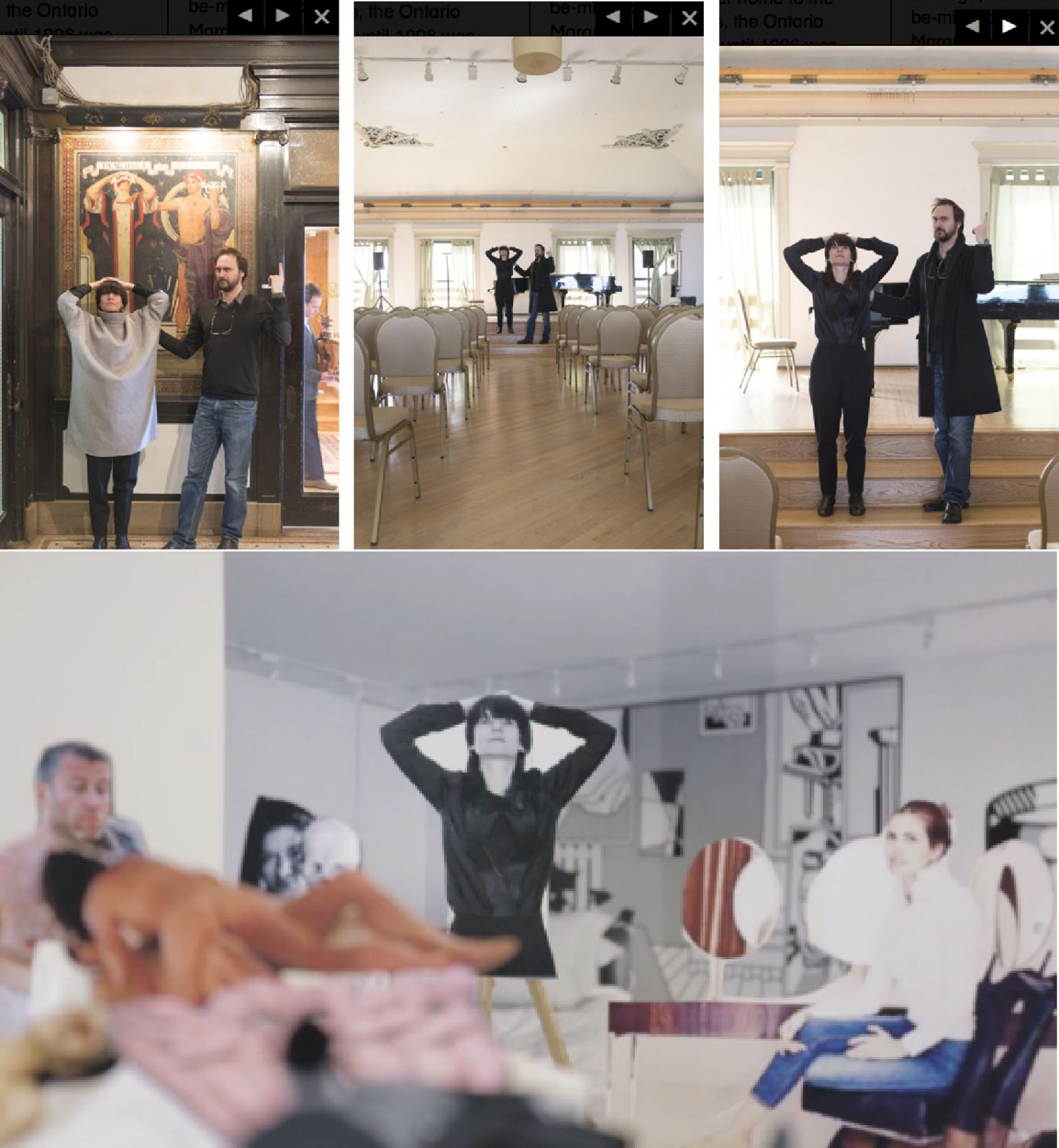
21 | (top) Screengrabs from the blog produced by the Museum of Contemporary Art Chicago for Goshka Macuga’s residency (2013 – 2014). Snapshots are from post titled “April 26, 2013: 237 E Ontario, 410 S Michigan” (MCA 2013 - 2014); (bottom) Maquette from Chicago Comedy (Source: MCA).
One of the posts on the MCA blog records Macuga and Roelstraete visiting the tenth floor mural project of the historic ninteteenth-century Fine Arts Building on 410 South Michigan Avenue, which advertises itself to tourists as “The Nation's Oldest Artists' Colony” (Fig. 21, top). According to the MCA blog post, rented studio spaces in the Fine Arts Building hosted many of the designers who were involved in working on architect and urban planner Daniel Burnham’s World’s Columbian Exposition in 1893. In the snapshot taken by an accompanying researcher, Macuga and Roelstraete stand in front of an Art Nouveau mural and mimic its figures posed as comedy and tragedy. Elsewhere in the building, they repeat these gestures and the accompanying researcher photographs them again (Fig. 21, top). In a maquette for the Chicago Comedy that was filmed for an interview with Macuga posted to the MCA blog, a cut-out made from this pose is inserted into plans for the Chicago Comedy’s set (Fig. 21, bottom).
The gesture is the performance-unconscious or what Grotowski might have called the “in/pulse” of the so-called “mirror dance” and “vogue-ing” choreographies produced by Macuga and collaborators for the dancing twins in the Preface and Scene One (Aby Warburg on Technology) of Macuga's Chicago Comedy (Macuga and Roelstraete, Scene One, 2013). The gestures of tragedy and comedy mimicked by Macuga and Roelstraete do not directly re-appear in performance, rather the choreographies appear to have developed out of them through processes of improvisation and composition (Fig. 21). Taxi cab rides and city walks across the urban landscape similarly improvise ‘points’ and produce compositional ‘interludes’ not for the sake of generating content, but for exercise in creating connections. The itinerary “corporalizes” [Verleibung] (Warburg [January 1896] 2011, 107) repression in the Internet image search: it embodies how the internet image search presents itself as a pragmatic tool for getting answers, while all the while its fundamental function is to facilitate hyper-active connections in a quest of random queries for the pure pleasure of generating riddles.
PART TWO
Consummation for a Continuous Whole: The Danger of “Abbreviation” in the 21st Century
The mask never can and never ought to be an interesting addition or decoration. It must be an essential part of the dance figure, born in a world of visions and transported as if by magic into reality. The mask extinguishes the human being as a person and makes him submit to the fictive figure of the dance. The mask is merciless and does not tolerate any deviation (…). It is felt in its living silence and its demands. As soon as the dancer has fully recognized it, the mask begins its reign of dictatorship. (…) It breathes and lives like a living face within its frozen form.
- Mary Wigman on the use of the mask, 1933 (Wigman, 1975, 121 – 122)
In art historian Ernst Gombrich’s Aby Warburg: An Intellectual Biography (1970), the 1896 amateur playlet Hamburg Art Conversations written by Warburg (and used by Macuga and Roelstraete to create the Chicago Comedy), is interpreted as evidence of the German-Jewish Warburg’s attempts to gain social distinction among “progressive” Protestant peers, in particular his future wife, sculptor Mary Hertz (Gombrich [1970] 1986, 93). The “progressives”, as Gombrich describes them, were conservative liberals, or centrists, who aligned themselves with what turn-of-the-century aesthetic debates referred to as “idealism” (Gombrich [1970] 1986, 92). For Gombrich, “idealism” between “realism” and the “decadent movement” was a reconciler of sorts, a flexible adaptation of “progressives” who held that art was “an instrument of enlightenment and emancipation” (Gombrich [1970] 1986, 93). In Gombrich’s interpretation of Warburg’s Hamburg Art Conversations, Warburg is said to have shared the “bias for Impressionism and Realism” with “progressives” (Gombrich [1970] 1986, 93).
Gombrich doesn’t go into great detail justifying this interpretation, however, he defends his assertions with brief mention of a phrase about the “playlet” that Warburg is said to have written on Mary Hertz’s copy of the New Year’s Eve party script: “the same idealism (…) is expressed in the note he [Warburg] scribbled on his copy [of the playlet] for Mary Hertz: Justice, Air and Light also for the moderns, Progress in Abbreviation” (Die Gerechtigkeit, Luft und licht auch fur die Moderne, Der Fortschritt in der Abkürzung) (Gombrich [1970] 1986, 93). This, what we might call – using the language of artist and theorist Piet Mondrian – 'plasticism' of explosive destruction in minimalist consummation – what Gombrich calls “the reduction to essentials” of an “art of omission” (Gombrich, [1970] 1986, 93) – is what is said to characterize Warburg’s conception of “idealism” in the late nineteenth century: in other words, “idealism” for Warburg – even according to Gombrich – is the aesthetics of less-is-more. In Gombrich’s account of Hamburg Art Conversations (1896), it is an exhibition of Swedish painter and printmaker Anders Zorn’s etchings that is responsible for provoking the debate Warburg stages in his playlet (Gombrich [1970] 1986, 94). The etchings of Zorn are provided as a principle example of “idealism”, what “conservatives” despise as “modern stuff” (Gombrich, [1970] 1986, 94).
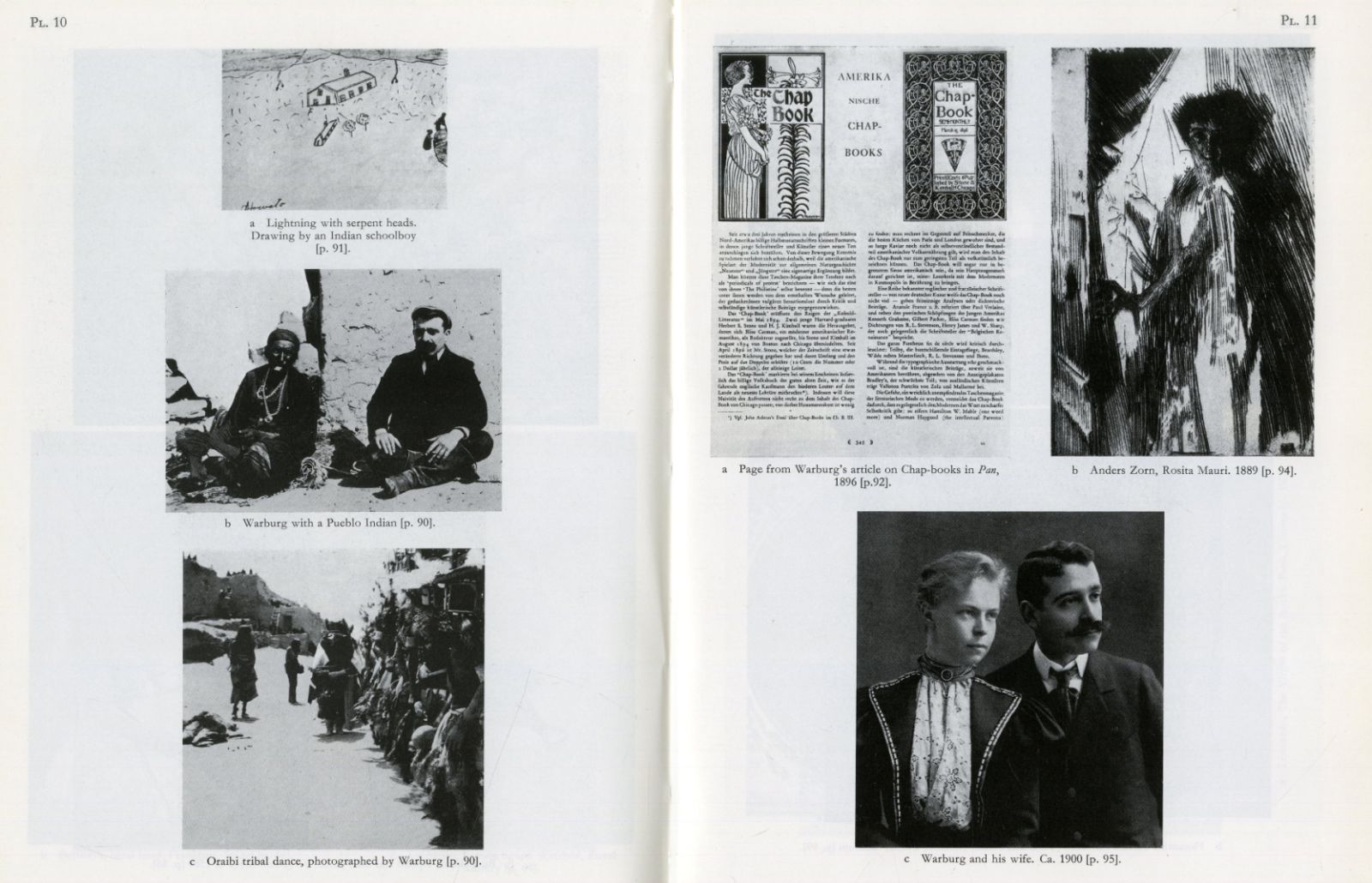
22 | A two-page spread from the sixty-five plate section of image reproductions featured at the end of Gombrich’s 1983 intellectual biography of Warburg. Plate 11 features a photograph of Warburg with future wife Mary Hertz (image ‘c’; bottom center), an etching by Anders Zorn (image ‘b’; top right) and the first page of Warburg’s article on American chap-books (1897) as it was published in the German magazine for print connoisseurs, Pan (image ‘c’; top left). Plate 10 on the right features a drawing from an exercise Warburg staged with Hopi school children (image ‘a’; top), a photograph taken of Warburg with an unnamed Pueblo man (image ‘b’; center) and a snapshot taken by Warburg of an antelope dance in Oraibi (image ‘c’; bottom) (Source: Gombrich [1970] 1986, Plate 11).
The particular Zorn etching selected to represent Zorn’s work in Plate 11 of Gombrich’s configuration of illustrations at the end of the intellectual biography is odd (Fig. 22) (Gombrich [1970] 1986, Plate 11). According to Gombrich, it is the etching of a landscape that triggers the debates at the center of the playlet: crystalline contour versus sketchiness, or clearly delineated contours versus abbreviated dynamic “scribble” (Gombrich [1970] 1986, 94). Zorn was, indeed, known to art connoisseurs as the master of “strong slashing lines” (Bibb 1895, 133) and “slashing strokes” (Richter 1914, 136), however, he is generally considered a portraitist and is not known for his landscapes. Interestingly for the present essay (which has attempted to bring together Warburg’s earlier fragmentary draft for a playlet on Italian actress Eleonora Duse and his later playlet Hamburg Art Conversations (1896)) the etching Gombrich features in Plate 11 is, in fact, the portrait of a performer: Catalan ballerina Rosita Mauri y Segura (1850 – 1923) posed in what looks to be a drawing room (Fig. 22).
In Warburg’s playlet – as it is retold by Gombrich – a young artist and his fiancé’s uncle, a proud art connoisseur, argue over “abbreviation”: for Uncle Eduard, the “sketchiness” in question is “ugly” and not “true art”, only “confused scribble” (Gombrich [1970] 1986, 93 – 94) For the artist, “the very abbreviations of (…) line [that the uncle contests] constitute the progress in [the artist’s] style” (Gombrich [1970] 1986, 94) Uncle Eduard responds to the artist’s appreciation of “abbreviation” by challenging him to a competition of eyesight; the artist responds stating that, indeed, Uncle Eduard surely must have better eyesight than he. In fact, for the artist, Uncle Eduard’s problem is that he sees all too well – he “sees too many details and (…) these petty details are destructive of the emotive mood of the landscape” (Gombrich [1970] 1986, 94) Uncle Eduard retorts that the “modern” “insistence” on “moods and mists” is “morbid” (Gombrich [1970] 1986, 94).
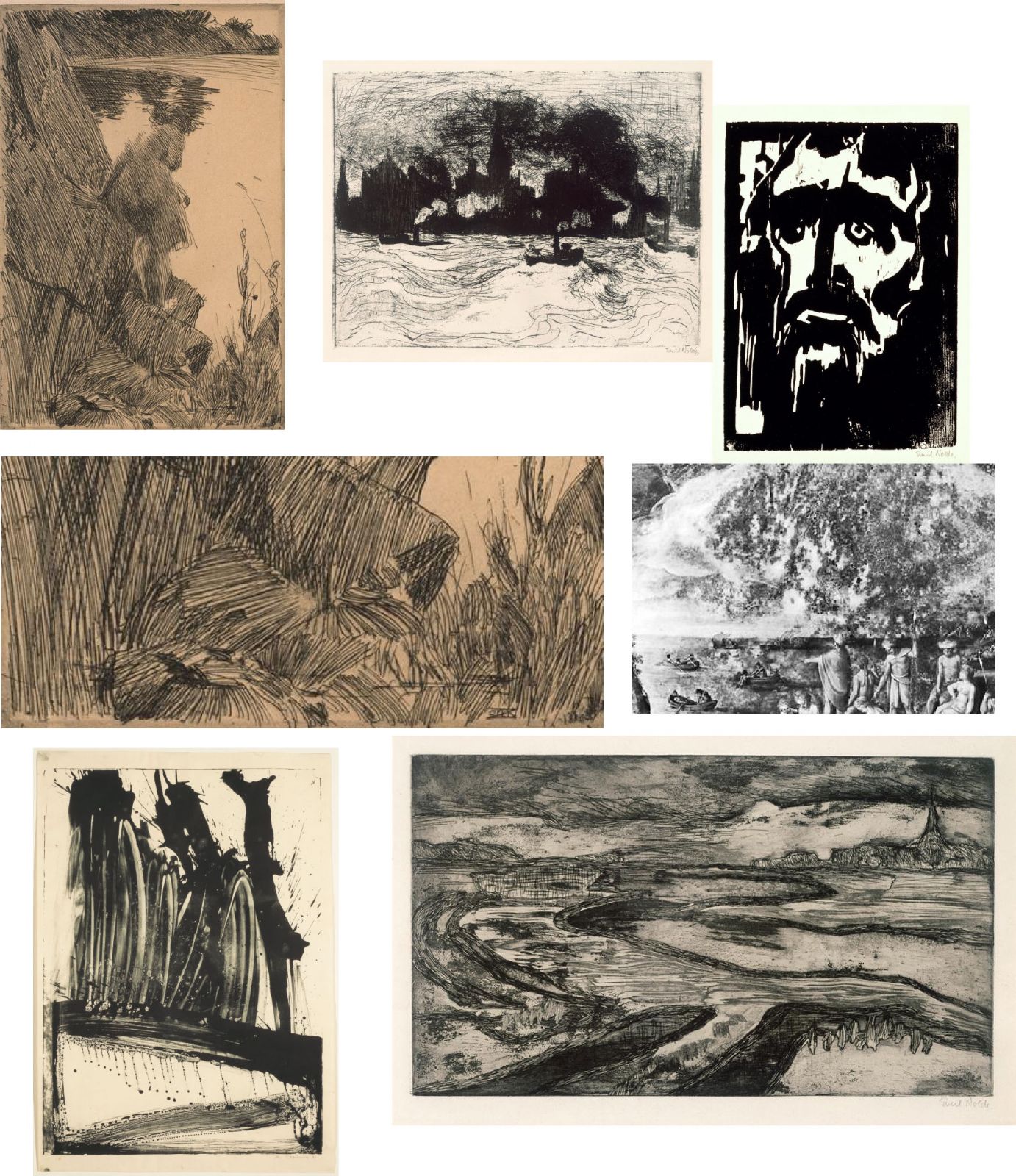
23 | Configuration of images to assist in imagining the unknown masterpiece in Warburg’s playlet: (top left) Anders Zorn’s Badende (Abend) III, 1896 – a Zorn etching in which landscape is dominant; (Source: bpk / Kupferstichkabinett, SMB / Volker-H.Schneider); (top center) Emil Nolde’s Hamburg, Binnenhafen, 1910 – an etching that Warburg’s correspondence indicates he may have seen in 1910 (Source: bpk /Volker-H.Schneider); (top right) Emile Nolde’s Prophet, 1912 – a woodcut Warburg’s son, Max Adolph, asked for as a gift from his parents in 1921, because it reminded him of his father (Source: Erich Lessing/ART RESOURCE); (center left) detail from Zorn’s Badende (Abend) III; (center right) detail from Antonio Tempesta’s oil on lapis lazuli, Pearl Fishing in the West Indies, 1600-1620 – Warburg was interested in Tempesta’s engravings (Source: Image of the Black in Western Art Photo Archive); (bottom right) Emile Nolde’s Überschwemmnung, 1922 (Source: bpk / Volker-H. Schneider); (bottom left) Willem de Kooning’s Litho #2 (Waves #2), 1960, a lithograph in the collection of the Art Institute of Chicago (Source: Art Institute of Chicago).
According to Gombrich, a real “crisis” is about to ensue when the artist brings the works of eroticist Max Klinger and symbolist Arnold Bocklin into the debate, and the mother of the artist’s fiancé gets involved in the dispute (Gombrich [1970] 1986, 94). At a timely moment – when tension has built to a considerable level – the artist decides to make an incisive ‘point’: he presents his future in-laws with a gift of one of his own paintings. The painting is a landscape created with the very kinds of marks that Uncle Eduard had argued against, however, this painting with “abbreviations” also includes a “meticulous representation of a picnic” (Gombrich [1970] 1986, 94). We know that the gift is a “disfigured” version of another painting – an unknown masterpiece – because Gombrich recounts what the artist whispers in aside to his fiancée: the gift is really a copy of another painting. The artist has preserved the more radical painting of abbreviated marks in its original state.
In Warburg’s letters, he writes of his appreciation for the “clouds” and “landscapes” of expressionist painter Emil Nolde, and there are also records of Warburg’s son, Max Adolph, asking his parents to buy him a Nolde woodcut (Prophet, 1921) because it reminded him of his father [24]. Using the Chicago Comedy stage set of Mnemosyne-like compositions inspired by Warburg as our model, the fictional painting that we might end up imagining as the Frenhofer-like unknown masterpiece of Warburg’s playlet is something akin to an anachronistic cross of the following (Fig. 23): an abstract expressionist lithograph by Willem De Kooning (1960), a hybrid Dutch-Spanish-Roman baroque in oil on lapis lazuli by Antonio Tempesta (c. 1620s), a Nolde etching of the Hamburg port (c. 1920s), and Zorn’s portrait of a bather (c. 1890s).
The result of this dramaturgical hallucination is mannerist and expressionist, not the realist and impressionist “progressivism” discussed by Gombrich. The unknown masterpiece of Warburg’s playlet might only be considered neo-realist and neo-impressionist if: first, we think about realism in critic Clement Greenberg’s terms as the pictorial plane becoming aware of its own flatness; second, if we think about impressionism in expressionist terms, as the paradoxical re-embodiment of retinal art through impressionism’s transformation of the painter’s body into a hovering eyeball. If the “disfiguration” of the unknown masterpiece in Warburg’s playlet is characterized by the addition of a meticulous picnic scene, it is as if the playlet is ironically suggesting we imagine the playlet ending exactly where it began, that is, with a painting that is the equivalent of Zorn’s Badende (Abend) III (Bather (Evening) III, 1896) only without the figure of the standing central bather (Fig. 23). In the synthesis of thesis and antithesis, antithesis is thesis and thesis is antithesis. Change is only an illusion.
If carried to its extreme consequences into the present day, the analogy for the dangerous “abbreviations” of the industrial age’s slashed marks in the information age’s semio-capitalist iconosphere, are the easily searchable, downloadable, tag-able, and connectable images available online. Thus, the twenty-first century moralizing of Uncle Eduard against the “abbreviations” of “modernism” is the equivalent of the contemporary historian of art who challenges works like Macuga's Chicago Comedy by protesting, “works of art need to do more than be three-dimensional iterations of Pinterest and Tumblr” (Bishop 2013). The late nineteenth-century discourse of the “conservative” Uncle Eduard against Zorn, is the equivalent of early twenty-first century critiques of Macuga’s work by “radical” historians of contemporary art.
How is it that an early twenty-first century historian of contemporary art writing from a “radical” position (Bishop 2014) about Macuga ends up repeating the argument of the “conservative” Uncle Eduard when he accepts the painter’s gift in Warburg’s playlet? “I would defend a place for visual research”, writes the twenty-first century historian, “but it’s a fine line between presenting research for a work (in all its disconnected, inchoate fragmentation) and a researched work (where the juxtapositions evidence more than simply effort)” (Bishop 2014). Similarly, for Uncle Eduard, it is a fine line that separates “true art” from the “mist” of the “morbid” “modern”, or abbreviation-for-abbreviation’s sake (Gombrich [1970] 1986, 94). Art is kept “true” as long as there is a unifying gesture that that makes an integral whole, a gesture by way of which the challenge of “impressions” that “overwhelm”, are made to serve the function of “atmosphere” so that “the eye and the senses are cheered by agreeable ideas” (Gombrich [1970] 1986, 94).
There is a distinct difference between the unifying gesture that makes an integral whole, and Shaw’s “consummation” of the “continuous whole” (Shaw, Two Plays, 1895, 758). We might assert that this is also the difference between Macuga’s new neo-plasticism of hyperspace – its disassociated engagement with the psychological aesthetics of social media image-dumps – and the user of Tumblr and Pinterest addicted to social media like-ing, friend-ing and data-mining. The former takes advantage of the latter, but its use of mise-en-abyme distances it from “unthinking repetition” [gedankenloser Wiederholung] (Warburg [1893] 1999; Warburg [1893] 1933). Furthermore, on a more level it can also be said that the space of the set in Macuga's Chicago Comedy is actually just barely “three-dimensional”: the set never quite expands digital images beyond the flattened placard silhouette. If three-dimensionality were the goal, why did Macuga not choose to populate her stage with carved wood and fiberglass effigies fabricated like her sculpture Madame Blavatsky (2007) (Fig. 24, top)? Chicago Comedy avoids the in-the-round sculpture and instead privileges the stage as an n-dimensional space of “mental and physical ingestion” [Einverleibung; Einverseelung] (Warburg [January 1896] 2011, 107; Warburg [1929] 2000; English translation, Siemens 101) in which identification, imitation, association-ideas, sensorial impression and introjection come together amidst hallucinatory after-images, overlay animation, cut-out contours, plotter prints, a single plaster cast (what appears to have been the museum’s model of the Laocöon), dancing bodies and recitation.
Macuga's Chicago Comedy is an ironic new materialist transcendentalist approach to the gap between neurobiology and psychoanalysis – between metastasizing tangles of “mirror neurons” (neurobiology) (McKay 2014) and a child in the Lacanian “mirror stage” (Elsaesser and Hagener 2015, 72) seeing herself for the first time surrounded by objects in a “selfie” posted by her parents on Facebook. It is interesting that by being “loosely-based” (Macuga and Roelstraete, Preface, 2013) on Warburg’s amateur playlet, the Chicago Comedy ends up revealing much about what Warburg called in his March 1896 San Francisco note the “‘artistic’ act” [“kunstlerische” Act] of “Enternungsversuch” (or the “attempt at distancing”) in Befühlung, a visuo-haptic sense of “palpitating” [abtastender] and “outlining” [umschreibender] (Warburg [March 23 1896] 2011, 109) – or rather, what in contemporary continental philosophy has been referred to as the way “socio-symbolic mediators penetrate and alter the realities of the body” (Johnston 2013, 170). Warburg would have called this part of the process of Hinein[Um]verleibung (corporal introjection) (Warburg [January 1896] 2011, 107).
In the “semio-capitalist” iconosphere (Berardi 2011), the visual challenge of ‘abbreviation’ is no longer the slash mark but rather the overabundance of connections produced by a cut-and-paste culture of viral image assocations. It is precisely the fine line between social-media image dump sites like Pinterest andTumblr, and Warburg’s atlas project Mnemosyne, that what has been called the “citational art” or “retrospectivity” of Macuga’s projects inhabits (Bishop 2013). This in-between space is what Warburg, in his own re-mixed mash-up of Goethe quotations, referred to as “the problem lying in the middle” [das problem liegt in der mitte]: “the truth in the middle” [die Wahrheit mitten inne] is “the problem lying in between, the unintuited” [Das problem liegt dazwischen, Unschaubare], “the problem (…) impenetrable, perhaps but also perhaps approachable, did one only go the right way about it” (Warburg [1907] 1933; Warburg [1907] 1999); Warburg [1918] 1922; Warburg [1918], 1999).
But what is the “right way” to this inbetween in the middle? Warburg suggests “the observation of attempts at reconciliation” [Ausgleichsversuche (…) nicht zu beachten] (Warburg [1907] 1999; Warburg [1907] 1933): such attempts are the core of a “problem of energy” [das energetische Problem] in which the “unintuited” [Unschaubare] of “eternally active Life” [das ewig tätige Leben] acts out (Warburg [1907] 1999; Warburg [1907] 1933). Contemporary moralizing by historians about what art “needs” to do marks one such “attempt at reconciling” [Ausgleichsversuche]: by “observing” [beachten, as in noticing or paying attention to something] we can begin to inquire into why Macuga’s aesthetics of ‘abbreviation’ has caused its own ‘outcry’ among some historians and critics. Is there something in Macuga's Chicago Comedy that has intuited the so-called “misfelt feelings” that Freudian psychoanalysis struggled to write about, that the psychoanalysis of Jacques Lacan left open for theorization (Johnston 2013), and that Warburg’s Grundlegende Bruchstücke – between a “monistic psychology of art” and a “pragmatic theory of expression” (Ghelardi 2012, 50) – and his atlas Mnemosyne mise-en-abymes perhaps had him make himself into his own case study to “corporalize” [Verleibung] (Warburg [January 1896] 2011, 107)?
Gombrich’s interpretation of Warburg’s playlet is short and succinct: for him Hamburg Art Conversations (1896) is a “personal document” that:
reveals (…) the way artistic, social and moral issues were seen at the time to intertwine. Modernism equals emancipation, the fight against the narrow and stuffy milieu of a complacent bourgoisie. The same conventions that stood in the way of Warburg’s courtship [of Mary Hertz] also blocked the progress of art [my emphasis] (Gombrich [1970] 1986, 93).
This introduction to the feeling of being ‘blocked’ that Gombrich interprets as driving Warburg’s creation of the playlet, unfortunately stops short of any further analysis. Let us attempt to carry it further. This ‘blocking’ is the barricading of channels that facilitate associations and connections. If we assume, like Gombrich and Warburg scholar Mark Russell – the only scholars aside from Macuga’s collaborator, Roelstraete, who have taken Warburg’s Hamburg Art Conversations (1896) seriously as a substantial object worthy of socio-symbolic analysis – that Warburg’s authorial voice is also the voice of the painter in Warburg’s playlet (Russell 2006, 158), and that, therefore, Warburg is strictly identifying with the figure of the artist, then we would also have to attribute to Warburg the critique of Uncle Eduard who is accused of seeing too many details, “details” that are “destructive (…) of emotive mood” (Gombrich [1970] 1986, 94).
Gombrich does not notice, however, that Warburg cast himself as Uncle Eduard, and though Russell does notice this fact, he still maintains Warburg’s fundamental identification with the character of the painter, Alfred Runge (Russell 2006, 168). Excessive attention to detail, however, is an aspect of Warburg’s scholarship often cited as contributing to his difficulties making integral wholes of scholarly arguments for circulation among peers. As Gombrich writes, Warburg was remembered by those who knew him for his “insistence on scholarly probity summed up by the adage, ‘Der liebe Gott steckt im Detail’ (God dwells in minutiae)” (Gombrich [1970] 1980, 13). Warburg’s Mnemosyne notes show his principal interest was in Zwischenräumen, or intervals, the transitions of continuous wholes or the “eternally active life” [das ewig tätige Leben] of the Unschaubare or unintuited, in-between [dazwischen] (Warburg [1907] 1999; Warburg [1907], 1933). What Gombrich calls Warburg’s frustration with being “blocked” is anxiety [phobia] over the “in-between” [dazwischen] in the “middle” [Mitte] he calls the “problem of energy” [das energetische Problem] in the “unintuited” [Unschaubare] (Warburg [1907] 1999; Warburg [1907] 1933).
And indeed, this is the in-between in the middle that we have shown that Macuga’s Chicago Comedy incessantly fills with embedded fracture after embedded fracture, with “playful-play”-in-a-performance-film, with mise-en-abyme after mise-en-abyme: with stage frame within museum frame, within video frame, within Vimeo frame, within gallery frame. In this “Enternungsversuch” (attempt at distancing) (Warburg [March 23 1896] 2011, 109) by an infinite echo of mise-en-abyme, the impulse is to avoid “reconciling” (Warburg [1907] 1999) – to avoid allowing this in-between in the middle of the unintuited to be sewed shut. Frames within frames within frames are the reason that the so-called “racist chair” incident as it is re-presented in Macuga’s set, evades reification as a symbol of racism or a fetishized semio-capitalist sign of victimization. Instead, the “racist chair” event is retained and restaged in Chicago Comedy in its state as object of “Internet outcry” or “sensation” (Riaz 2013; Walzer 2013; Wyatt 2014; Lidbury 2014; Bobb 2015): rather than being lamented as an object of “shame” (Riaz 2013) it is taken seriously as a historical object of comedy between tragedy and farce, but its power is deflected so that its colorist motif is not unthinkingly repeated.
‘Outcry’ is a symptom of symbolic affect: the chair itself is not “racist”, journalists explain, “its art” (Jones 2014). But how should we understand this “it’s not racist, it’s art” argument in terms of the problems of socio-symbolic energy the “racist” act and the “‘artistic’ act” involve? Melgaard’s Chair (2012) acts as a trigger that generates instance after instance of racialization when photographed and circulated online. Every protest reaction to the chair is its own variety of “racist” act – either negrophobic or negrophilic (Fanon 1967) – thus, every oppositional response ends up replicating the problem of energy that generates racialization. The psychodynamics of color-driven philias and phobias are not consequences of ideas about something called ‘race’: they are the very symbolic processes at the root of philias and phobias that generate the idea called ‘race’. In other words, if not being a ‘racist’ means not discriminating against ‘races,’ then anti-racist protest unintentionally upholds regimes of racialization, for it does nothing about the way “socio-symbolic mediators penetrate and alter the realities of the body” (Johnston 2013, 170) in the theory of race. The difference between racism and racialization is significant for psychological aesthetics since the “unthinking repetition of motifs” (Warburg [1893] 1999) in black-and-white colorism “coroporalized” (Warburg [January 1896] 2011, 107) in race theory can be considered among the foundational problems of symbolic processes in modernism. The discourse over not discriminating against so-called ‘races’ promoted by “attempts at reconciling” [Ausgleichsversuche] reveal an “inner psychic blindness to the problem of energy in the middle” [eine innere Seelenblindheit für das energetische Problem in der Mitte] (Warburg [1907] 1999; Warburg [1907] 1933) the problem of “corporalization” [Verleibung] (Warburg [January 1896] 2011, 107) of socio-symbolic colorism.
The End: To Break Free of the Circle and Become Square!
It has been the aim of the present essay to experiment with Duse’s performance aesthetic in order to write our way into a “consummation” of a “continuous whole” (Shaw, Two Plays, 758) between “violently pulled together, witty comparison” [kein gewaltsam berangezogene pikanter Vergleich] (Warburg [1900] 2012) and the spontaneous result of “constitutive metaphor.” [eine wesensgleiche Metapher] (Warburg [1900] 2012). Our objective has been to work between the consequences of intersubjective relations – that is, of the subjective will of artists, curators institutions and patrons – and the “ludic drive” [spielender Gestaltungstrieb] (Warburg [1900] 2012) of “playful play” (Macuga and Roelstraete, Preface, 2013) in inter-objective exchanges, or rather, what Warburg theorized in San Francisco as object and subject positions nesting within and spiraling around each other among objects (Warburg [March 23 and March 25 1896] 2011, 109).
In the middle of his Grundlegende Bruchstücke notes (1888 – 1903), between a “monistic psychology of art” and a “pragmatic theory of expression” (Ghelardi 2012, 50) Warburg situates the problem of energy he calls “corporal introjection (Animal dance) ‘Imitation’” [Hinein[Um]Verleibung (Thiertanz) “Nachahmung”] in the middle of fragments on the “symbolic” [Symbolik (New York, October, 1895)] and “symbolism” [Symbolismus (Coronado Beach, February 1896)] (Warburg [January 1896] 2011, 107); he then further embeds Hinein[Um]verleibung (corporal introjection) in between, as the second of four processes: I. Einverleibung (“corporal incorporation”); III. Anverleibung (“corporal annexation”) and IV. Zu-verleibung (“corporal addition”) (Warburg [January 1896] 2011, 107). The “ludic drive” [spielender Gestaltungstrieb] of “constitutive metaphor” [eine wesensgleiche Metapher] – the human-dancing-the-animal in symbiotic “imitation” [“Nachahmung”] using costume, gesture and artifacts of adornment in a paradoxical animistic anthropomorophism of human becoming animal and animal becoming human – is what incites Hinein[Um]Verleibung (corporal introjection) (Warburg [January 1896] 2011, 107). Hinein[Um]Verleibung is a process that focuses on delaying transitional moments, forestalling the achievement of ‘points’ (i.e. the animal or the human) in the inbetween [dazwischen] that Warburg wrote about in his epistolary with Jolles as the “enjoy[ment] of the butterfly’s development in the chrysalis” [mir ist es nur gegeben nach rückwärts zu schauen und in den Raupen die Entwicklung des Schmettterlings zu geniessen] (Warburg [1900] 2012, 103).
If we use the logic of Hinein[Um]Verleibung (corporal introjection) to think about Warburg’s own play with “inner worlds of questions” [Welt der inneren Fragen] (Warburg [1929] 2008, 25), “outer world[s]” [Aussenwelt] (Warburg [January 1896] 2011, 107) of “form” [Formenwelt] (Warburg [1929] 2000) and “outer symptom[s”] [äußere Symptom] (Warburg [1907] 1999; Warburg [1907] 1933) in his experiments with amateur dramaturgy, it seems legitimate to assert that Warburg empathizes with all of the characters he writes and with none of them. None of the characters are the voice of the author. Thus, while Warburg’s approach to detail is indeed not the object of a clinical or forensic gaze like that of Uncle Eduard, its arcs of movement between polarities are also not those Warburg described in his epistolary with Jolles as the “gaze (…) on a mountain’s summit [of] the circular flight of ideas” – that gaze which “joyfully floats and whirls about” losing itself to its observations (Warburg [1900] 2012, 103).
The ethics of recoil in Warburg’s aesthetic politics is dis-associative: the affection of distance (“Entfernungsversuch”) (Warburg [March 23 1896] 2011, 109) that observes attempts at reconcilation [Ausgleichsversuche] in “tranquil contemplation” [in Ruhe gedacht] (Warburg [1907] 1999; Warburg [1907] 1933). In the Chicago Comedy, Macuga repeats this symbolic energetics in the middle of distancing and reconciling, by way of the figure of her own “embedded” (Macuga and Roelstraete, Scene Three, 2013) cutout: she is the figure who wants to be an ‘embedded’ human-become-inhuman (i.e. the artist who attempts to evade being seen by making the symbolic prosthesis of sight, the camera, into a mask), whose layers of clothing and camera are the ornament and tool – the “annexation” [Anverleibung] and “addition” [Zu-verleibung] (Warburg [January 1896] 2011, 109) – of a contradictory refusal to engage that embeds itself in “attempts at reconciliation” [Ausgleichsversuche] (Warburg [1907] 1999; Warburg [1907], 1933) to wriggle an abyssal wormhole through the problems inbetween [dazwischen] in the middle [Mitte] (Warburg [1907] 1999; Warburg [1907], 1933).
Similarly, if we identify Warburg with the character of the artist in his playlet, we can only do so in that precise moment when the artist is connected to Uncle Eduard through the exchange of the playlet’s unknown masterpiece: the moment when the artist gives the gift of a “disfigured” copy of his own work to his fiancé’s uncle (Fig. 23) (Gombrich [1979] 1986, 94). In this gift, a “meticulous” static detail is grafted onto an otherwise dynamic composition and then presented to the artist’s opponent, Uncle Eduard, who is the principal obstacle in the playlet responsible for ‘blocking’ (Gombrich [1979] 1986, 94). With this tactical gesture of recoil, the artist gets his fiancé’s uncle to accept despised “sketchiness” by appearing to compromise his value for “abbreviation” (Gombrich [1979] 1986, 93). First, the artist wagers on the fact that it would be against social convention for Uncle Eduard to refuse his gift; second, he seems to realize that though the dreaded “abbreviation” now appears subordinated to a utilitarian function in the gifted painting, it is also true that the “disfigured” painting makes “abbreviation” the impending doom around the meticulous picnic theme – a doom that threatens to consume the “meticulous” with “mist” (Gombrich [1979] 1986, 94). The painting is “disfigured” with figures, but it is also disfigured in the sense that its principal figure is the dis-figure or non-figure of “atmosphere” (Gombrich [1979] 1986, 94): its principle figure is the dis-figure or non-figure of the abbreviated mark surrounding the central picnic scene – the “scribble” Uncle Eduard associated with “mood” or ambiguous affect (Gombrich [1979] 1986, 93- 94).
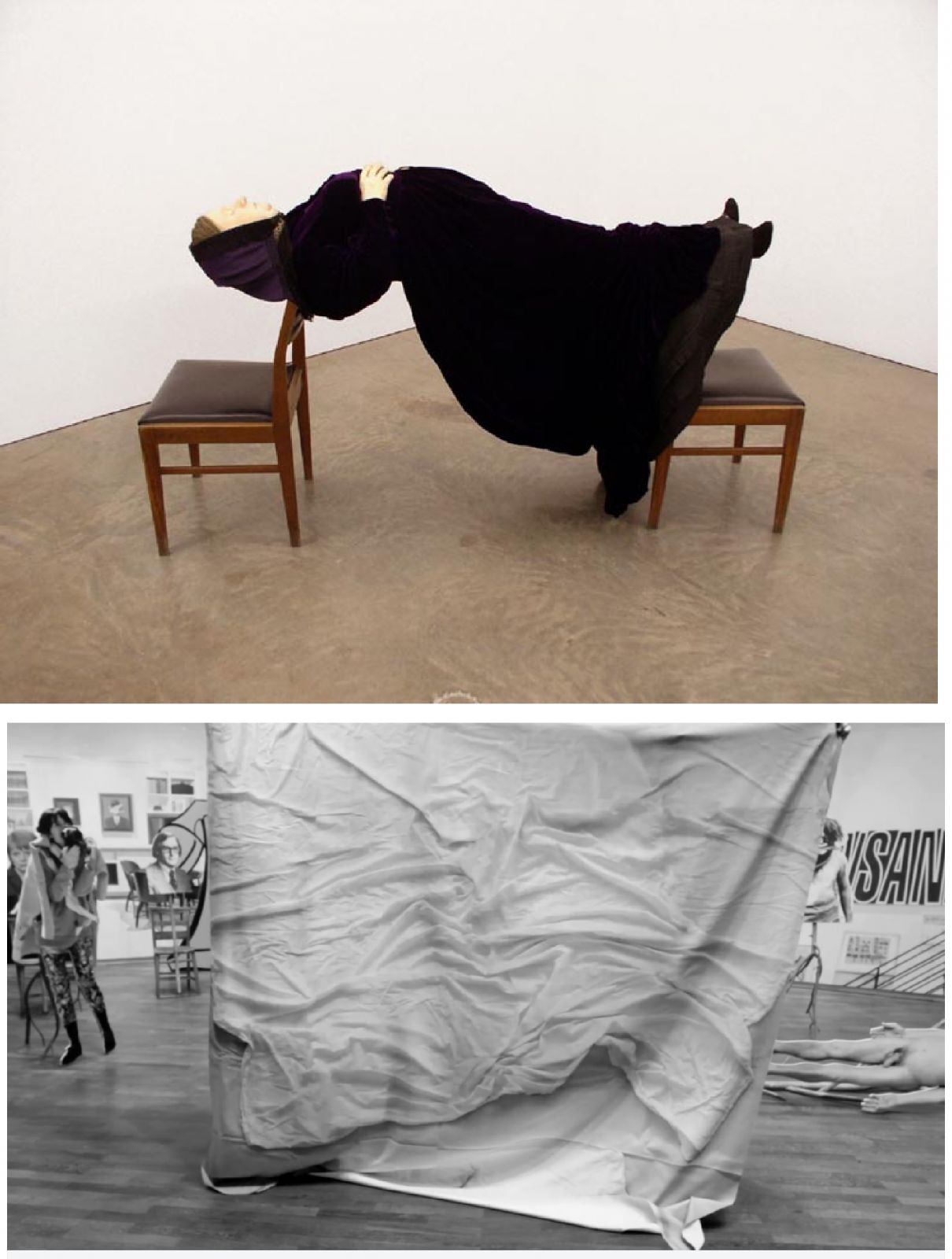
24 | (top) Goshka Macuga’s Madame Blavatsky, (2007) carved wood, fiberglass, clothes and chairs; (Source: Saatchi Gallery); (bottom) Screengrab from the Vimeo upload of the performance-film Preparatory Notes for a Chicago Comedy, Scene Three (Aby Warburg on Art, Money and Politics): the “curtain call” of Chicago Comedy, between the Goshka Macuga cutout (left) and Dead Dad (right).
The artist has compromised his artistic integrity and yet he has also infiltrated the aesthetic psychology of his fiancé’s uncle by gifting a painting that contains a kernel of his perversity, his “modern stuff,” his “morbidity” (Gombrich [1979] 1986, 94), his death as an artist. The uncle will generally grow accustomed to this “embedded” perversion by living with it day-after-day and it will influence him subliminally. But the moment that the world is revolutionized to find such marks beautiful, the artist’s role will shift. Therefore, if we are to follow Gombrich in his assertion that the “idealism” he calls “progressive” shares a “bias for impressionism and realism” (Gombrich [1979] 1986, 93) it only does so ironically. Indeed, Warburg’s ironic idealism is exemplified by the fact that the playlet seems to end exactly where it begins: with the same “confused scribblings” “disfigured” with the addition of a “meticulous” central figure” that began the debate (Gombrich [1979] 1986, 93 - 94). Nothing changes because the painter simply provides Uncle Eduard with another version of the Zorn print that initially provoked their debate. The only difference between the beginning and the end of the playlet is that the artist has managed to get Uncle Eduard to accept the image he earlier railed against (Fig. 22 and 23).
How about Macuga and Roelstraete? Do they identify with the figures of the artist and curator that they caricature in cutouts of themselves in the Chicago Comedy? The Macuga cut-out (“Hello, my name is Goshka Macuga. I am the artist and I like to be embedded”) plays the new-Luddite who recites that her artist’s “spirit” is destroyed by her cell phone; the Roeslstraete cut-out (“Hello, my name is Dieter Roelstraete, I am the curator and I also like to be in bed”) plays the curator for whom art does not provide solutions but only poses further questions (Macuga and Roelstraete, Scene Two and Scene Three, 2013).
Both positions are caricatured representations of statements commonly associated with artists and curators in contemporary art. Furthermore, the artist and the curator also serve as doubling redoubling mirror images of each other (the garment-covered introverted Macuga cut-out hunched over her camera, announces, “I am the artist and I like to be embedded” while the extended extroverted body cut-out of the splay-limbed Roelstraete proclaims, “I am the curator and I also like to be in bed”: the curator explains the artist, and the artist illustrates the ideas of the curator, but the two fundamentally misunderstand each other.
The relations between artist and curator repeat the mirror dance between the Chicago Comedy’s ever-present pair of dancing twins (Macuga and Roelstraete, Preface, 2013): the mirror dance of the twins is staged between the cut-outs of the iconic Hopi Indian Study #28, 1924. Photographer Unknown, photograph (also known to historians who have written about Warburg’s work as “the [serpent] ritual transformed into a tourist attraction” (P-A. Michaud 2004, 224) and the Warburg wearing a Hemis Kachina mask snapshot (Warburg’s box camera turned on him for a portrait) (Cestelli Guidi and Mann 1998, 143) which are in turn embedded between the cut-outs of the artist Macuga and the curator Roelstraete.
To answer our own question, we conclude with our own final embedding: a queer riddle masked as a joke posed as a concluding response. Macuga's Chicago Comedy ends with the actor who has played the German chancellor Angela Merkel, French ex-patriate artist Marcel Duchamp, the American artist Andrea Fraser, the Serbian artist Marina Abramovic, and Warburg’s Swiss-German psychiatrist (after a fictional sex-change) – Ludovica (not Ludwig) Binswanger – dragging this elliptical orbit of caricatures, a spiraling loop through politicians, artists, physicians and analysts, into the cut-out of artist Goshka Macuga, who proclaims: “I want to break free from this circle and become a square!” (Macuga and Roelstraete, Scene Three, 2013). A conventional bedsheet printed with the image of another tousled bedsheet is extended across the stage (and video frame) by the actors: at the curtain call of Macuga's Chicago Comedy performance-film only a heap of pulsating snakes remain, writhing in overlay-animation for the playlet’s final bow (Fig. 24, bottom).
Notes
[1] The German term Unvernunft “unreason” comes from Warburg’s phrase Kritik der reinen Unvernunft or “Critique of Pure Unreason”: in 1925, Aby Warburg defined the “enigma” of the “Sphinx Mnemosyne” as: “what is the significance of the function of individual and social memory?” and he characterized his work on this “enigma” as an attempt to gather materials for a “still unwritten Critique of Pure Unreason [Kritik der reinen Unvernunft]. See Sprung, 2015.
[2] Preparatory Notes for a Chicago Comedy was co-written by artist Goshka Macuga and curator Dieter Roelstraete. It was designed and choreographed by Macuga. The Chicago Comedy was produced as part of Macuga’s residency at the Museum of Contemporary Art Chicago (MCA, 2013) and debuted at the Berlin Biennale in 2014. The following paper is based on a performance-film created by Macuga from video of the Berlin performance. The performance-film was produced in an edition of five and was shot in high definition with overlay animation. It is made to be exhibited as a video projection. Special thanks to Goshka Macuga and Rudiger Shötte, Munich, for arranging access to the film and the script.
[3] For the letters cited in this passage, see the following records in the General Correspondence (GC) files of the Warburg Institute Archive (WIA): WIA GC 25848, Letter from Aby Warburg to Charlotte Warburg, January 30 1894; WIA GC 25971, Letter from Olga Warburg to Aby Warburg, February 9 1894; WIA GC 25975, Letter from Olga Warburg to Aby Warburg, April 30 1894; WIA GC 26761, Letter from Aby Warburg to Mary Hertz, June 2, 1897.
[4] WC GC 26761. Letter from Aby Warburg to Mary Hertz, June 2, 1897.
[5] The Saturday Review, in which Shaw’s reviews were published, is in the holdings of the Warburg Institute Library. The library currently provides electronic access to issues from 1855 to 1938.
[6] WIA GC 25848, Letter from Aby Warburg to Charlotte Warburg, January 30, 1894.
[7] WIA GC 26761, Letter from Aby Warburg to Mary Hertz, January 2, 1897.
[8] All quotes from the script are from a copy provided to the author by Rudiger Shötte, Munich, and Goshka Macuga. The script of the Preparatory Notes for a Chicago Comedy was published with Macuga’s drawings in Gagarin, Vol. 29, (2014).
[9] See Zumbusch quoted in Johnson 2012, 127.
[10] For the English translations of the New Mexico note used in the present essay, see Gombrich [1970] 1986, 91. It is important to note that some of Gombrich’s translations of Warburg’s terms (i.e. “corporal introjection” for Hinein[Um]verleibung) are problematic because they create associations with Ferenczian, Freudian and Kleinian psychoanalysis that should be discussed at greater length; unfortunately, this cannot be addressed in the present essay. I address this interesting issue about the translations in my dissertation where an extended version of the present essay is featured as a chapter.
[11] A. Warburg quoted in G. Macuga and D. Roelstraete, 2013, Scene One. Quotation from A. Warburg [1923] 1939. 292.
[12] The Grundlegende Bruchstücke was first titled Grundlegende Bruchstücke zu einer monistischen Kunstpsychologie (Foundational Fragments for a Monistic Psychology of Art) and then retitled Grundlegende Bruchstücke wu einer prag,atischen Ausdruckskunde (Foundational Fragments for a Pragmatic Theory of Expression). For more on this history, see S. Müller 2011. 107.
[13] Warburg was related to the famous cell biologist Otto Warburg whose discoveries regarding cell respiration earned him a Nobel Prize. To hear yeast cells “screaming”, visit: http://www.npr.org/templates/story/story.php?storyId=3859762 (Kestenbaum 2004).
[14] I came to understand this idea through work with Roberta Carreri, Julia Varley, Eugenio Barba and the Odin Teatret. Special thanks to the Odin Teatret and to the University of California Institute for Research in the Arts for sponsoring research at the Odin Teatret workshop in 2014.
[15] See Michaud 2004; Didi Huberman 2006; Johnson, 2012; Mazzucco [2006 – 2008] 2011; Pinotti, 2012; Sacco, 2013; VV.AA. [2001] 2012; VV.AA. 2012; Centanni et al. 2008.
[16] Warburg’s use of the word Einverseelung appears to be a reference to Nietzsche’s “physiological approach” to subjectivity, which “hypothesizes the subject as a process of mnemotechnical inscription and mental and physical ingestion (‘Einverseelung’ and ‘Einverleibung’)” (Siemens, 101). Note that this particular defintion of Nietzsche’s use of the term Einverseelung in the Genealogy of Morals cites Einverleibung alongside Einverseelung. Warburg uses Einverleibung as the first term in his New Mexico notes on “his psychological law” in 1896: “die “Verleibung” des sinnlichen Audrucks” (the “corporalization” of sensorial impressions” (Warburg [January 1896] 2011, 107).
[17] A similar drawing can be found in M. Wigman 1975, 176. The drawing featured in this image is from a review on a recent performance of Le Sacre du Printemps by the Bavarian State Ballet at Reithalle in Munich (I. Landgraf 2015).
[18] WIA GC 33963, Letter from Mary and Aby Warburg to Frede Warburg. November 4 1924.
[19] The terms ‘levels’ and ‘windows’ (and ‘expand’ in the following sentence) are drawn from use of raster graphics editors. A popular example of a raster graphics editor is Photoshop.
[20] To watch “Judge Doom’s Death”, visit Judge Doom’s Death, posted by MrMxyVillain. YouTube. 13 February 2011. Retrieved on March 4 2015.
[21] “Necropolitics [as theorized by Africanist philosopher Achille Mbembe, 2003] describes the way certain bodies are marked and marketed to as live, lively and deserving of life, wherein other bodies are seen as either already dead or destined toward death: their lives are of little consquence, whereas their deaths consolidate sovereign power”, (Martin-Baron, 51).
[22] Two editions of Allen Jones’ series sold at auction in 2012 and 2013 repsectively: the first at Sotheby’s for 2.6 million BP and the second at Christie’s for 2.2 million BP (Venning 2014; Reyburn 2014).
[23] Sosia is the servant character in Plautus’ Amphitryon: in this comedy, the slave can be considered the double of the master, and the master, the double of the slave. In the Amphitryon both master and slave are doubled, so that doubles have their own doubles. In Italian, sosia is used to refer to “double” or “clone”.
[24] Warburg writes about Emil Nolde’s animals, clouds and landscapes in WIA GC 18750, Letter from Aby Warburg to Carl Georg Heise, April 18 1927. Record of Warburg’s son Max Adolph receiving Nolde’s Prophet woodcut is documented in a letter from Mary Warburg to Aby Warburg on August 1 1921. WIA GC 35688.
Bibliography
- VV.AA. [2001] 2012
VV.AA, Tavole A, B, C. Iter per Labyrinthum. L’apertura tematica e l’architettura dell’Atlante, in “La Rivista di Engramma” 12, November 2001, (republished, November 2012). - VV.AA. 2012
VV. AA. [Numero speciale per celebrare 100 numeri di Engramma, Pensare per Immagini], in “La Rivista di Engramma” 100, October 2012. - Banchoff 1995
T. Banchoff, The Klein Bottle in Four Space, Thomas Banchoff’s Projects, Brown University, June 30, 1995. - Barale 2009
A. Barale, La Malinconia dell’Immagine: Rappresentazione e significato in Walter Benjamin e Aby Warburg, Firenze University Press, 2009. - Berardi 2011
F. Berardi, Time, Acceleration and Violence, “E-Flux Journal”, Vol.27 (September 2011). - Berardi 2014
F. Berardi, Absolute Capitalism, in Running Along the Disaster Workshop, Istanbul, Labor in Contemporary Art Research Collective and Otonom Publishing (12 February 2014). - Bracker 2014
A. Bracker, When paint stripper was thrown over Allen Jones’ Chair, “Royal Academy of Arts”, 26 November 2014. - Butler 1993
J. Butler, Bodies That Matter: On the Discursive Limits of “Sex”, New York 1993. - Bibb 1895
A. B. Bibb, The Salon of Munich (21 December 1895), “The American Architect and Building News”, Vol. L., (October – December 1895). - Bishop 2013
C. Bishop, 4. Displaying Research, “Still Searching”, FotoMuseum Winterthur, (October 11 2013). - Bishop 2014
C. Bishop, Radical Museology: Or, What’s Contemporary in Museums of Contemporary Art?, Cologne 2014. - Bobb 2015
M. Bobb, Azealia Banks sits on Naked Women, in GypJaQ’s Blown Away video, “MTV News” (March 27, 2015). - Carlyle 1840
T. Carlyle, On Heroes, Hero-Worship, and the Heroic in History, London 1840. - Centanni et al. 2008
M. Centanni, K. Mazzucco, G. Bordignon, K. Forster, Introduzione ad Aby Warburg ed all’Atlante della Memoria, Milano 2008. - Cestelli Guidi and Mann 1998
B. Cestelli Guidi and N. Mann (eds.), Photographs at the Frontier: Aby Warburg in America. 1895 – 1896, London, The Warburg Institute, 1998. - Cieri Via [1994] 2014
C. Cieri Via, Nei Dettagli Nascosto: Per una storia del pensiero iconologico, Roma 2014. - Dali and Descharnes, [1927-1933] 1998
S. Dali and R. Descharnes. Oui: The Paranoia-Critical Revolution: Writings, 1927 – 1933, Ann Arbor: Exact Change, 1998. - Dâmaso, 2013
M. Damaso, Images against Images: On Goshka Macuga’s The Nature of the Beast, in C. Taban (ed.), Meta- and Inter-Images in Contemporary Visual Art and Culture, Leuven University Press 2013. - de Baere 2008
B. de Baere, The Gentle Art of Breeding Monsters: Bjarne Melgaard and the Political, “Afterall” 17, Spring 2008. - DeVereBrody 1998
J. DeVereBrody, Impossibile Purities: Blackness, Femininity and Victorian Culture, Durham, Duke University Press, 1998. - Didi-Huberman 2006
Didi-Huberman, L’Immagine Insepolta: Aby Warburg, la Memoria dei Fantasmi e la Storia dell’Arte, Torino 2006. - Duchamp [1912 - 1920] 1973
M. Duchamp, Chercher à discuter la durée plastique from Speculations in Manuscript Notes 1912 - 1920 from The Writings of Marcel Duchamp, in M. Sanouillet and E. Peterson (eds.), New York 1973. - Elsaesser and Hagener 2015
T. Elsaesser and M. Hagener, Film Theory: An Introduction Through the Senses, New York 2015. - Fanon 1967
F. Fanon, Black Skin, White Masks, New York 1967. - Gavin 2013
F. Gavin, Q&A/Art: Bjarne Melgaard, “Dazed”, 2013. - Ghelardi 2012
M. Ghelardi, Aby Warburg: La Lotta per lo Stile, Torino 2012. - Gombrich [1970] 1986
E. H. Gombrich, Aby Warburg: An Intellectual Biography, Oxford [1970] 1986. - Griffin 2006
J. Griffin, Goshka Macuga, “Frieze Magazine” Issue 100, June-August 2006. - Grotowski [1986] 2004
J. Grotowski, Conference in Liège (1986) as quoted, in T. Richards, At Work with Grotowski on Physical Actions, London [1993] 2004. - Grotowski [1989, 1990] 2004
J. Grotowski, From the Theatre Company to Art as Vehicle (1989, 1990), in T. Richards, At Work with Grotowski on Physical Actions, London [1993] 2004. - Hunt 1999
J. Hunt, Paranoid, Critical, Methodical: Dali, Koolhaas and…, in G. E. Marcus (ed.), Paranoia within Reason: A Casebook on Conspiracy as Explanation, University of Chicago Press, 1999. - Johnson 2012
C. Johnson, Memory, Metaphor and Aby Warburg’s Atlas of Images, Cornell University Press, 2012. - Johnston 2013
A. Johnston, Misfelt Feelings: Unconscious Affect Between Psychoanalysis, Neuroscience and Philosophy, in C. Malabou and A. Johnston (eds.), Self and Emotional Life: Philosophy, Psychoanalysis and Neuroscience, New York, Columbia University Press, 2013. - Jones 2014
J. Jones, Why. There’s Nothing Racist about the “Racist Chair”, “The Guardian”, Sculpture, January 21, 2014. - Jules-Rosette 2007
B. Jules-Rosette, Josephine Baker, in Art and Life: The Icon and the Image, Chicago, University of Illinois Press, 2007. - Kandinsky [1926] 2015
W. Kandinsky, Tanzkurven: Zu den Tänzen der Palucca, “Das Kunstblatt,” Potsdam, vol. 10, 3, 1926; in Wasily Kandinsky’s “Dance Curves: On the Dances of Palucca (1926), in E. Weitz and E. Roubinek (eds.), The Bauhaus in German History, in Documents and Images, German Historical Institute, Washington DC, 2015 (Web). - Kestenbaum 2004
D. Kestenbaum, Researchers Listen to Yeast Cells. From All Things Considered on National Public Radio (NPR), August 19, 2004 (Podcast). - Koolhaas [1978] 1994
R. Koolhaas, Delirious New York: A Retroactive Manifesto for Manhattan, New York 1994. - Kroll 2012
A. Kroll, Clint Eastwood’s Bizarre “Empty Chair Obama” Speech at the GOP Convention, Mother Jones, August 30, 2012. - Landgraf 2014.
I. Landgraf, Today’s Trash and Tradition Warmed Up. “Landgraf on Dance” (Blog), DanceViewTimes, 27 June 2014 (Web). - Lev 2008
L. Lev, Next: Vampiric Epistolarity, Haunted Cyberspace and Dennis Cooper’s Positively Mutant Multimedia Offsprint, in P. Hegarty and D. Kennedy (eds.), Dennis Cooper: Writing at the Edge, Sussex Academic Press 2008. - Lidbury 2014
O. Lidbury, Photo of Dasha Zhukova posing on black woman bondage chair causes offence, “Telegraph” Fashion, January 21, 2014. - Macuga and Roelstraete, Preface, 2013
G. Macuga and D. Roelstraete, Preface, in Preparatory Notes for a Chicago Comedy, Unpublished Script, 2013. - Macuga and Roelstraete, Scene One, 2013
G. Macuga and D. Roelstraete, Scene One: Aby Warburg on Technology, in Preparatory Notes for a Chicago Comedy, Unpublished Script, 2013. - Macuga and Roelstraete, Scene Two, 2013
G. Macuga and D. Roelstraete, Scene Two: Aby Warburg on Madness and Ritual, in Preparatory Notes for a Chicago Comedy, Unpublished Script, 2013. - Macuga and Roelstraete, Scene Three, 2013
G. Macuga and D. Roelstraete, Scene One: Aby Warburg on Art, Money and Politics, in Preparatory Notes for a Chicago Comedy, Unpublished Script, 2013. - Mazzucco [2006 – 2008] 2011.
K. Mazzucco, Mnemosyne. Il Nome della Memoria, in Quaderni Warburg Italia 4-5-6, Siena (2006-2008), 2011. - MCA 2013-2014
G. Macuga, Preparatory Notes for a Chicago Comedy, “Museum of Contemporary Art Chicago”, Blog (April 2013 to May 2014), Web (March 4, 2015). - McKay 2015
S. McKay, No Neuron is an Island: A Neuroaesthetic Inquiry into Omer Fast’s Mimetic Interactions, in A. Scarinzi (ed.), Aesthetics and the Embodied Mind: Beyond Art Theory and the Cartesian Mind-Body Dichotomy, Dordrecht 2015. - Michaud 2004
P-A. Michaud, Aby Warburg and the Image in Motion, in S. Hawkes (trans.), New York 2004. - Mainberger 2014
S. Mainberger, “Tragödie der Verleibung” Zu Aby Warburgs Variante der Einfühlungstheorie, in H. Schmidgen und T. Wilke (eds.), Gefühl und Genauigkeit: Empirische Asthetik um 1900, Munich 2014. - Martin-Baron 2014
M. R. Martin-Baron, (Hyper/in)visibility and the militare corps(e), in J. Haritaworn, A. Kunstman and S. Posocco (eds.), Queer Necropolitics, Abingdon 2014. - Müller 2011
S. Müller, Das Wasserzeichen des Gedankens, in S. Muller (ed.) M. Ghelardi and G. Targia (trans.), A. Warburg, Frammenti sull’Espressione: Grundlegende Bruchstücke zu einer pragmatischen Ausdruckskunde, Pisa 2011. - Mulvey [1973] 2002
L. Mulvey, Fears, Fantasies and The Male Unconscious; or, You Don’t Know What’s Happening, Do You, Mr. Jones?, in “Spare Rib” (1973), quoted in Pollock, op. cit. 2002. - Museen Dahlem 2015
Museen Dahlem from “Museen Dahlem. Staatliche Museen zur Berlin” 2015. - Ortiz 2012
E. Oritz, Is this an anti-Obama lynching? Texas man hangs chair from tree inspired by Clint Eastwood speech, “New York Daily News” September 12, 2012. - Oxford 2015
Energetics in Oxford Dictionaries, Retrieved on March 20, 2015. - Palver 2013
W. Palver, Sacrificial Cults as ‘the Mysterious Centre of Every Religion’: A Girardian Assessment of Aby Warburg’s Theory of Religion, in J. Meszaros and J. Zachhuber (eds.), Sacrifice and Modern Thought, Oxford University Press, 2013. - Pinotti 2012
A. Pinotti, Memorie del Neutro. Morfologia dell’Immagine in Aby Warburg, Milano 2012. - Pollock 2002
G. Pollock, Nude Bodies. Displacing the Boundaries between Art and Pornography, in S. Sweeney and I. Hodder (eds.), The Body, Cambridge University Press, 2002. - Reyburn 2014
S. Reyburn, Basquiat Top $127 Million Auction at Christie’s, “Bloomberg Businessweek” February 13, 2014. - Riaz 2014
H. Riaz, The ‘racist chair’ is not shocking but a cruel reminder of the art world’s views, “The Guardian” January 22, 2014. - Richter 1914
E. H. Richter, Print. A Brief Review of their Technique and History, Cambridge 1914. - Roberts 2006
S. Roberts, King of Infinite Space. Donald Coxeter, The Man Who Saved Geometry, New York 2006. - Sacco 2013
D. Sacco, Mito e Teatro. Il Principio Drammaturgico del Montaggio, Milano 2013. - Shaw 1895
G. B. Shaw, Two Plays, “The Saturday Review of Politics, Literature, Science and Art”, Vol. 79., (June 8,1895). - Shaw 1895
G. B. Shaw, Duse and Bernhardt, “The Saturday Review of Politics, Literature, Science and Art”, Vol. 79., (June 15, 1895). - Siemens 2013
H. W. Siemens, Reassessing Radical Democratic Theory in the Light of Nietzsche’s Ontology of Conflict, in K. A. Pearson (ed.), Nietzsche and Political Thought, London 2013. - Sprung 2015
J. Sprung, A Few Comments on Aby Warburg’s phrase: Kritik der reinen Unvernunft, in “La Rivista di Engramma” 125, March 2015. - Venning 2014
A. Venning, The Man Who Turned Half-Naked Women into Chairs – and Called it Art, “Daily Mail” January 23, 2014, - Walzer 2014
S. Walzer, Russian socialite Sparks Outrage with ‘racist chair’ photograph, “The Guardian” January 21, 2014. - WIA GC
Warburg Institute Archive, General Correspondence. - Warburg [April 1891] 1891
A. Warburg, <142>187. April 7 1891, in S. Muller (ed.), M. Ghelardi and G. Targia (trans.), Frammenti sull’Espressione: Grundlegende Bruchstücke zu einer pragmatischen Ausdruckskunde, Pisa 2011. - Warburg [1893] 1933
A. Warburg, Sandro Botticellis “Geburt der Venus” und “Frühling” (1893), in G. Bing (ed.), Die Erneuerung der Heidnischen Antike, Gesammelte Schriften, Band I, Leipzig 1932. - Warburg [1893] 1999
A. Warburg, Sandro Botticelli’s “Birth of Venus” and “Spring” (1893), in K. Forster (ed.), D. Britt (trans.), Renewal of Pagan Antiquity: Contributions to the Cultural History of the European Renaissance, Los Angeles1999. - Warburg [January 1896] 2011
A. Warburg, 299. January 27 1896, Santa Fé, New Mexico, Palace Hotel, in S. Muller (ed.), M. Ghelardi and G. Targia (trans.), Frammenti sull’Espressione: Grundlegende Bruchstücke zu einer pragmatischen Ausdruckskunde, Pisa 2011. - Warburg, [March 23 1896] 2011
A. Warburg, 305. March 23 1896, San Francisco, in S. Muller (ed.), M. Ghelardi and G. Targia (trans.), Frammenti sull’Espressione: Grundlegende Bruchstücke zu einer pragmatischen Ausdruckskunde, Pisa 2011. - Warburg, [March 25 1896] 2011
A. Warburg, 306. March 25 1896, San Francisco Public Library, in S. Muller (ed.), M. Ghelardi and G. Targia (trans.), Frammenti sull’Espressione: Grundlegende Bruchstücke zu einer pragmatischen Ausdruckskunde, Pisa 2011. - Warburg [1900] 2012
A. Warburg and A. Jolles, Ninfa Fiorentina, Fol. 8., in C. Johnson, op. cit. 2012. - Warburg [1905] 1933
A. Warburg, Dürer und die Italienische Antike (1905), in G. Bing (ed.) Die Erneuerung der Heidnischen Antike, Gesammelte Schriften, Band II, Leipzig 1932. - Warburg [1905] 1999
A. Warburg, Dürer and Italian Antiquity (1905), in K. Forster (ed.), D. Britt (trans.), Renewal of Pagan Antiquity: Contributions to the Cultural History of the European Renaissance, Los Angeles 1999. - Warburg [1907] 1933
A. Warburg, Dürer und die italienische Antike (1905), in G. Bing (ed.), Die Erneuerung der Heidnischen Antike, Gesammelte Schriften, Band II, Leipzig 1932. - Warburg [1907] 1999
A. Warburg, Francesco Sassetti’s Last Injunction to His Sons (1907), in K. Forster (ed.), D. Britt (trans.), Renewal of Pagan Antiquity: Contributions to the Cultural History of the European Renaissance, Los Angeles 1999. - Warburg [1912] 1933
A. Warburg, Francesco Sassettis letztwillige Verfügung, in G. Bing (ed.), Die Erneuerung der Heidnischen Antike, Gesammelte Schriften, Band I, Leipzig 1932. - Warburg [1912] 1999
A. Warburg, Italian Art and International Astrology in the Palazzo Schifanoia, Ferrara (1912), in K. Forster (ed.), D. Britt (trans.), Renewal of Pagan Antiquity: Contributions to the Cultural History of the European Renaissance, Los Angeles 1999. - Warburg [1918] 1933
A. Warburg, Das Problem liegt in der Mitte in G. Bing (ed.) Die Erneuerung der Heidnischen Antike. Gesammelte Schriften. Band I. Leipzig: B. G. Teubner, 1932. - Warburg [1918] 1999
A. Warburg, The Problem In Between (1918), in K. Forster (ed.), D. Britt (trans.), Renewal of Pagan Antiquity: Contributions to the Cultural History of the European Renaissance, Los Angeles 1999. - Warburg [1920] 1933
A. Warburg, Heidnisch-antike Weissagung in Wort und Bild zu Luthers Zeiten (1920), in G. Bing (ed.), Die Erneuerung der Heidnischen Antike, Gesammelte Schriften, Band I, Leipzig 1932. - Warburg [1920] 1999
A. Warburg, Pagan-Antique Prophecy, in Words and Images in the Age of Luther (1920), in K. Forster (ed.), D. Britt (trans.), Renewal of Pagan Antiquity: Contributions to the Cultural History of the European Renaissance, Los Angeles 1999. - Warburg [1923] 2004
A. Warburg, Memories of Indian Books, March 16, 1923, from Memories of a Journey Through the Pueblo Region: Unpublished Notes for the Kreuzlingen Lecture on the Serpent Ritual (1923), in P-A, Michaud, 2004. - Warburg [1923] 1939
A. Warburg, A Lecture on Serpent Ritual (1923), Journal of the Warburg Institute, Vol. 2, April 4, 1939. - Warburg [1929] 2000
A. Warburg, Einleitung (1929) from M. Warnke and C. Brink (eds.), Berlin, Akademie Verlag, 2000, in Temi di Ricerca: Warburg e Mnemosyne, “La Rivista di Engramma” 100, 2012. - Warburg [1929] 2008
A. Warburg, Giordano Bruno, in M. Ghelardi and G. Targia (eds.), Cassirer Studies I (2008). - Waxman 2012
S. Waxman, Barack Obama Tweets Response to Clint Eastwood RNC Empty Chair Speech “The Wrap”, August 30, 2012. - Weller 1999
S. Weller, Decomposition: Georges Bataille and the Language of Necrophilia, in A. K. Schaffner, S. Weller (eds.), Modernist Eroticisms: European Literature After Sexology, Hampshire, 2012. - Wigman 1975
M. Wigman, The Mary Wigman Book, Wesleyan University Press, 1975, 85-86. - Wyatt 2014
D. Wyatt, Russian Artist Publishes Gay Chair, in Protest Against Dasha Zhukova photograph, “The Independent”, January 29, 2014. - Zumbusch [2004] 2012
C. Zumbusch, Wissenschaft in Bildern: Symbol und dialektisches Bild in Aby Warburgs Mnemosyne-Atlas und Walter Benjamins Passagen-Werk (2004), in C. Johnson, op. cit. 2012. - Zöllner 2010
F. Zöllner, ‘Eilig Reisende’ im Gebiete der Bildvergleichung: Aby Warburgs Bilderatlas ‘Mnemosyne’, “Marburger Jahrbuch für Kunstwissenschaft” 37 Bd, 2010.
Abstract
When Aby Warburg completed his dissertation in 1893 he began working on the fragmentary draft for a playlet titled Als ein junges Mädchen die Duse sehen wollte (When a well-brought up girl wanted to see a Duse performance, 1893 – 1894). The present essay delays going immediately to the Warburg Institute archive to research this playlet. Instead, it lingers in a playful moment of desirous anticipation for the purpose of engaging Duse’s so-called “intellectual work” with “natural” gestures in a dialogue about how Warburg’s Pathosformel (pathos formulae) has evolved in twenty-first century semio-capitalism. Reading through Warburg’s correspondence about Italian actress Eleonora Duse and researching reviews that paired Duse in a performance polarity with French Actress Sarah Bernhardt, we enjoy the delay of ‘Wanting to see Duse’ to conjure Duse to our side so she can accompany us in watching another amateur playlet: a contemporary comedy (2013 and ongoing) produced in a residency program at the Museum of Contemporary Art Chicago and debuted at the Berlin Biennale (2014). Preparatory Notes for a Chicago Comedy (2013 and ongoing) by Polish artist Goshka Macuga and Belgian curator Dieter Roelstraete, is “playful play” with another of Warburg’s experiments in amateur playwriting - a humorous sketch titled Hamburg Kunstgesprache (Hamburg Art Conversations, 1896). Unlike the Duse playlet, Hamburg Art Conversations was completed and performed. Warburg cast family members, and himself, in various roles on the occasion of a New Year’s Eve party. Watching Chicago Comedy through what George Bernard Shaw called Duse’s greatness in acting the “interval,” results in a new way of looking at Plate C in Mnemosyne (1924 – 1929): this new reading relates Plate C back to three notes that Warburg wrote for his Grundlegende Bruchstucke (Foundational Fragments, 1888 - 1905) while traveling in North America (1895 – 1896). Finally, thinking about Chicago Comedy in relation to Warburg’s Grundlegende Bruchstucke definition of the kunstlerische Akt (“‘artistic’ act”) and Verleibung [corporalization] also poses new questions about introjection and object-relations in psychoanalysis and neuroscience, sculpture and performance, between a three dimensional hunk of flesh called the human, animated objects taking subject and object positions, and the abyssal one-dimensional wormholes of internet hyperspace.
keywords | Mnemosyne Atlas; Warburg; Theatre; Performance; Gesture; Artistic act; Duse; Bernhardt; Goshka Magusa; Notes for Chicago Comedy.
To cite this article: E.V. Bovino, Wanting to See Duse. Or, on Goshka Macuga's Preparatory Notes for a Chicago Comedy (2013 - ongoing) inspired by Aby Warburg-as-Amateur-Playwright (1893-1897), “La Rivista di Engramma” n. 130, ottobre/novembre 2015, pp. 23-96 | PDF